Stop ’N’ Swop: An Explanation and Retrospective

Navigation:
Introduction
Stop ’N’ Swop in Banjo-Kazooie
– The Discovery of the Ice Key
– Mumbo-Jumbo’s Secret Pictures
– Rarewhere’s Banjo-Kazooie Rumour Mill
– The Discovery of the Stop ’N’ Swop Menu
– Rarewhere’s Banjo-Kazooie Tepid Seat
Stop ’N’ Swop in Banjo-Tooie
– The Banjo-Kazooie Game Paks
– Unlocking the Stop ’N’ Swop Rewards
– Initial Reaction to Stop ’N’ Swop
– Captain Blackeye’s Intended Mission & Purpose
Stop ’N’ Swop Revelations
– The Sandcastle Codes
– Discoveries in Banjo-Tooie
– Connection to Donkey Kong 64
Developer Insight into Stop ’N’ Swop
– The Stop ’N’ Swop Patent
– Nintendo Technical Support & Donkey Kong 64
– The Six Rare Stop ‘N’ Swop Titles/Paul Machacek
– Rare Revealed: The Making of Banjo-Kazooie
Stop ’N’ Swop in Banjo-Kazooie: Nuts & Bolts
– Banjo-Kazooie XBLA Connections
– Banjo-Tooie XBLA Connections
– Stop ’N’ Swop II
Easter Eggs and Allusions to Stop ’N’ Swop
– Proposed Solution in Grabbed by the Ghoulies
– Stop ’N’ Swop Easter Eggs in Other Games
Conclusion to Stop ’N’ Swop
– Remaining Unsolved Mysteries and Afterword
You’d be very hard-pressed to find a more notorious gaming mystery as enigmatic as ‘Stop ’N’ Swop‘; it could be argued that the feature has developed a life of its own outside of the games it was intended for, where online speculation and rumors have run rampant, granting the original titles a new lease on life in the process. Tackling the entire thing at once is a bit of a fools errand, as it can be difficult to know where to start, and where to separate fact from fiction, but we’ve undertaken that effort in order to provide the best documentation of gamings largest mystery in one place. Below you’ll find a comprehensive history of Stop ’N’ Swop from the thrill of the initial discovery, to the aftermath and remaining secrets that continue to foster wild theories to this day. We invite you to see just how deep this rabbit hole goes…
STOP ’N’ SWOP IN BANJO-KAZOOIE
Released in 1998, Banjo-Kazooie was Rare’s first attempt at creating a 3D platforming game after a string of critical and commercially praised titles before it. While it naturally found itself in competition with other similar games of the era, Banjo-Kazooie had a charm all of its own, and innovated with several ideas that have now become commonplace throughout the games industry.
One of these ideas was the concept of having a 3D Platformer tasking the player with collecting a wide assortment of quest items which would add an element of exploration, and throughout the game this sense of progress would push players onward to collect everything they could possibly get their hands on.
With this in mind, something extremely curious would occur in the fifth level, Freezeezy Peak, where players would enter an area called ‘Wozza’s Cave’ and be able to spot an Ice Key through an alcove, spinning tantalizingly out of reach. The alcove had been effectively blocked off by a thick pane of ice, serving as something of a window for the uncollected collectible.
The first reaction most players had was that something needed to be done in the level to allow access to the Ice Key, but after managing to finish every task that could be found in Freezeezy Peak, the Ice Key continued to spin in place unabated.
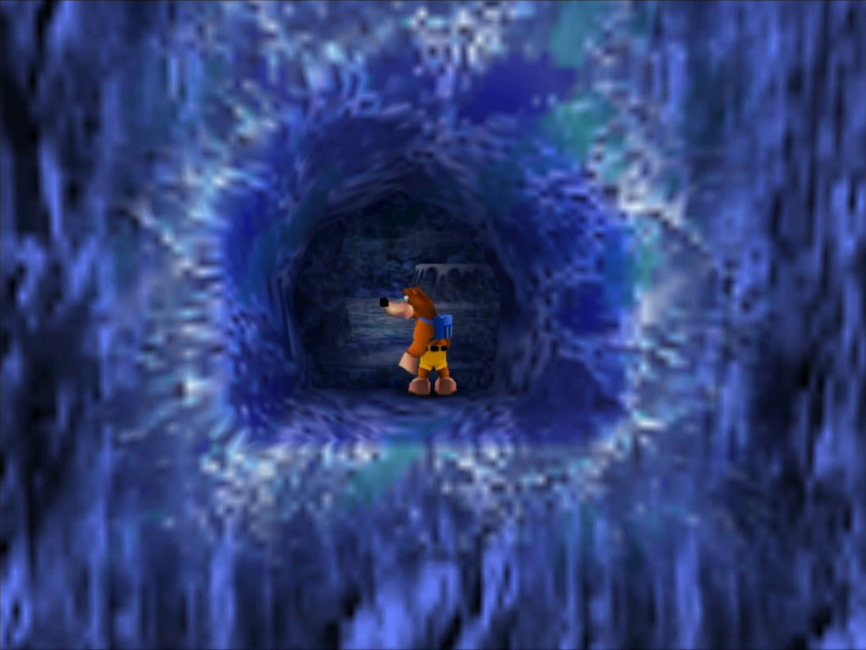
![]()
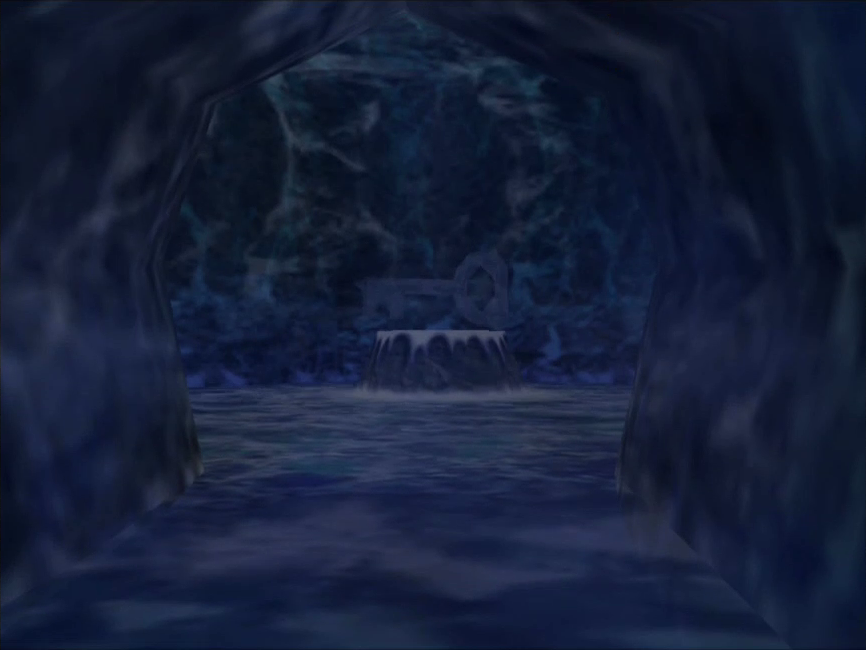
![]()
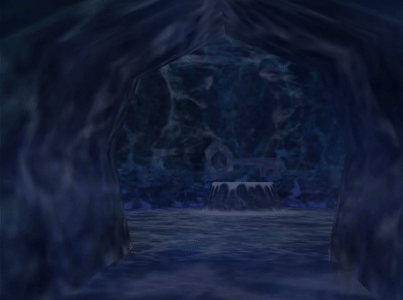
![]()
![]() [View Fullsize Image]
[View Fullsize Image]![]() [View Fullsize Image]
[View Fullsize Image]![]() [View Fullsize Image]
[View Fullsize Image]
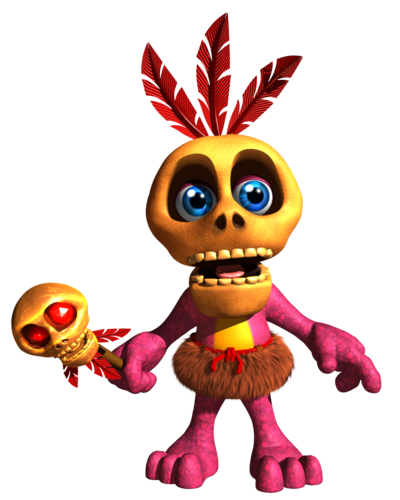 Players who managed to leave the Ice Key behind to continue on their adventure would face off against the games antagonist, Gruntilda, atop her tower. Defeating the Witch would see her tumbling off the escarpment to her deserved end; buried underneath a massive boulder that had followed her down. With the story finished, players would have a chance to sit back and enjoy the credits – however, there was a bonus ending afterwards which could only be viewed by collecting everything in the game (save for the Ice Key of course). Regardless of the progress, the cutscene would start off the same; Banjo, Kazooie, Bottles and Tooty were relaxing on a beach after their long journey, while Mumbo-Jumbo, the games Shaman, was climbing a coconut tree just overhead. After discussing the events of the game amongst themselves, Mumbo would taunt the duo below, revealing a handful of pictures of things player’s had missed, intended for the next game.
Players who managed to leave the Ice Key behind to continue on their adventure would face off against the games antagonist, Gruntilda, atop her tower. Defeating the Witch would see her tumbling off the escarpment to her deserved end; buried underneath a massive boulder that had followed her down. With the story finished, players would have a chance to sit back and enjoy the credits – however, there was a bonus ending afterwards which could only be viewed by collecting everything in the game (save for the Ice Key of course). Regardless of the progress, the cutscene would start off the same; Banjo, Kazooie, Bottles and Tooty were relaxing on a beach after their long journey, while Mumbo-Jumbo, the games Shaman, was climbing a coconut tree just overhead. After discussing the events of the game amongst themselves, Mumbo would taunt the duo below, revealing a handful of pictures of things player’s had missed, intended for the next game.
From this point, the cutscene would either end with Mumbo informing the player that they still had more to do if their file was less than 100%, or it would continue on to the secret ending if they had managed a perfect game.
Sliding down the coconut tree, Mumbo would reveal the name of the sequel, Banjo-Tooie and begin to show Banjo, and by extension the player, his collection of moving photographs:
The first photograph would begin on the second level, Treasure Trove Cove, where Banjo could be seen exploring the beach. The scene would be familiar to players until the Bear began paddling out to the sea where a non-descript rocky formation called ‘Sharkfood Island’ had risen from underneath the waves, revealing an entrance at its base. Venturing inside the secret area, the Bear and Bird would arrive at a large spire in its hollow interior, a series of alcoves working their way up to the top where a mysterious Pink Egg covered in question marks would spin at its center, waiting to be collected.
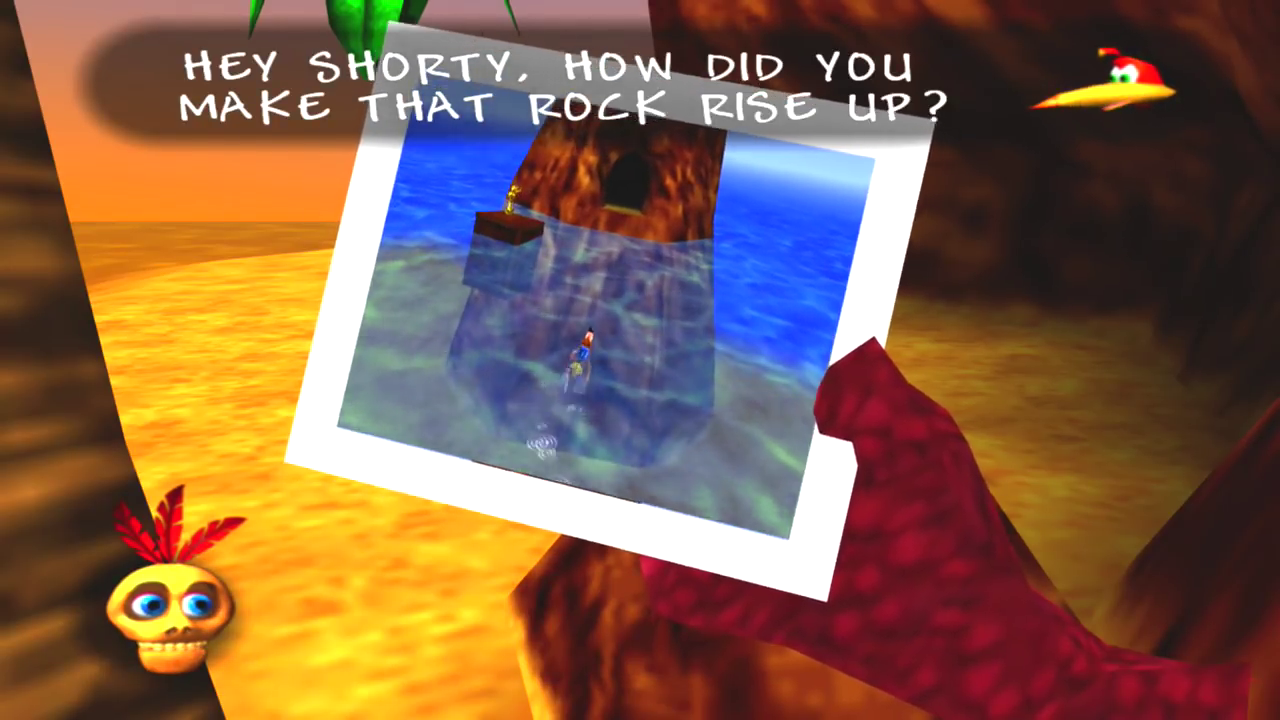
![]()
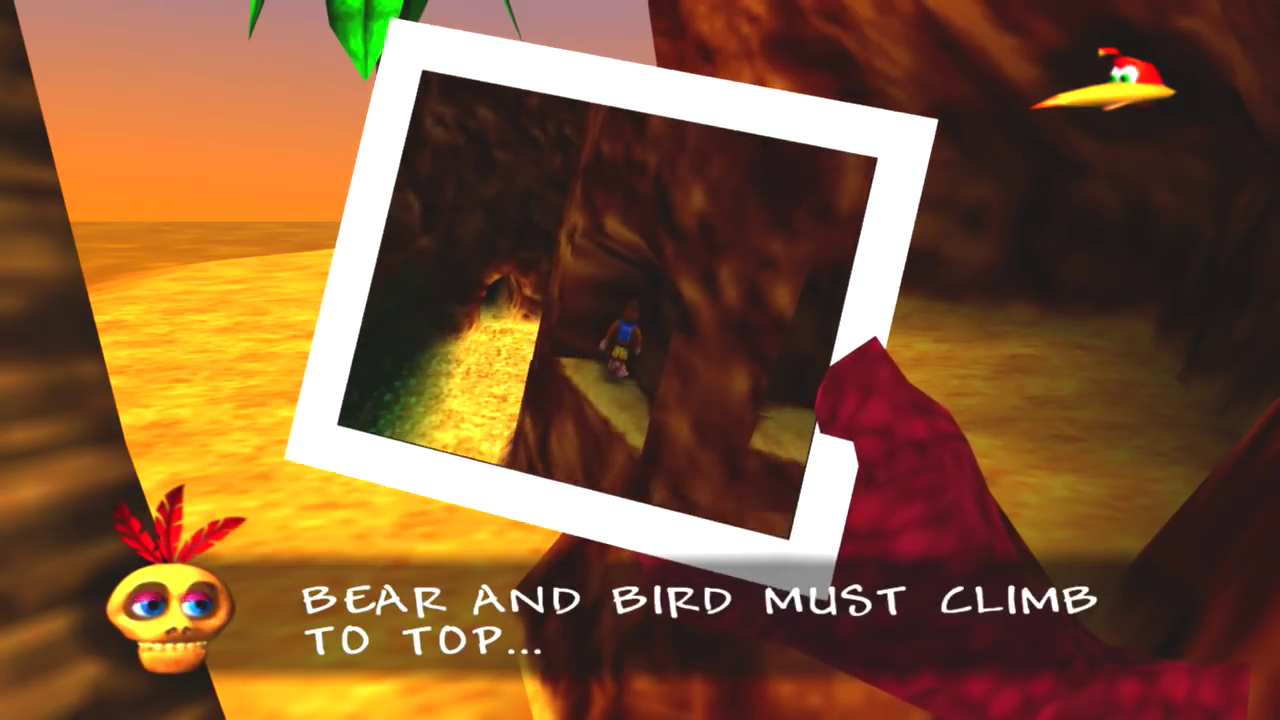
![]()
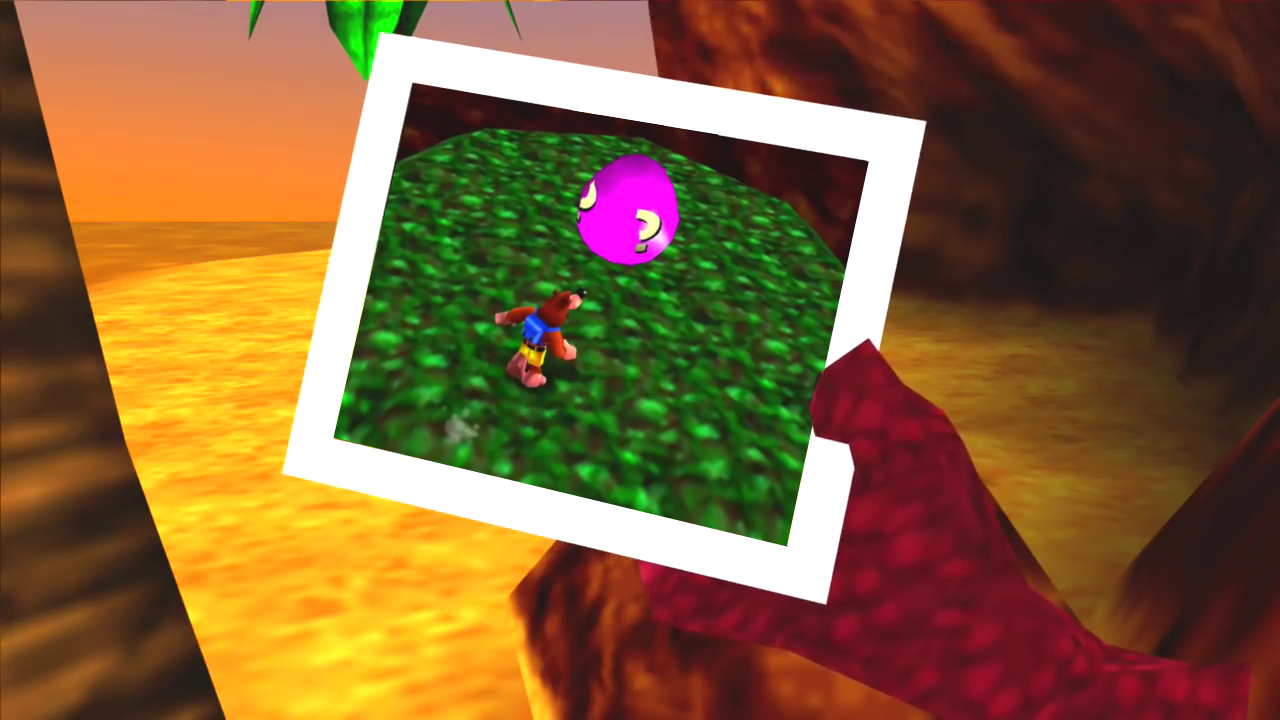
![]()
![]() [View Fullsize Image]
[View Fullsize Image]![]() [View Fullsize Image]
[View Fullsize Image]![]() [View Fullsize Image]
[View Fullsize Image]
Before this could be done however, Mumbo swapped out the photographs and presented his second offering – the view of Freezeezy Peak and laterally Wozza’s Cave sending a wave of new-found understanding with players that had encountered the Ice Key before. This time, the alcove ‘window’ in the cave was smashed, allowing the Banjo shown in the photograph to pass through unimpeded and stand in front of the illusive Key.
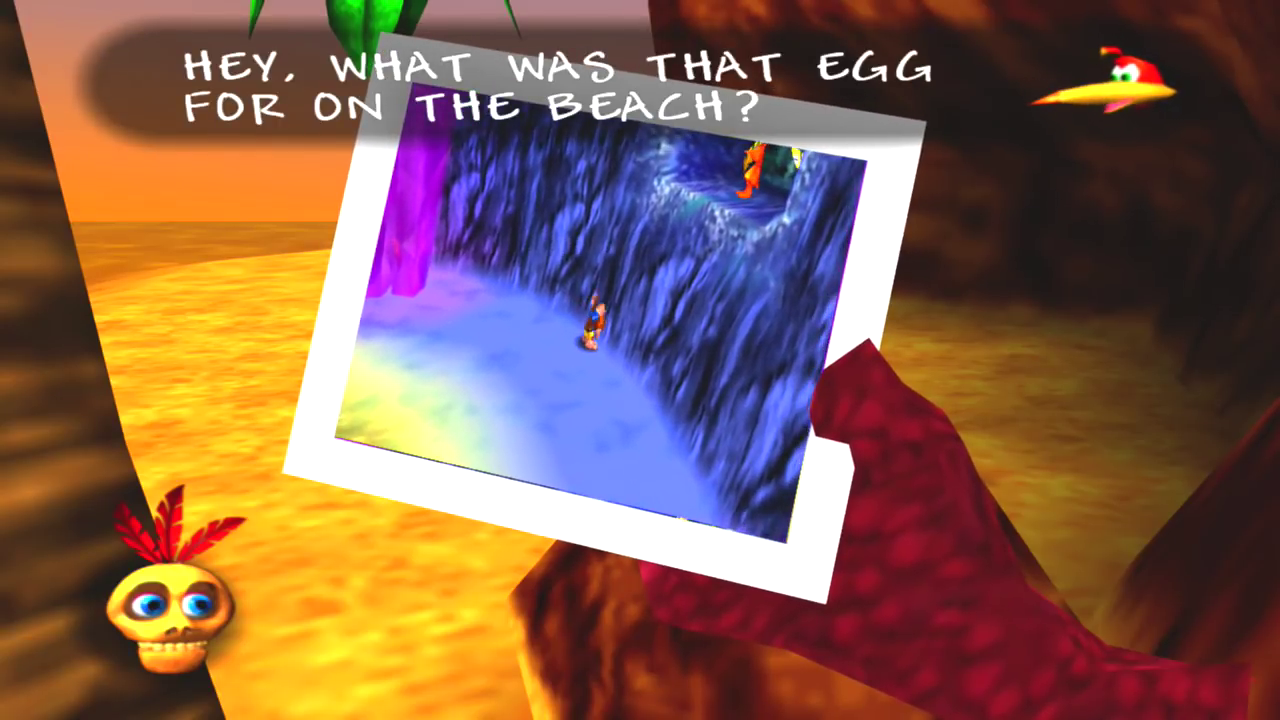
![]()
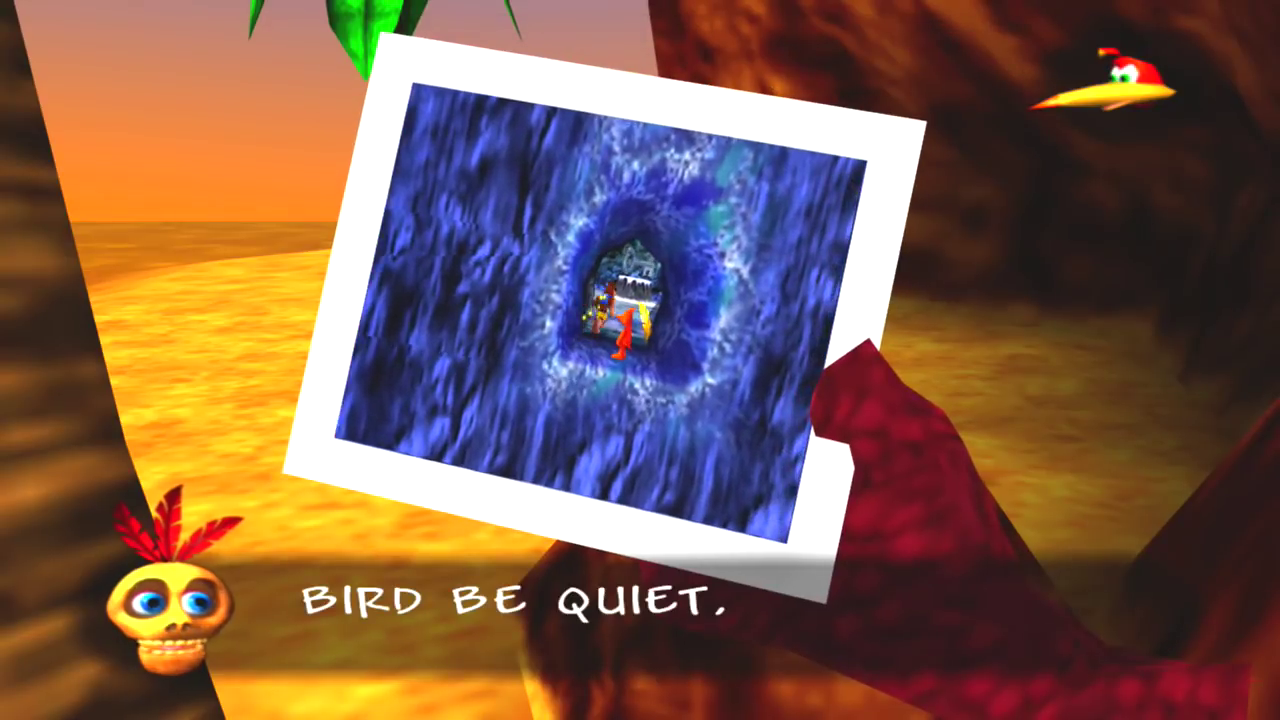
![]()
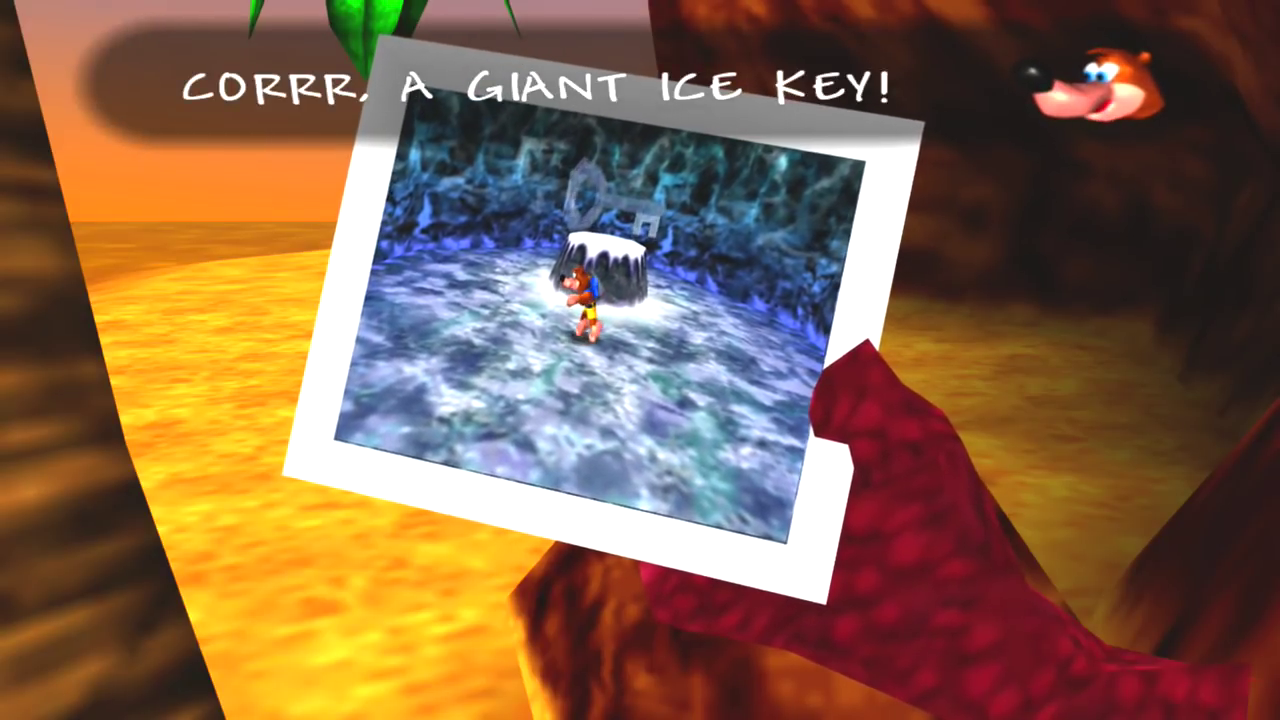
![]()
![]() [View Fullsize Image]
[View Fullsize Image]![]() [View Fullsize Image]
[View Fullsize Image]![]() [View Fullsize Image]
[View Fullsize Image]
One final moving photograph would conclude the showing, this time taking place in the desert world of Gobi’s Valley where a previously solid door that had been cut into a cliff-edge had been removed, allowing Banjo to pass through into a lengthy hallway just beyond. At its end, a sarcophagus would serve as the final resting place for the Blue Mystery Egg, which the duo could reveal by slamming onto a switch in front of it, causing the lid to rise open…
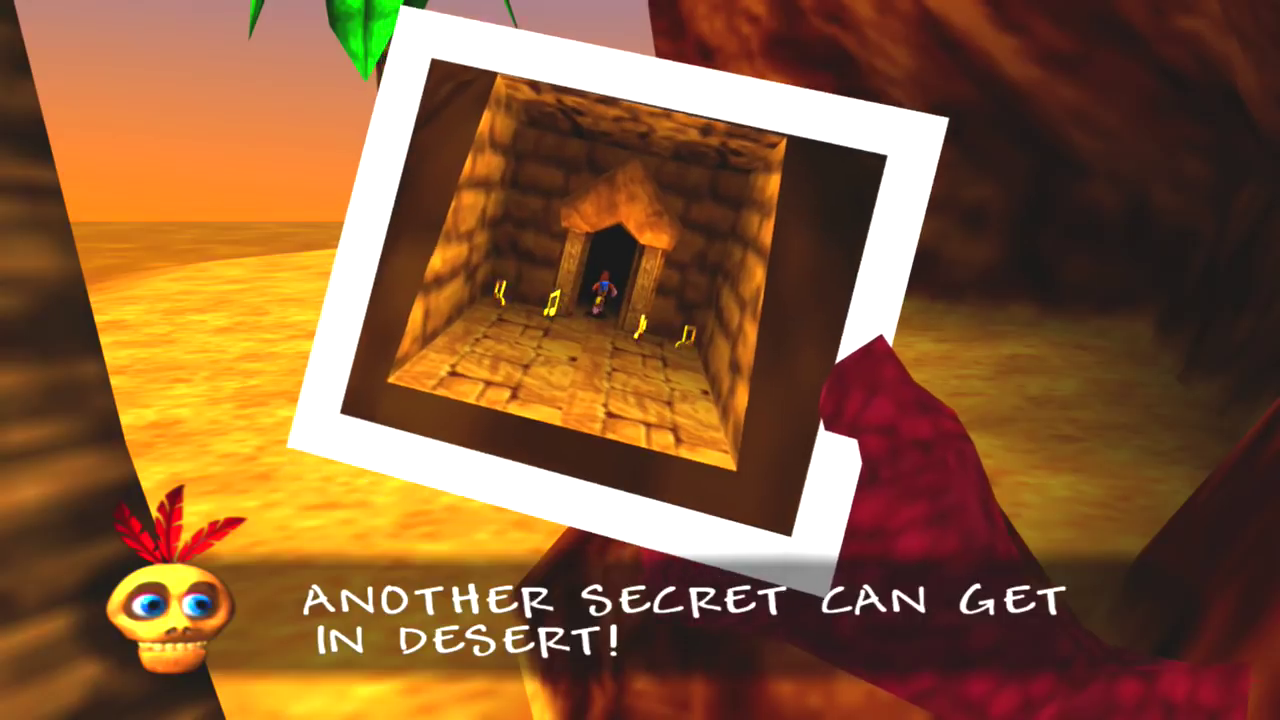
![]()
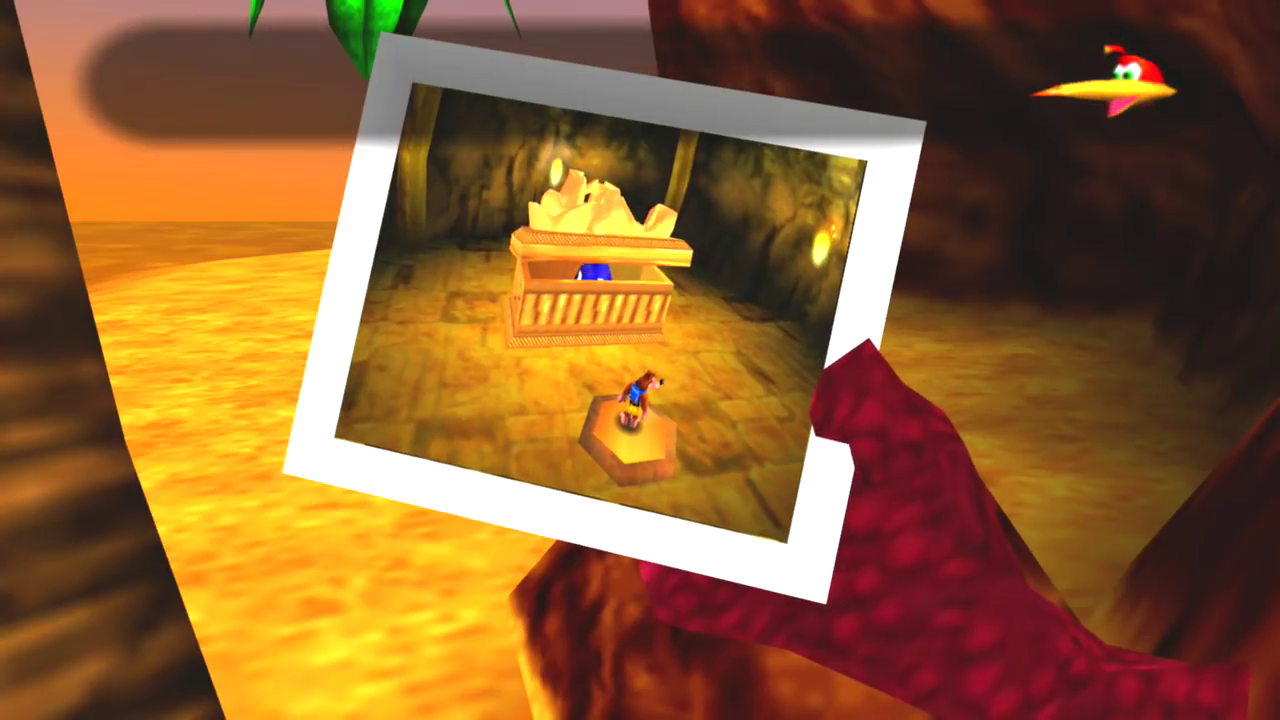
![]()
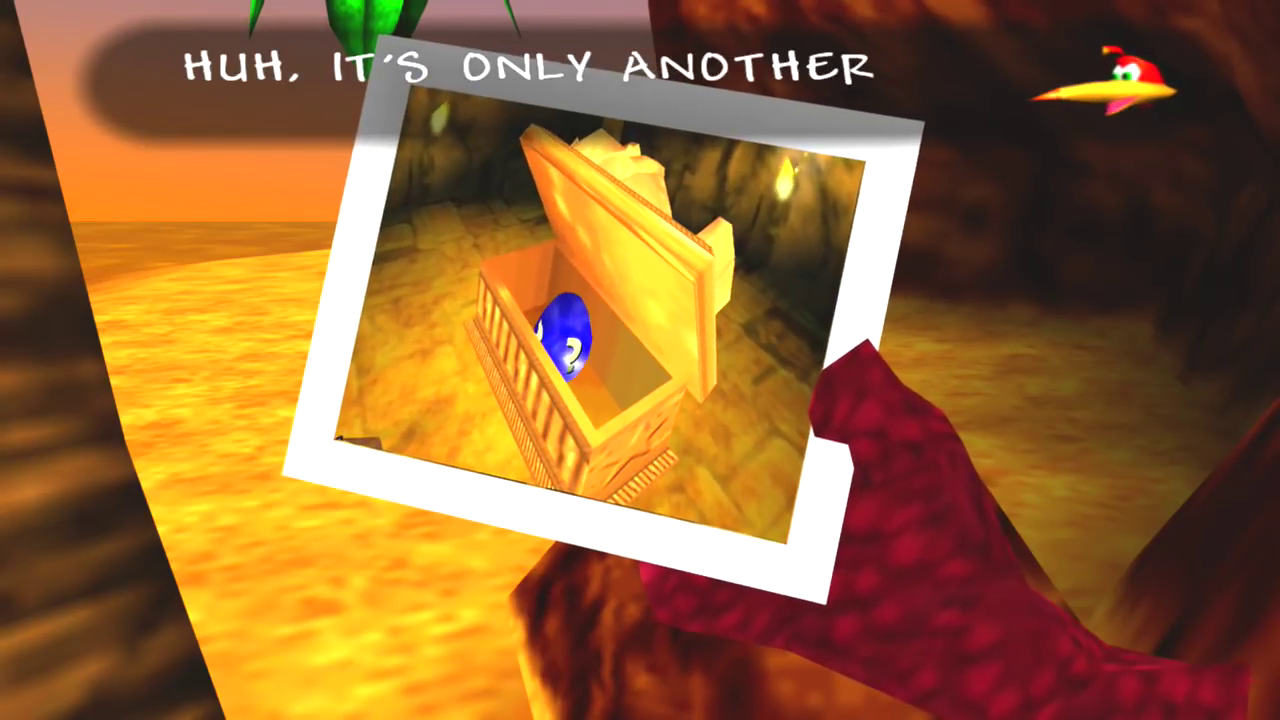
![]()
![]() [View Fullsize Image]
[View Fullsize Image]![]() [View Fullsize Image]
[View Fullsize Image]![]() [View Fullsize Image]
[View Fullsize Image]
At the end of the presentation, Mumbo was resiliently tight-lipped, only divulging that the purpose for the Ice Key and the two Mystery Eggs would come to light in Banjo-Tooie. Players could return to the areas that had been shown off in Mumbo’s secret pictures but they would find that Sharkfood Island, the Ice Keys wall and Gobi’s Valley door remain as sealed as they had been during their initial playthrough – it seemed that waiting for Banjo-Tooie was the only solution.
RAREWHERE’S BANJO-KAZOOIE RUMOUR MILL
The first official word for the then-untitled Ice Key/Mystery Egg feature was given by Rare on August 14th, 1998, just months after Banjo-Kazooie had been released. The answers could be found on their website, Rarewhere in their Rumour Mill section, where they sat down with one of Banjo’s designers and fielded questions from players hoping to get into the secret locations shown in Mumbo’s photographs. The second question in this feature would give players their first glimpse into how the feature was intended to work:
-
Q: So how do I reach the secret stuff that Mumbo shows me at the end of the game?
A: All the secret stuff can only be reached when playing Banjo-Tooie, the planned (and naturally better) sequel to Banjo-Kazooie. Whilst playing ‘Tooie, you’ll be able to come back to ‘Kazooie and grab the hidden goodies, before spiriting them away into the sequel where they will be put to good use. To avoid accusations that we are nasty money-grabbing types who are forcing players to fork out for both games, these secrets won’t be essential to completing Banjo-Tooie, but they will be rather spiffingly desirable, even if we say so ourselves.
Already, it looked as though Rare was employing a non-traditional means of having both Banjo-Kazooie and Banjo-Tooie interacting with one another. At this stage it was very clear that players would need to have a copy of both games on hand to unlock the rewards, though it wasn’t a requirement for either title.
Curiously, another question had been posed in the Rumour Mill that at first glance seems pretty unremarkable:
-
Q: Is there anything in the cave above the waterfall in Spiral Mountain?
A: This cave is empty in Banjo-Kazooie. Sorry!
Note that the answer takes care to specify that the cave is empty… in Banjo-Kazooie specifically. As for the sequel? Well, that’s an answer that will be elaborated in the Initial Reaction to Stop ’N’ Swop section below.
THE DISCOVERY OF THE STOP ’N’ SWOP MENU
While many players became swept up in speculation in what the intended purpose for the Eggs and Key might serve in Banjo-Tooie, others became set on collecting the items in the original title without the sequel. Collecting the Pink and Blue Egg at this point wasn’t possible, as both items required players to set events in motion to have their locations opened first which would cause them to ‘load in’. Aside from several mean-spirited ‘guides’ online that claimed this could be done, there wasn’t a solution to causing either Sharkfood Island to rise, or Gobi’s Door to open. The Ice Key was another story however, as it already appeared in game as a ‘loaded asset’ which meant that if unsavory players could find a way through the wall, they could get their hands on the Key.
As it turned out, their solution would come from going over the wall instead.
It was discovered that using a cheat device with a ‘levitation’ code would allow players to enter Wozza’s Cave and float high above the wall that kept them from the Ice Key – once a desired height were reached, the players would need only move forward a few feet and then return to the ground, where they now found themselves on the other side of the wall.
After celebrating and collecting the Ice Key, Kazooie would remark,
-
“Cool… An enormous Ice Key! We ought to keep this for later…“
Further investigation into the Pause Menu would reveal a previously hidden screen that would now hold the Ice Key. By viewing the totals reserved for the completion of each world, and continuing to scroll past the final entry of Click Clock Wood, players would discover the new menu, the header marked “Stop ’N’ Swop“. Pandora’s Box had been opened.
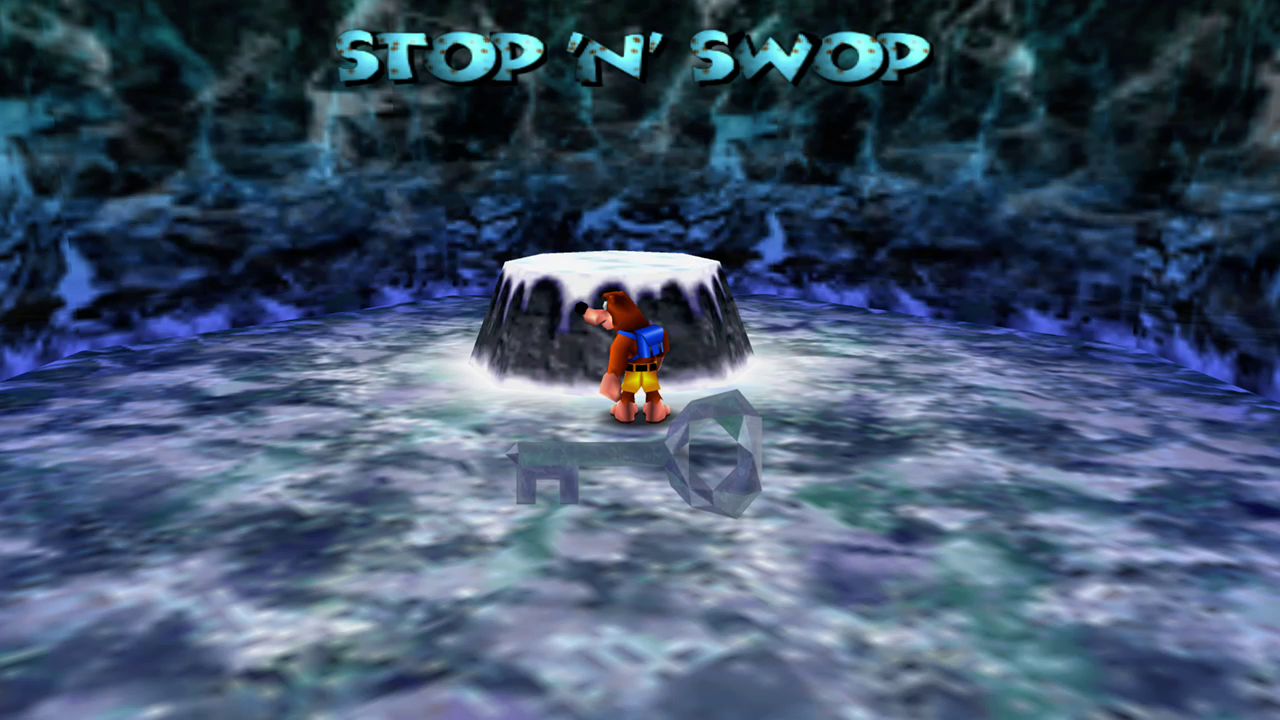
On June 9th, 1999, Rare released their Banjo-Kazooie edition of the Tepid Seat on their website – as ever, fans were clamoring for further information about Stop ’N’ Swop. Of the answered questions, three provide quite a valuable insight to the development of Banjo-Tooie and the proposed handling of the feature:
-
Q12: I was wondering since you announced the existence of Banjo-Tooie in the ending of B-K, and several aspects of the sequel existed in the first game (the ice key, sharkfood island, etc.), has your freedom of development been limited by these stones already set in place in any way, or was the game already well underway at that point? (DasPoot@aol)
A: Nothing that was in B-K has limited our freedom in B-T. Some ideas for B-T existed towards the end of B-K’s development, and the secrets were added in a way that we could access them cleverly (heh-heh, just you wait) from B-T.
Answer 12 confirms the ties that Banjo-Kazooie and Banjo-Tooie are meant to have with one another – accessing the secrets in a clever means will be elaborated on in the Discoveries in Banjo-Tooie section below.
-
Q14: In Mad Monster Mansion, there is a room with two pictures. One of Gruntilda, and one of this evil pirate bloke. What I want to know is: Will he be the next villain to face BK? Or is he somehow in league with Grunty? Is he mates with BK? Or is including his picture just arseing with my mind? (Chris Todd)
A: Well spotted sir! The evil pirate bloke has a mission and purpose all of his own, but this is neither the time nor place to reveal even the merest hint. You might learn more from a certain tavern in the near future…
Answer 14 brings the first public instance of Captain Blackeye into light, and at this stage in development it’s clear that Rare has already planned for the Captain to appear in Jolly’s Tavern. This too will be elaborated on in the Captain Blackeye section below.
-
Q31: Obviously aside from the ice key, Sharkfood Island, and desert door, are there any other places in B-K that are locked until B-T comes out? I’m thinking, maybe the closed barrel in the wine cellar in Mad Monster Mansion, or the two doors in the room with Grunty’s transformation machine. (Josh Gelman)
A: Heh… heh… heh… keep on guessing… ho… ho… ho… all will be revealed… hee… hee… heee… Sorry about that, the simple answer is yes.
Answer 31 is the first instance of confirmation that there are more secret locations to unlock in Banjo-Kazooie than initially shown off with Mumbo’s photographs. Specifically, the cellar of Mad Monster Mansion is mentioned. These answers will come to light in the Sandcastle Codes section below.
STOP ’N’ SWOP IN BANJO-TOOIE
Banjo-Tooie‘s release was met with strong fanfare in 2000 – it had managed to take everything players had loved about the original Banjo title and expanded on it – bigger worlds, badder bosses, more characters – it was all there, and it played brilliantly! However, there was still the matter of how Stop ’N’ Swop would make use of the Ice Key and Secret Eggs all the way from Banjo-Kazooie, and ironically the solution provided managed to raise even more questions about the feature…
The title would start players off in Spiral Mountain where the familiar setting gave way to several new areas – mainly a small cave behind the waterfall which could be reached with a Flight Pad not present in the original, and a large wrought-iron grate found above the Flap Flip training area. Provided that players had managed to learn the Grip Grab ability from Mayahem Temple, and the Grenade Egg upgrade found just outside of WitchyWorld, they would be able to find a way around the waterfall enclosure and a way through the grate in Spiral Mountain.
Previously trapped and forced to pace the length of their make-shift prisons were a pair of ‘Banjo-Kazooie Game Paks’; sentient Nintendo 64 cartridges complete with googly eyes and a large ‘B-K’ written on their front.
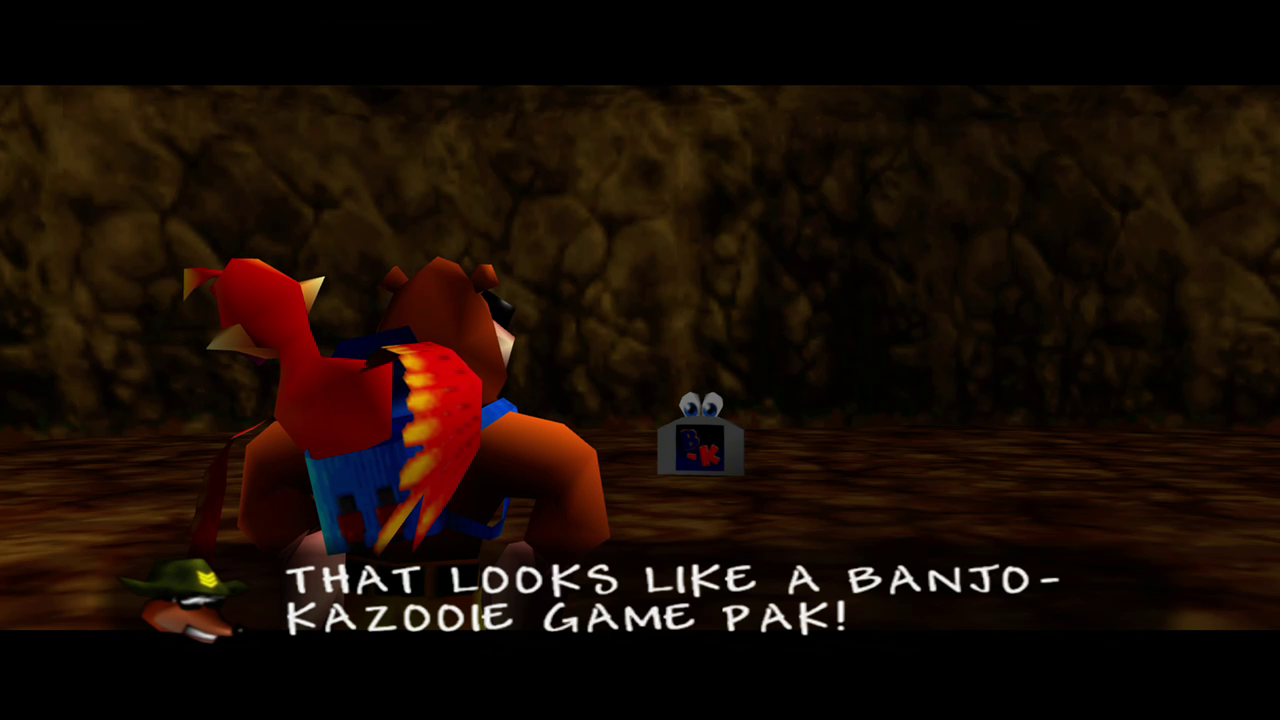
![]()
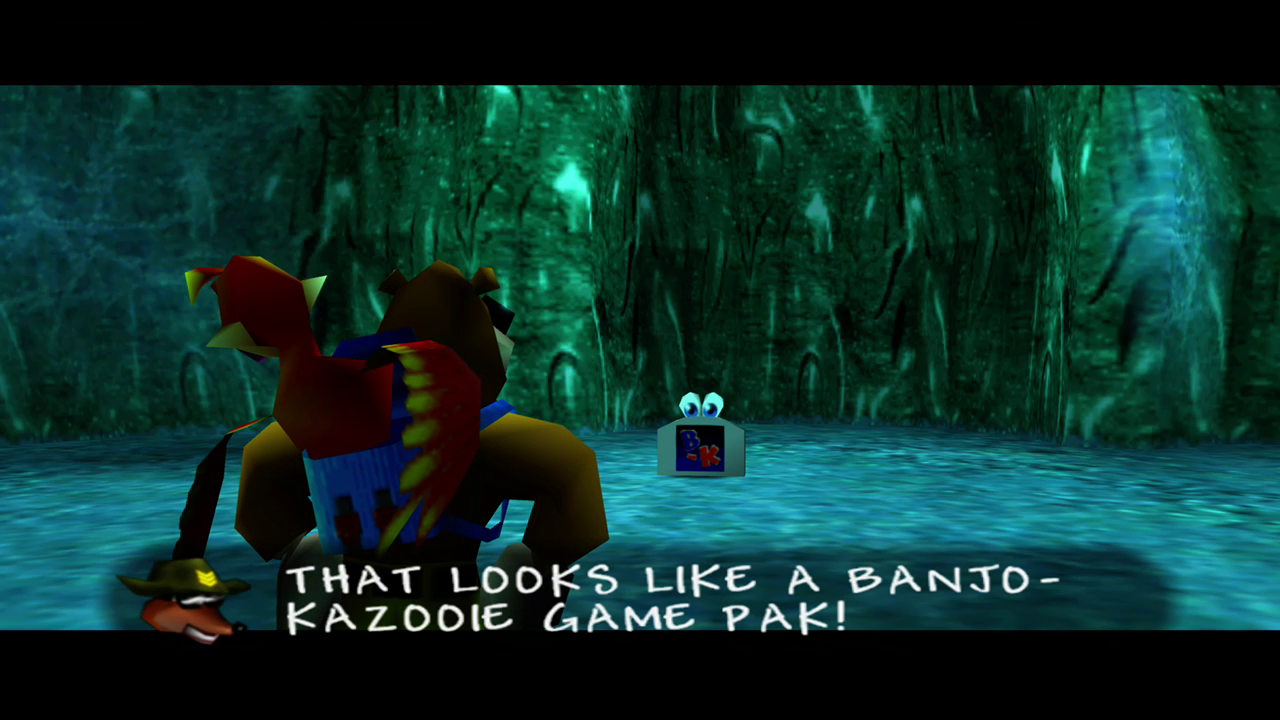
![]()
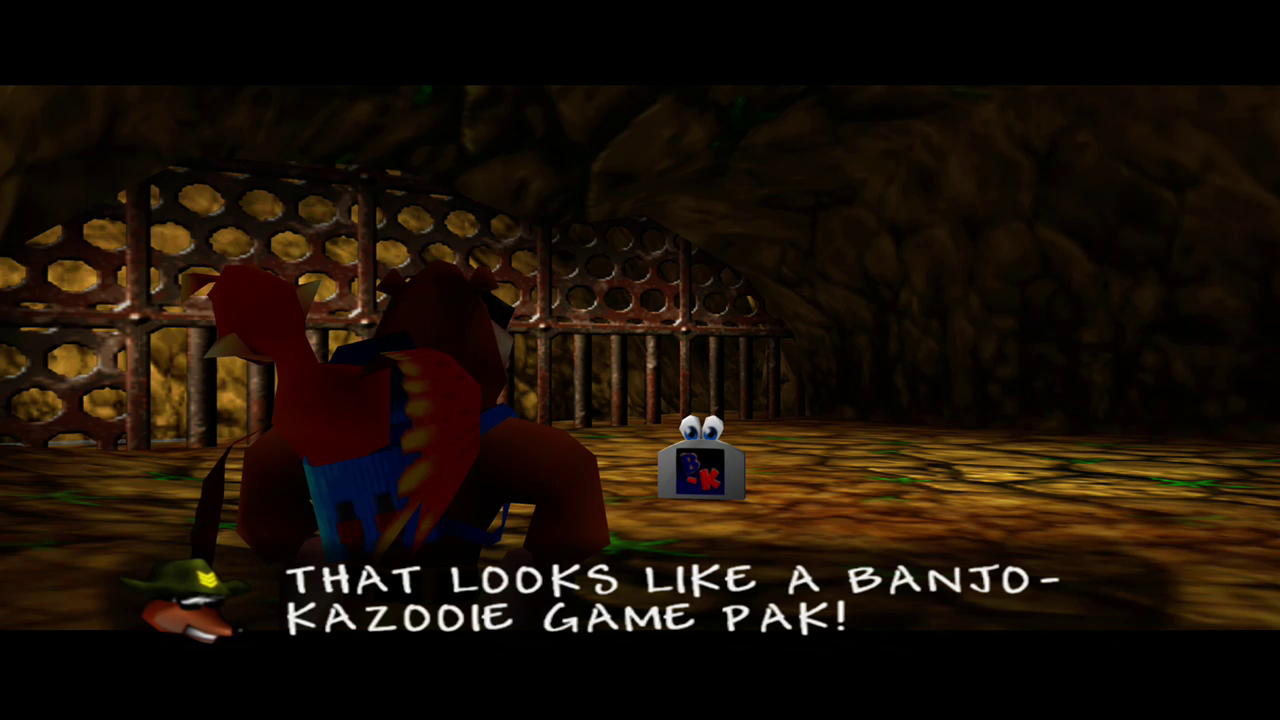
![]()
![]() [View Fullsize Image]
[View Fullsize Image]![]() [View Fullsize Image]
[View Fullsize Image]![]() [View Fullsize Image]
[View Fullsize Image]
Attacking the ‘Game Paks’ through any means would cause the cartridge behind the waterfall to drop the Mystery Blue Egg and the cartridge behind the wrought-iron Spiral Mountain grate to drop the Mystery Pink Egg respectively. It should be noted as well, that the size of the Mystery Eggs were remarkably smaller than those shown off in Mumbo’s Secret Pictures.
The Ice Key could be found and collected in a similar matter in Jinjo Village, where the Grip Grab ability would need to be utilized once again to access a secret tunnel. Inside the appropriately themed ice cavern, players would find a third and final ‘Banjo-Kazooie Game Pak’ which would surrender the Ice Key upon defeat.
UNLOCKING THE STOP ’N’ SWOP REWARDS
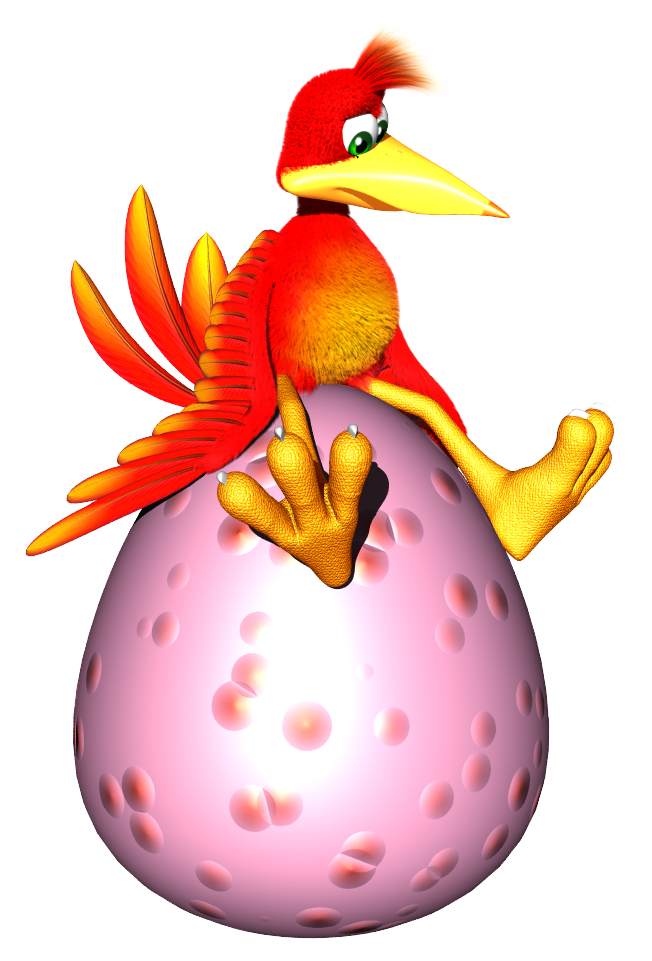 After collecting the secret items from the ‘Banjo-Kazooie Game Paks’, players would be tasked with traveling to Heggy’s Egg Shed in Wooded Hollow, near the entrance to the first level in Banjo-Tooie. Here they would discover that both the Pink and Blue Mystery Eggs could be hatched by the eponymous hen, along with a new Yellow Stop ’N’ Swop Egg that could be hatched solo with Kazooie.
After collecting the secret items from the ‘Banjo-Kazooie Game Paks’, players would be tasked with traveling to Heggy’s Egg Shed in Wooded Hollow, near the entrance to the first level in Banjo-Tooie. Here they would discover that both the Pink and Blue Mystery Eggs could be hatched by the eponymous hen, along with a new Yellow Stop ’N’ Swop Egg that could be hatched solo with Kazooie.
The Pink and Blue Eggs rewarded players with two new abilities in the ‘Breegul Bash’ and ‘Homing Eggs’, whereas the Yellow Egg unlocked the option to play as a Jinjo in the Multiplayer mode.
The Breegul Bash functioned as a close-quarters melee move, where pressing the B button twice in quick succession would cause Banjo to withdraw Kazooie from his pack and slam her towards the ground in front of the duo – while comical, the move was also effective at dealing with enemies that got too close for comfort.
The Homing Eggs enabled the ability to auto-target enemies when in first person mode – egg aiming in this manner would allow slightly misfired eggs to hone in on the intended target, making the game marginally easier.

![]()
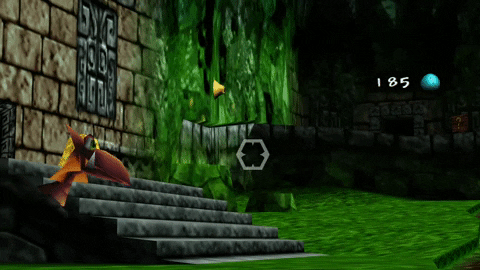
![]()
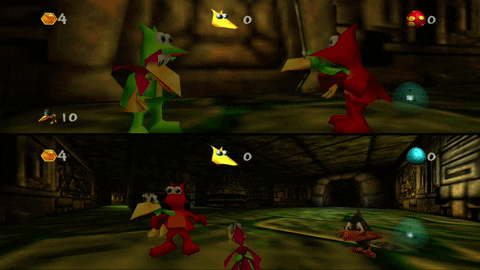
![]()
![]() [View Fullsize Image]
[View Fullsize Image]![]() [View Fullsize Image]
[View Fullsize Image]![]() [View Fullsize Image]
[View Fullsize Image]
The Ice Key was the most involved aspect as it required players to progress further into the game, though its reward more than made up for the legwork. Once players had learned the Talon Torpedo ability, they would able to destroy a large underwater boulder in Glitter Gulch Mine, revealing a hidden pathway just beyond. Swimming through the pathway would lead players to the frozen side of HailFire Peaks, where a large icy safe normally hidden behind a thick glazed wall seen in-game could be accessed. Unlocking the safe with the Ice Key, players would find the ‘Mega Glowbo’ inside, which could be collected and taken to Humba Wumba in the Pine Grove area to unlock a new Dragon transformation for Kazooie.
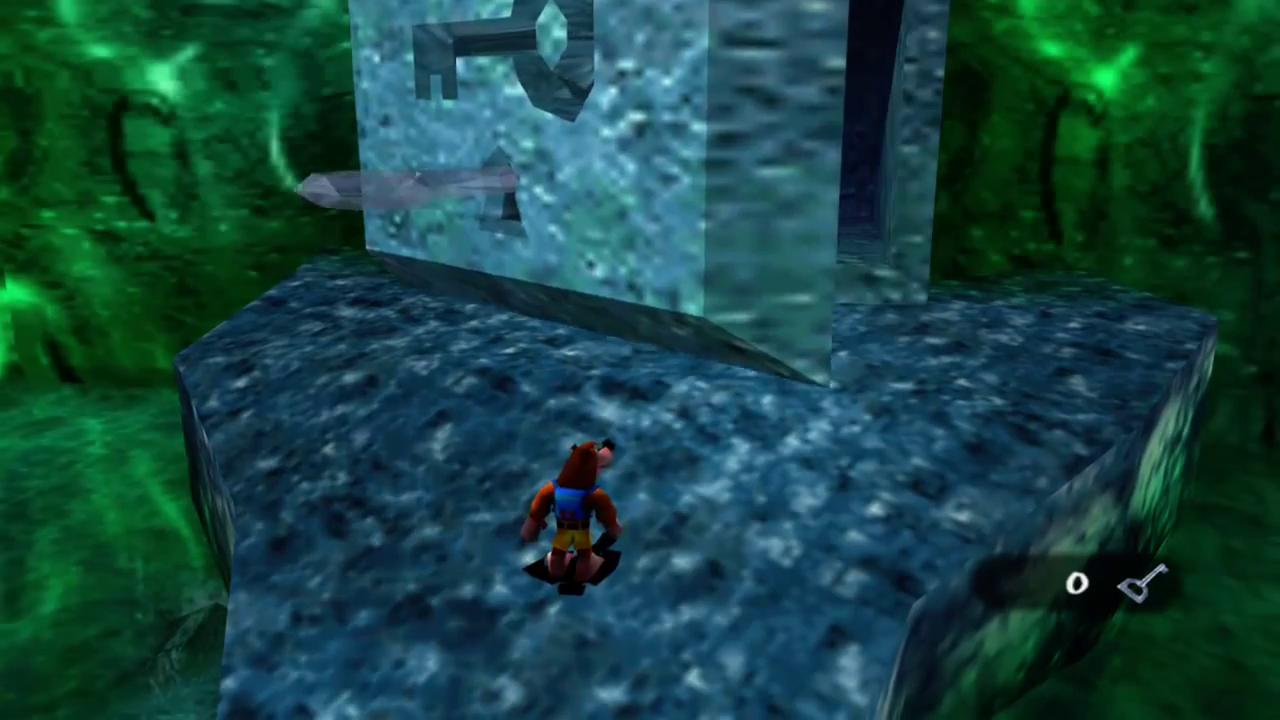
![]()
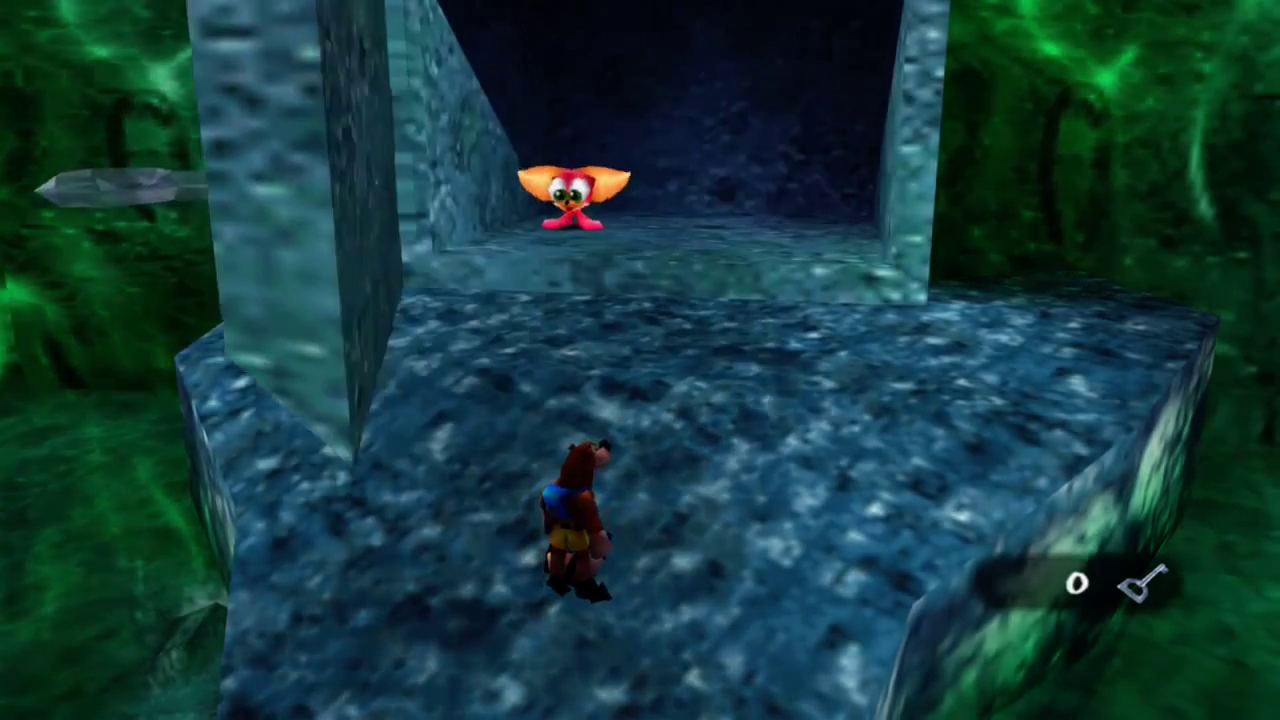
![]()
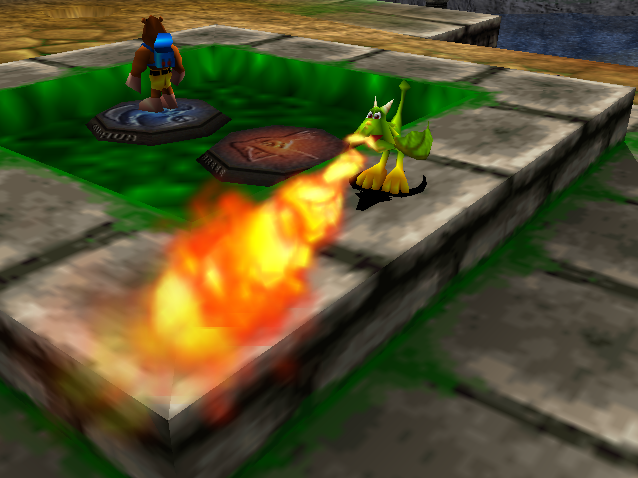
![]()
![]() [View Fullsize Image]
[View Fullsize Image]![]() [View Fullsize Image]
[View Fullsize Image]![]() [View Fullsize Image]
[View Fullsize Image]
INITIAL REACTION TO STOP ’N’ SWOP
While players enjoyed the rewards that the Ice Key and Mystery Eggs had provided them in Banjo-Tooie, there was still a great deal of confusion surrounding the connection to the original Banjo-Kazooie title. In the aforementioned Rumour Mill section, players were told that certain events in Banjo-Tooie would allow them to ‘come back to’ Banjo-Kazooie where they could collect the items in the original title by having Sharkfood Island rise from the seas, opening the desert door in Gobi’s Valley, and finding a legitimate way of getting though to the Ice Keys chamber. When the dust had settled, it looked like the proposed connection between the two titles had been effectively severed, and the solution provided was an unfortunate compromise.
Interestingly however, it would seem that some elements of the connection were utilized in this new manner, as shown in the Rumour Mill’s question about the waterfall containing something in the sequel which would have still been part of the original plan just two months into development.
Still, while players weren’t fully knowledgeable on the true scope of Stop ’N’ Swop at this point, it was clear that the nature of the mystery was only just getting started…
CAPTAIN BLACKEYE’S INTENDED MISSION AND PURPOSE
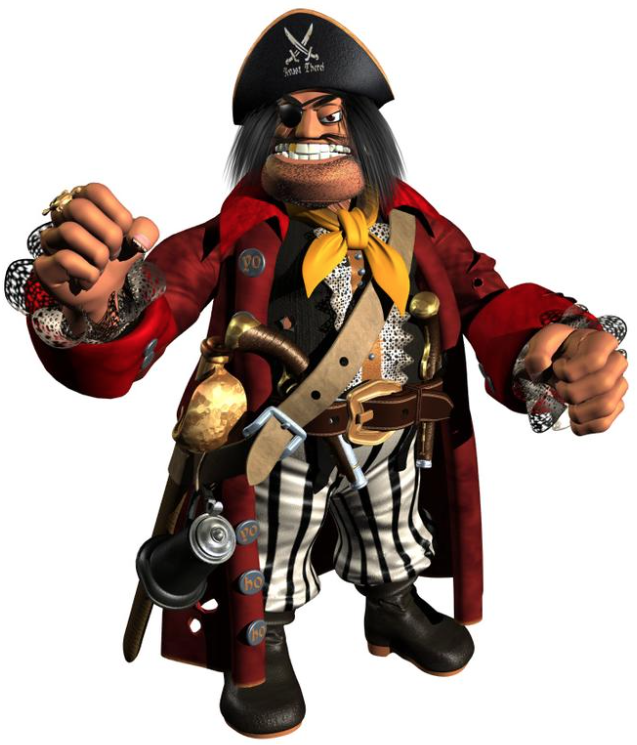
![]() Those attempting to move on from Mumbo’s Photographs in Banjo-Kazooie would have found things quite difficult when reaching the nautical world of Jolly Roger’s Lagoon in Banjo-Tooie. Starting off in a sea-side town center, players would be able to travel into Jolly’s Tavern where they would discover a pirate in the back room named Captain Blackeye – just as Rare alluded to in their Banjo-Kazooie Tepid Seat. One of the most tantalizing aspects of Captain Blackeye’s involvement of Stop ’N’ Swop is that he’s been surrounded by framed portraits alluding to the Mystery Pink Egg; the first nearest the entrance shows off a view of Treasure Trove Cove, beside the Captain is an intriguing shot of the fully risen Sharkfood Island, and behind him the Pink Egg shown atop the large spire inside it. Interacting with Captain Blackeye was largely unproductive; the Pirate would first take issue with Kazooie’s cheek before falling backwards onto the tavern floor due to apparent ‘sea sickness’ – parting with his last pair of doubloons, Blackeye would task the Bear and Bird with fetching him some water to cure him of his ailment. Unfortunately, the quest to find Blackeye some water would prove to be something of a red herring, as there’s no way to speak with Jolly about getting some water, or finding it through any other means.
Those attempting to move on from Mumbo’s Photographs in Banjo-Kazooie would have found things quite difficult when reaching the nautical world of Jolly Roger’s Lagoon in Banjo-Tooie. Starting off in a sea-side town center, players would be able to travel into Jolly’s Tavern where they would discover a pirate in the back room named Captain Blackeye – just as Rare alluded to in their Banjo-Kazooie Tepid Seat. One of the most tantalizing aspects of Captain Blackeye’s involvement of Stop ’N’ Swop is that he’s been surrounded by framed portraits alluding to the Mystery Pink Egg; the first nearest the entrance shows off a view of Treasure Trove Cove, beside the Captain is an intriguing shot of the fully risen Sharkfood Island, and behind him the Pink Egg shown atop the large spire inside it. Interacting with Captain Blackeye was largely unproductive; the Pirate would first take issue with Kazooie’s cheek before falling backwards onto the tavern floor due to apparent ‘sea sickness’ – parting with his last pair of doubloons, Blackeye would task the Bear and Bird with fetching him some water to cure him of his ailment. Unfortunately, the quest to find Blackeye some water would prove to be something of a red herring, as there’s no way to speak with Jolly about getting some water, or finding it through any other means.
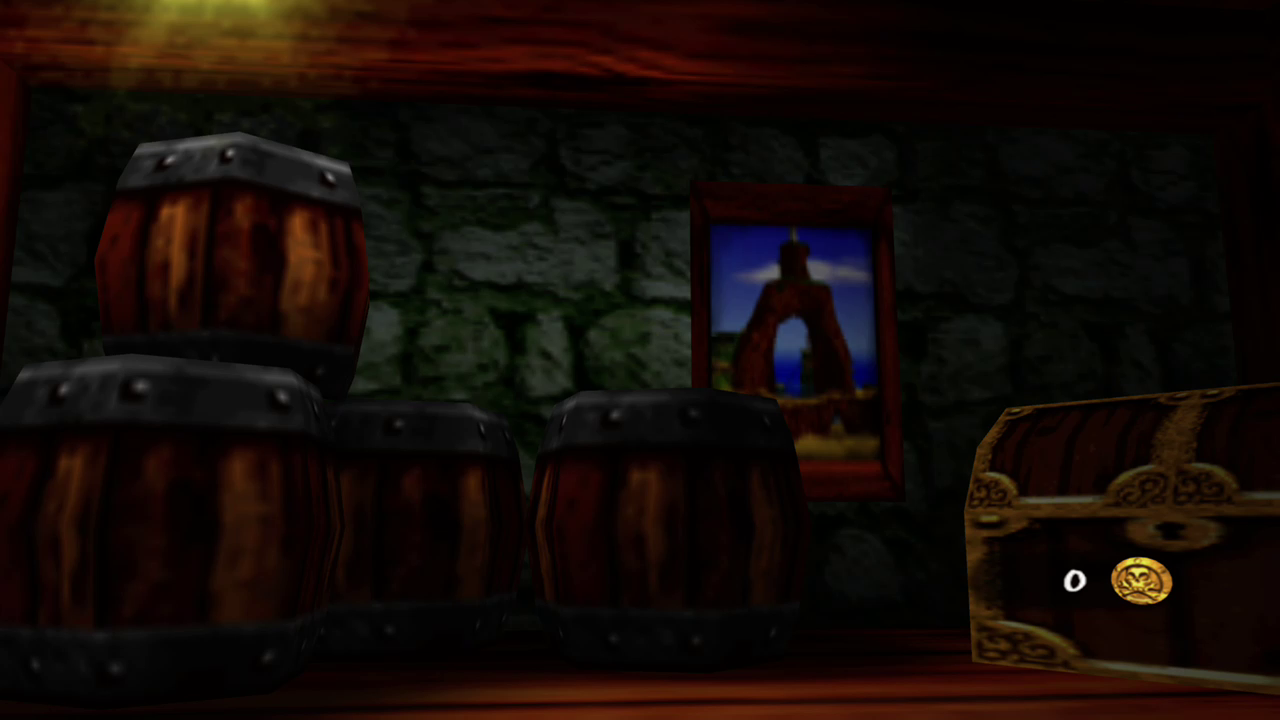
![]()
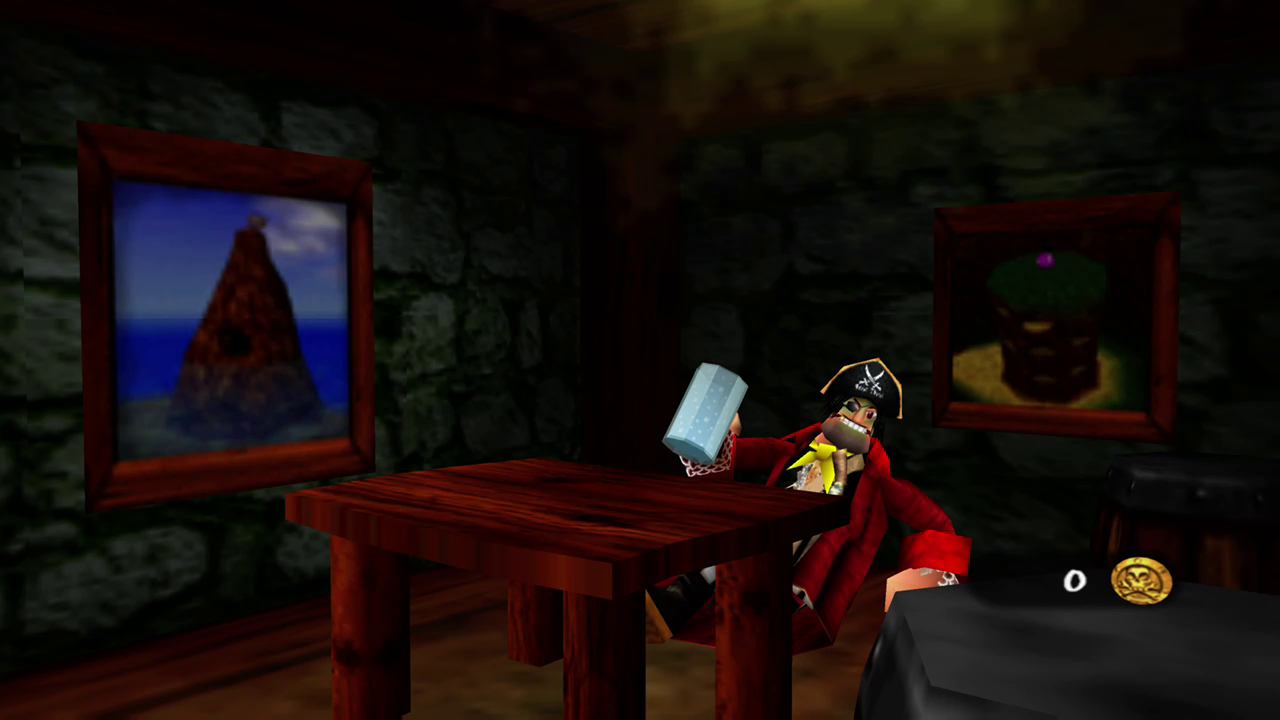
![]()
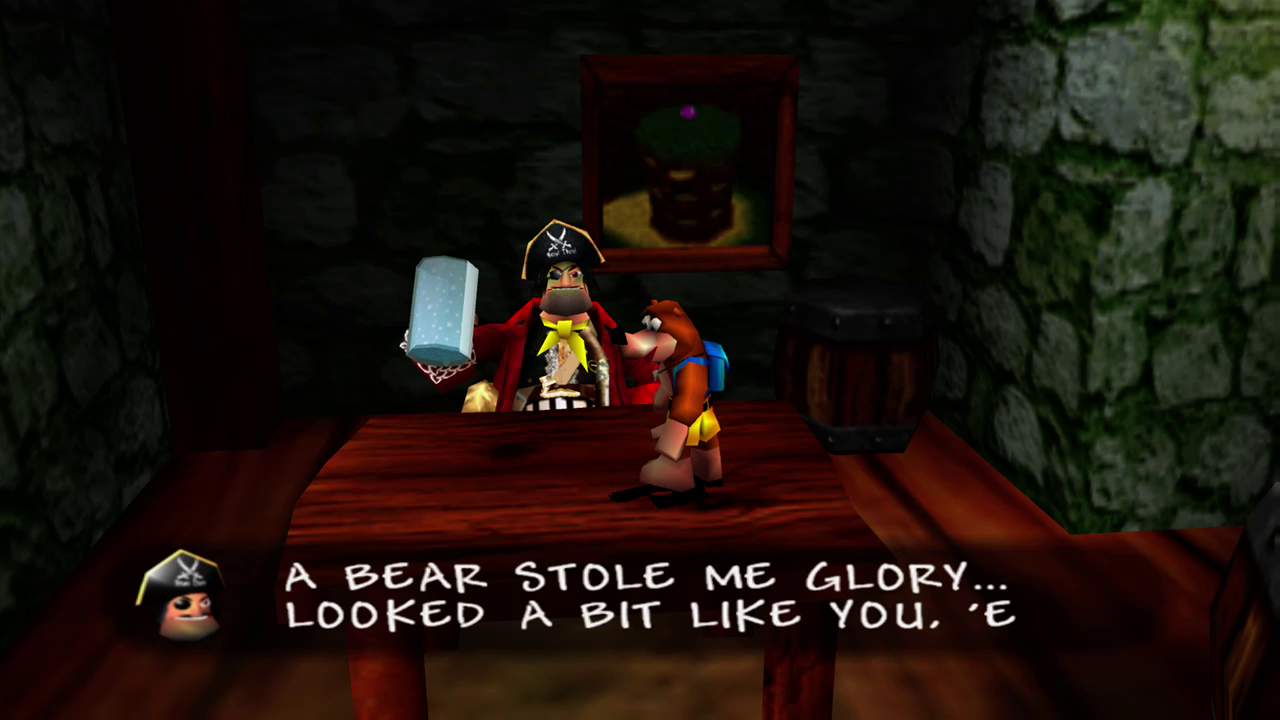
![]()
![]() [View Fullsize Image]
[View Fullsize Image]![]() [View Fullsize Image]
[View Fullsize Image]![]() [View Fullsize Image]
[View Fullsize Image]
Instead, players could continue to interact with Captain Blackeye as he spoke from the floor, reciting the same three snippets of dialogue:
- “Arr! I had a dream once…”,
- “I were in this fine game…”,
- “A bear stole me glory…looked a bit like you, ‘e did!”.
While the dialogue could be interpreted to relate to the Pink Stop ’N’ Swop Egg, Blackeye’s sayings are more likely tied to his original appearance as the antagonist for Banjo-Kazooie, or as it was known at the time, Dream.
Still, the trail hardly runs cold with the inferred role that Captain Blackeye could have had for Stop ’N’ Swop, as the Pirate seems to take part in several hidden aspects of the original title where his involvement would fit rather seamlessly.
First, there’s the acknowledgement from Rare’s Tepid Seat that Captain Blackeye would have a mission and purpose all his own, which seems a bit underwhelming in his current predicament. It’s more likely that returning to Banjo-Kazooie with Blackeye in mind might reveal some of the clever means that the secrets were originally intended to be collected.
Investigating both Rusty Bucket Bay and Mad Monster Mansion in this regard does present some convincing ties towards a potential Stop ’N’ Swop connection with Captain Blackeye. Visiting the Navigation Room in Rusty Bucket Bay reveals a large backlit map that at first appears to be part of the scenery. However, the map matches up perfectly with that of Treasure Trove Cove seen from above, and what’s more – the X on the map happens to coincide with the location of Shark Food Island.
Keeping speculation minimal, it wouldn’t be out of the question for a pirate to be familiar with charting maps and marking an X over buried treasure…
As noted in the Tepid Seat, Blackeye’s portrait does in fact appear in Mad Monster Mansion, and it’s quite easy to identify him after a meeting in the flesh at Jolly Roger’s Lagoon. Curiously, the portrait appears twice; once on the ground floor where it can be found at the rear of the mansion next to a portrait of Gruntilda, and again inside the Master Bedroom where it can be seen next to a four-poster bed. A detail that players might have missed was the large treasure chest in the corner of the bedroom, which looked a little out of place when the rest of the mansion was devoid of anything nautical. For a time, this line of reasoning was all anyone had to go on, until a revelation online took place…
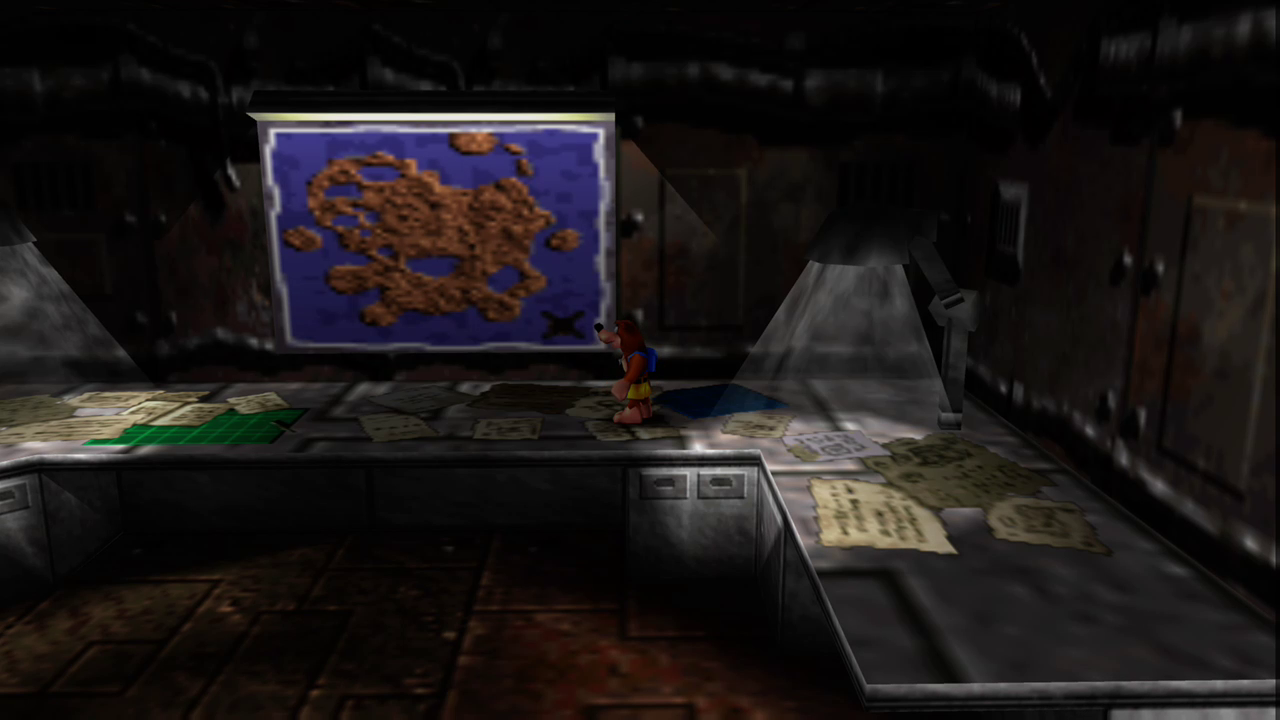
![]()
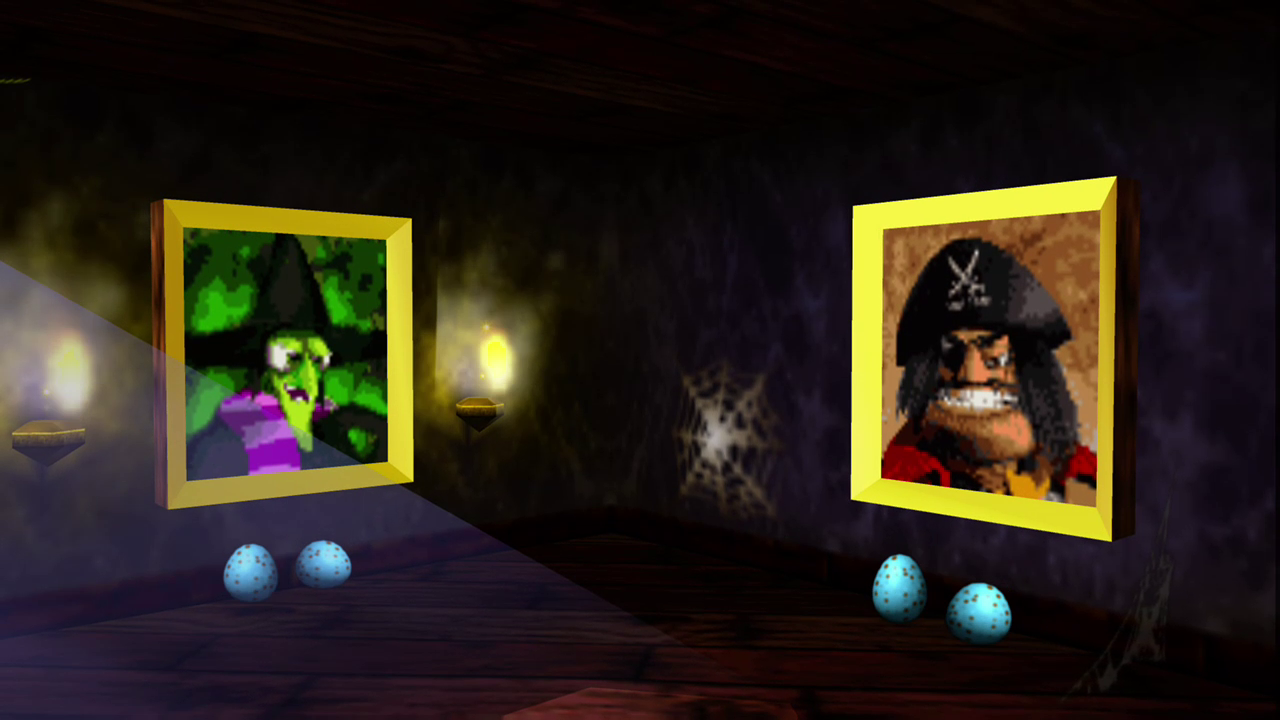
![]()
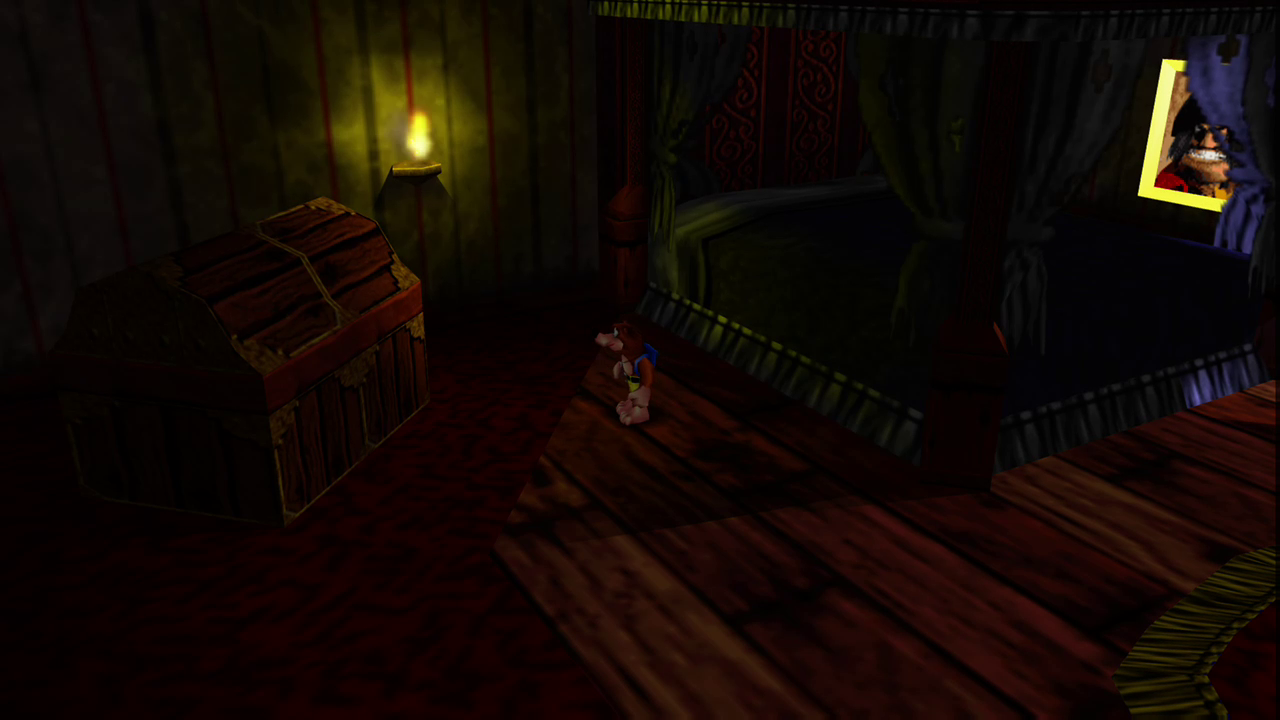
![]()
![]() [View Fullsize Image]
[View Fullsize Image]![]() [View Fullsize Image]
[View Fullsize Image]![]() [View Fullsize Image]
[View Fullsize Image]
STOP ’N’ SWOP REVELATIONS
While it looked as though transferring the Mystery Eggs and Ice Key from Banjo-Kazooie to Banjo-Tooie was a lost cause, there was still interest from fans scouring through the code of the original title to see if there was a means to collect the remaining Eggs. In just a year after Banjo-Tooie had been released, hacking enthusiasts Alan Pierce and Mitchell Kleiman had used their knowledge to examine the games code, uncovering a list of cheats meant to be spelled out using the letters on the floor of the Sandcastle in Treasure Trove Cove. While Rare had previously released a list of cheat codes that would influence the game as a bit of bonus fun with infinite items, the new codes discovered by Pierce and Kleiman would finally allow the locations of the Blue Mystery Egg and the Pink Mystery Egg to unlock legitimately without the use of a cheat device.
In order to grab the Stop ’N’ Swop items, players would need to spell out the word “Cheat” followed by a lengthy rhyming code. Once this was accomplished, a short cutscene would show the impacted change in the games environment and control would return to the player to retrieve the newly discovered items.
Spelling out “CHEAT” followed by “NOW YOU CAN SEE A NICE ICE KEY WHICH YOU CAN HAVE FOR FREE” would cut to a shot of the Ice Key still spinning in Wozza’s Cave, its ‘window’ effectively smashed open to allow players to collect it when returning to Freezeezy Peak.
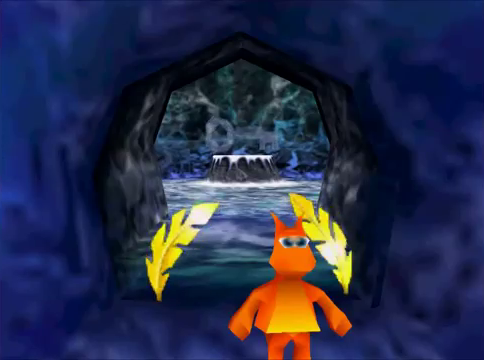
![]()
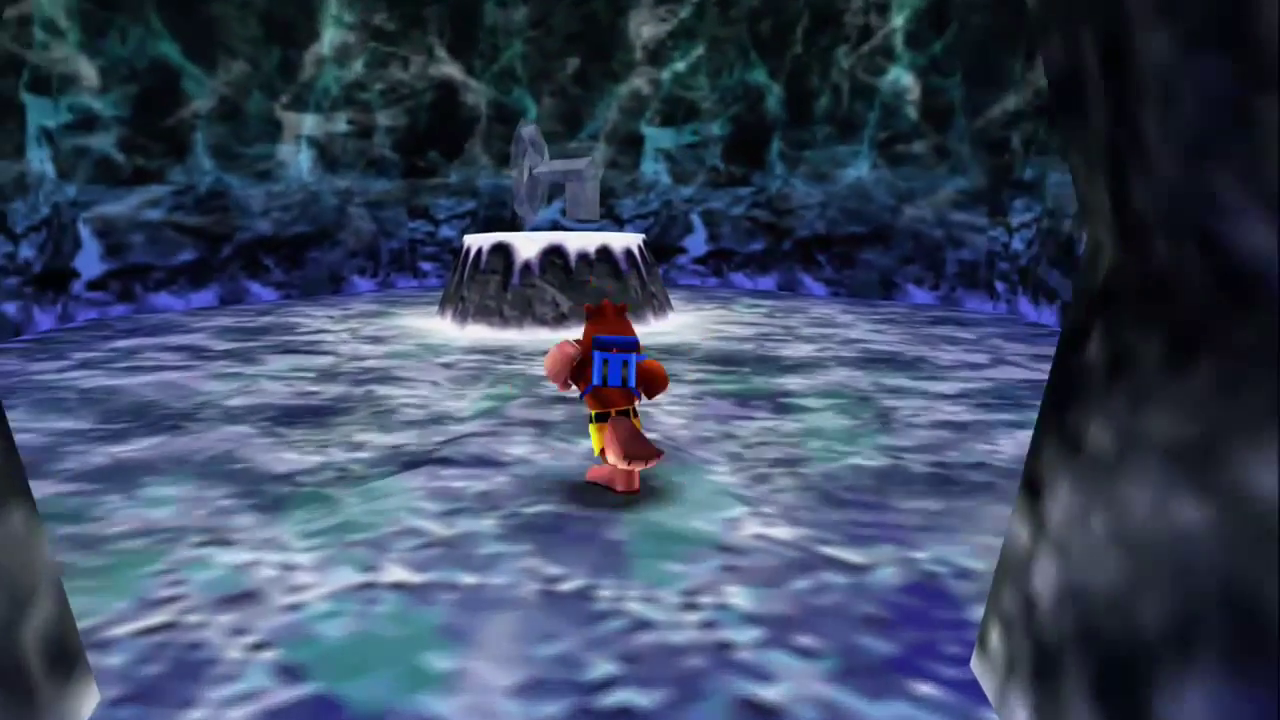
![]()
![]() [View Fullsize Image]
[View Fullsize Image]![]() [View Fullsize Image]
[View Fullsize Image]
The Blue Egg in Gobi’s Valley was also up for grabs, with a similarly lengthy and rhyming code to be found by entering, “CHEAT A DESERT DOOR OPENS WIDE ANCIENT SECRETS WAIT INSIDE”. After breaching the hidden tomb, Banjo and Kazooie would need only slam down on the Sarcophagus switch with a well-aimed Beak Buster to expose the Blue Egg.
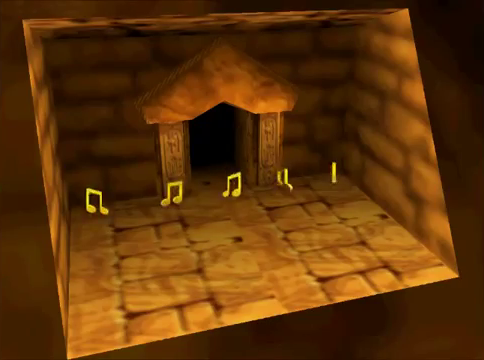
![]()
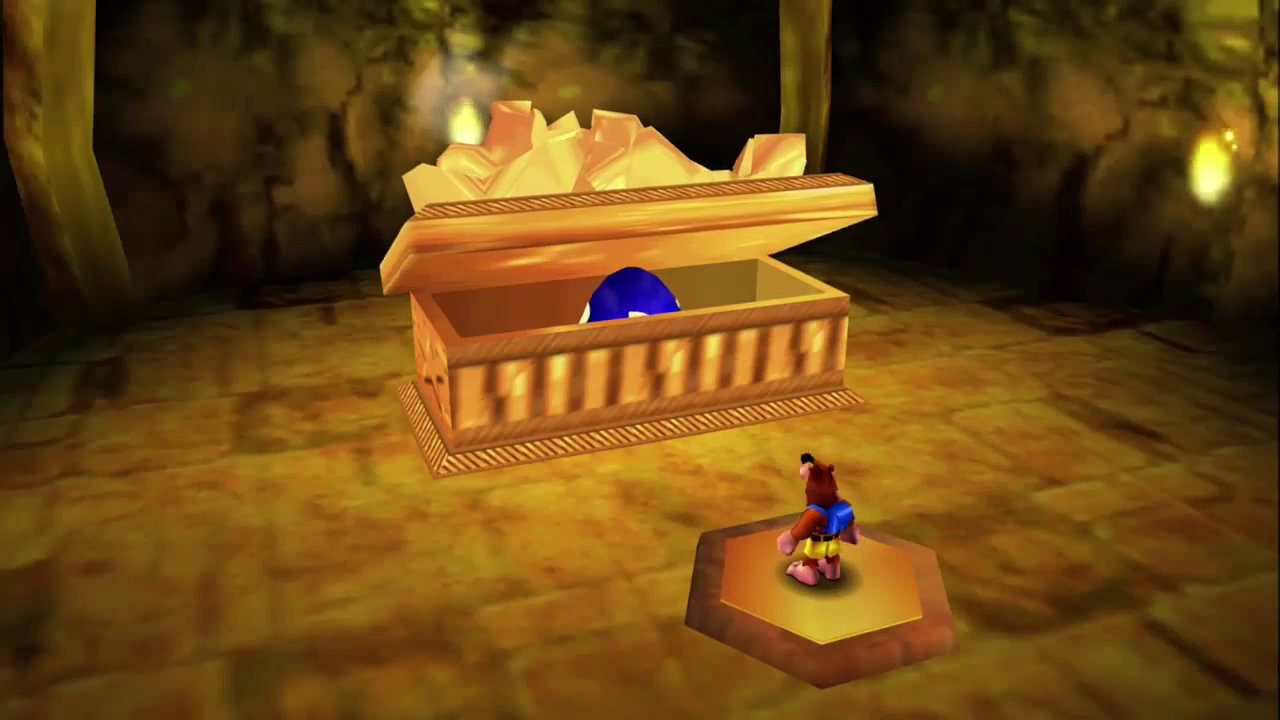
![]()
![]() [View Fullsize Image]
[View Fullsize Image]![]() [View Fullsize Image]
[View Fullsize Image]
And at last, the Pink Egg that had previously been hidden away in Sharkfood Island could be collected as well, this time spelling out “CHEAT OUT OF THE SEA IT RISES TO REVEAL MORE SECRET PRIZES” would cause the islet to rise from the waters and allow its entrance previously hidden beneath the waves to be accessed.
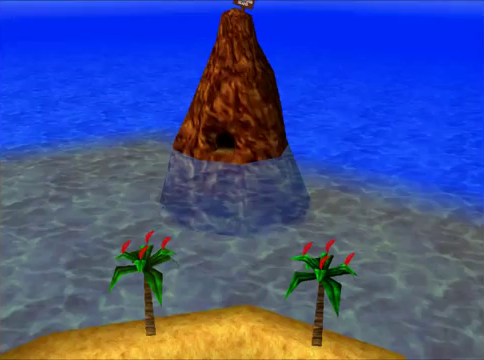
![]()
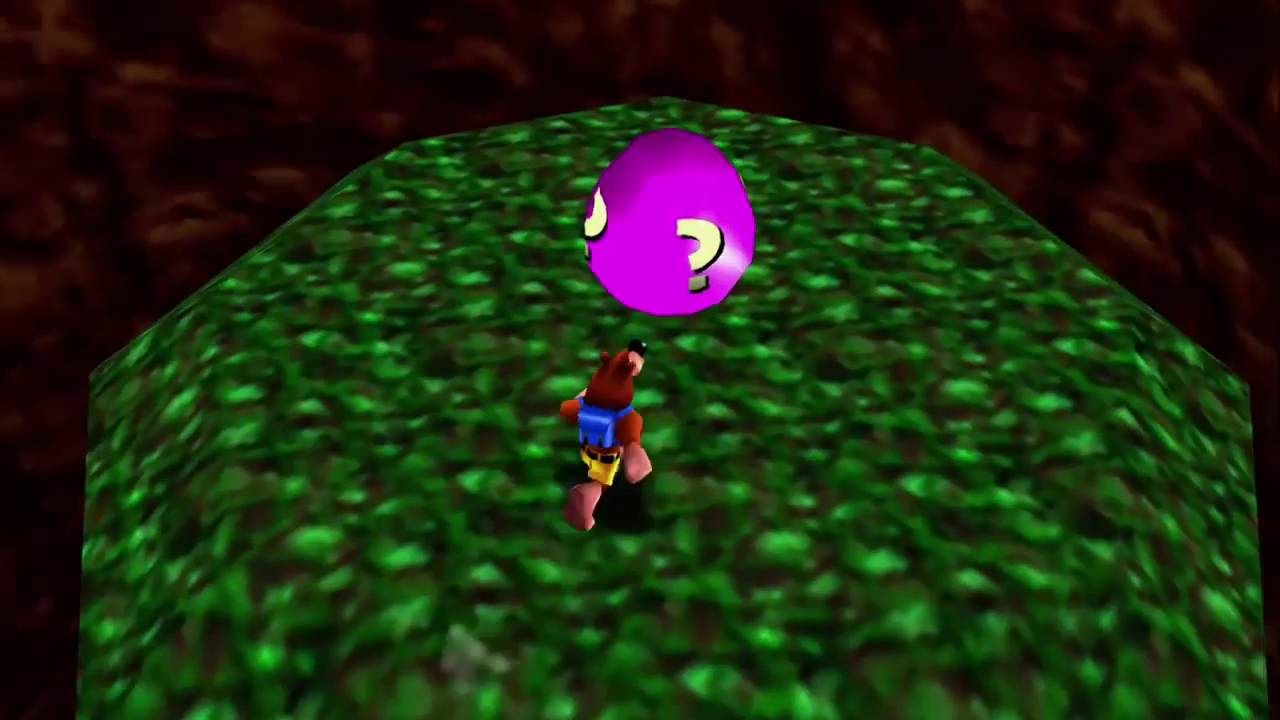
![]()
![]() [View Fullsize Image]
[View Fullsize Image]![]() [View Fullsize Image]
[View Fullsize Image]
Interestingly, the largest development to occur from the Sandcastle Codes was hinted during the Banjo-Kazooie Rumour Mill, where Rare confirmed that there would be more secret areas to open in the game – and true to their word, there was. Together, Alan and Mitchell discovered four further codes that would each unlock a new Mystery Egg hidden away…
The first of the new codes allowed players to venture into a barred off barrel in the cellar of Mad Monster Mansion after spelling out, “CHEAT DONT YOU GO AND TELL HER ABOUT THE SECRET IN HER CELLAR”. Doing so would remove the bars and lid entirely, allowing players to discover that the barrel tunneled deeper, giving way to a new area harboring a large Cyan Mystery Egg. Curiously, this code would mark the last occurrence of the secret items being hidden away in a new area not seen during gameplay, as the rest would simply ‘appear’ in a familiar setting.
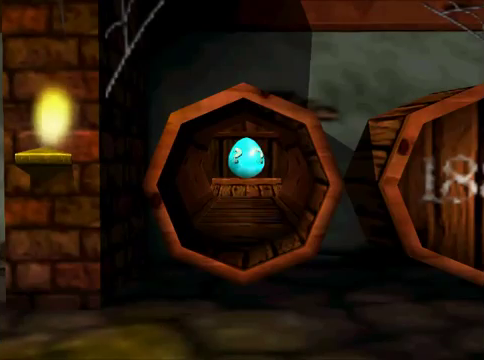
![]()
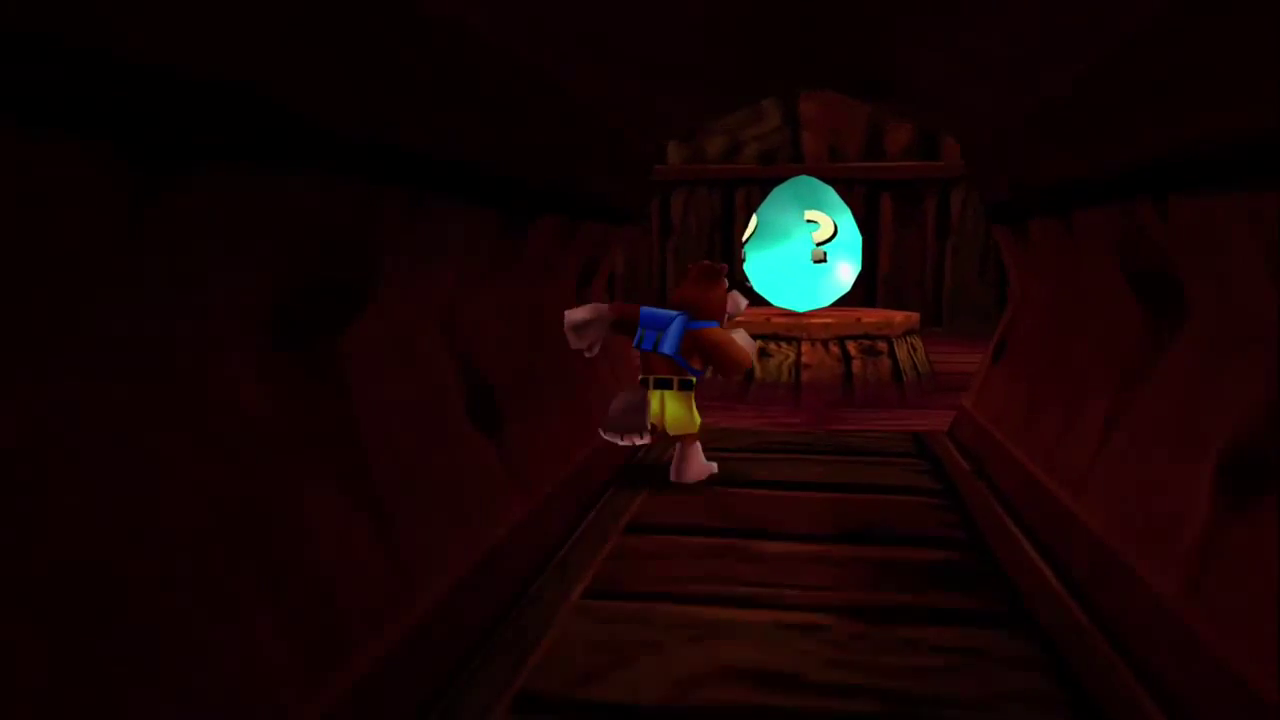
![]()
![]() [View Fullsize Image]
[View Fullsize Image]![]() [View Fullsize Image]
[View Fullsize Image]
In the same level, players could acquire the Green Mystery Egg found above Loggo the Toilet by spelling out “CHEAT AMIDST THE HAUNTED GLOOM A SECRET IN THE BATHROOM”. Doing so would cause the Green Egg to appear, as well as permanently causing the Stop ’N’ Swop celebratory theme to play in place of the standard interior theme.
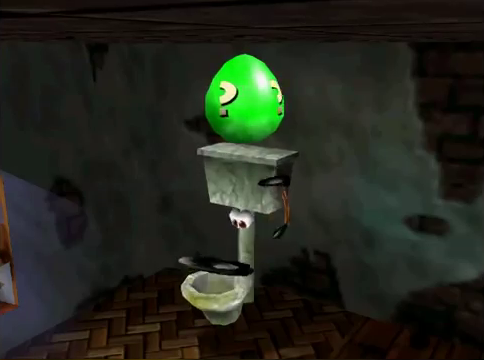
![]()
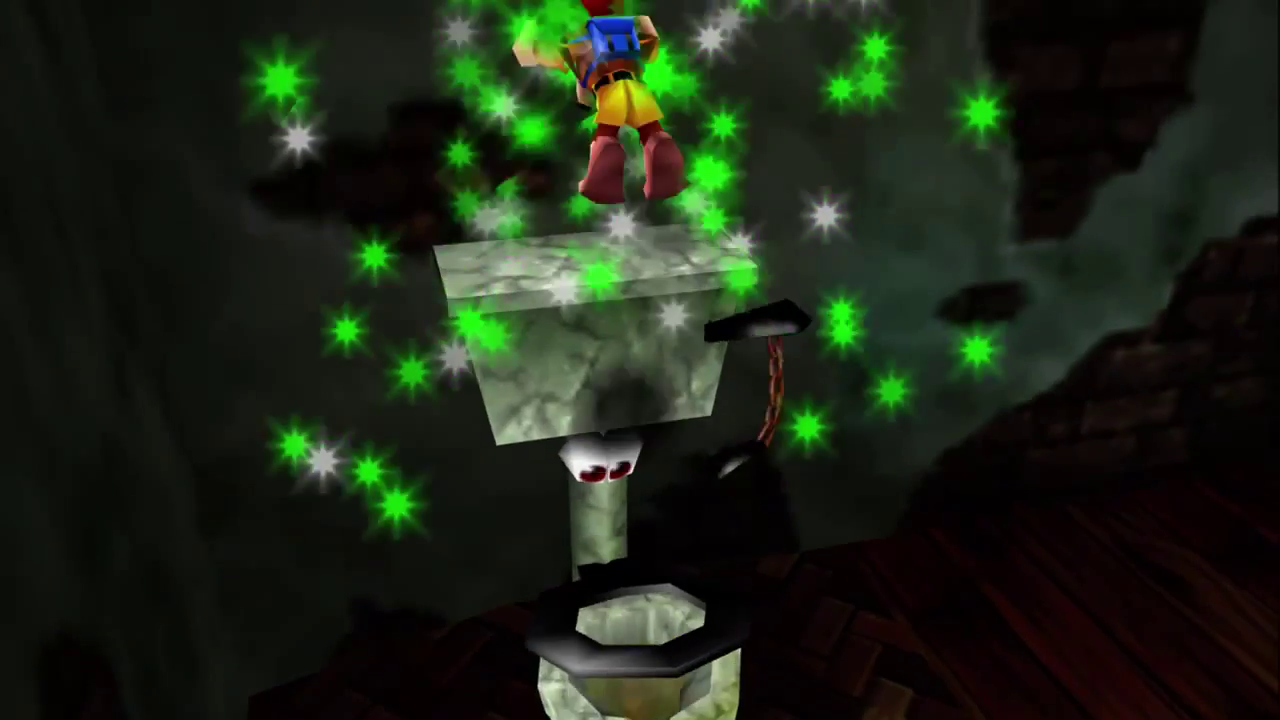
![]()
![]() [View Fullsize Image]
[View Fullsize Image]![]() [View Fullsize Image]
[View Fullsize Image]
Across from the Navigation Room, players could find the Red Mystery Egg in the Captain’s Cabin by spelling out, “CHEAT THIS SECRET YOULL BE GRABBIN IN THE CAPTAINS CABIN”. Entering the code would have the Egg instantly appear on the center of the bed.
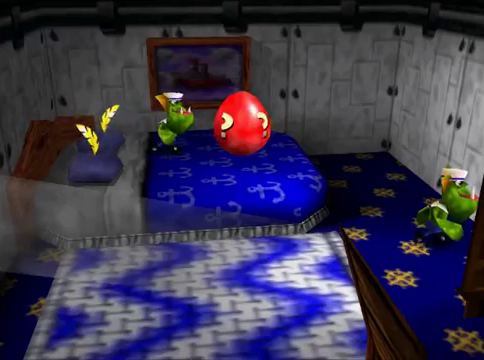
![]()
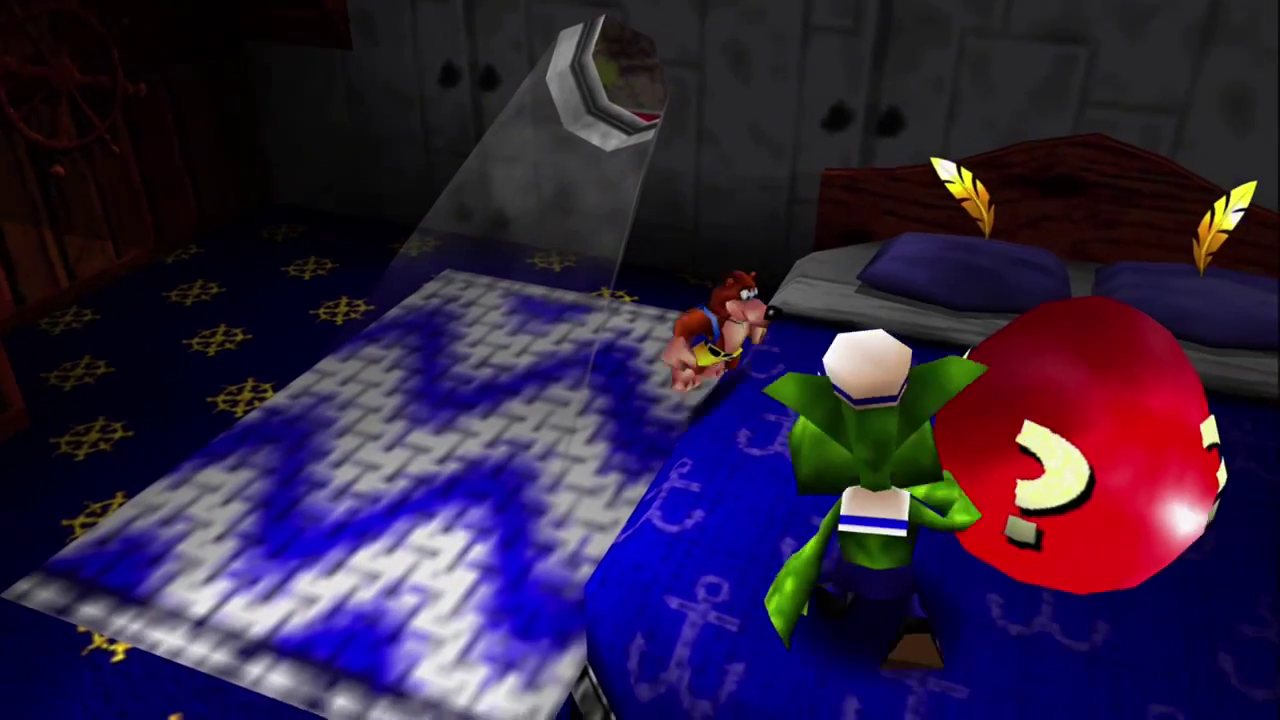
![]()
![]() [View Fullsize Image]
[View Fullsize Image]![]() [View Fullsize Image]
[View Fullsize Image]
The final Sandcastle code would allow the last Stop ’N’ Swop item to be collected. Entering “CHEAT NOW BANJO WILL BE ABLE TO SEE IT ON NABNUTS TABLE” would reveal the Yellow Mystery Egg inside Nabnut’s House in the Winter season of Click Clock Wood. The Yellow Egg is the only item outside of the original three Stop ’N’ Swop items to be seen in Banjo-Tooie – the others were entirely new.
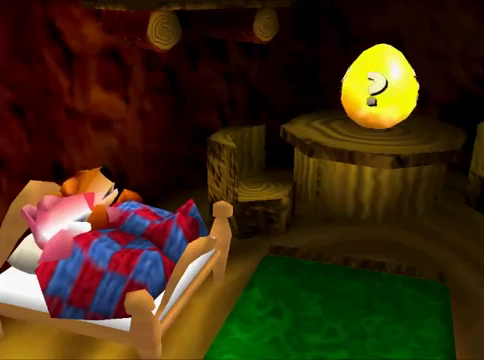
![]()
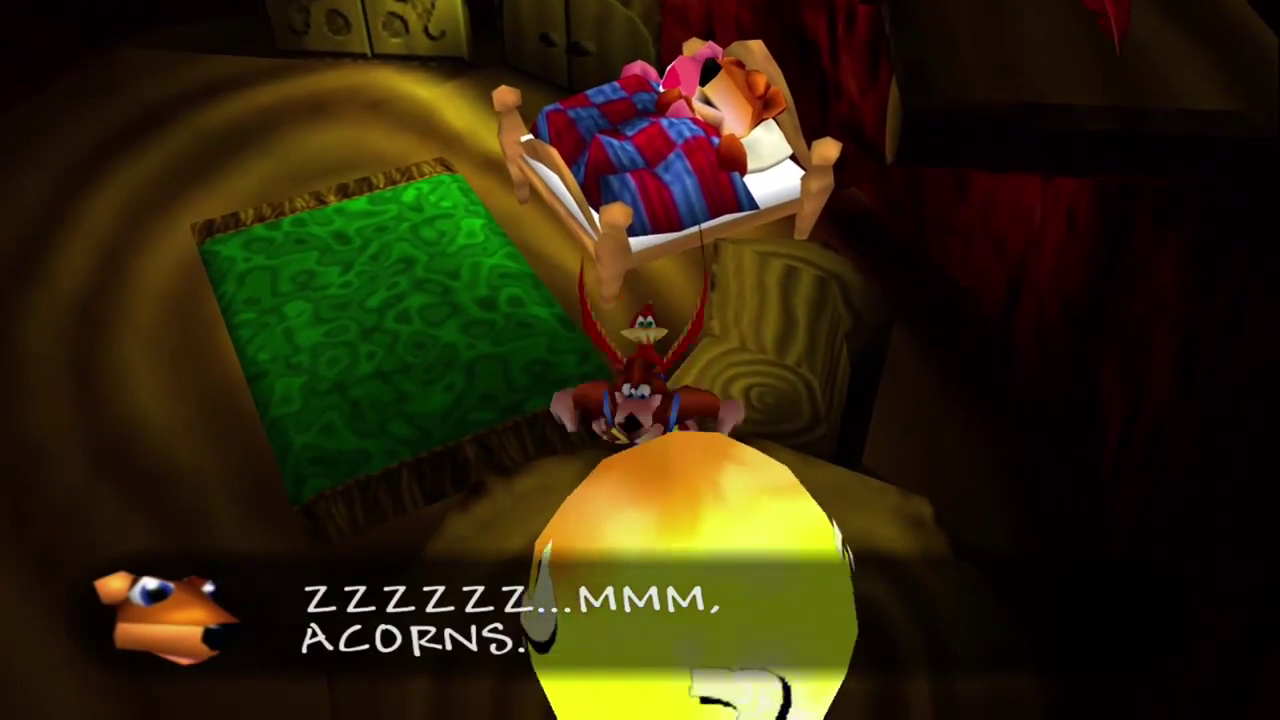
![]()
![]() [View Fullsize Image]
[View Fullsize Image]![]() [View Fullsize Image]
[View Fullsize Image]
Now that players had found a way to all of the areas that had been previously rendered inaccessible and collected all seven Stop ’N’ Swop items, the menu that had originally been discovered with the Ice Key was now wholly complete. With Banjo-Kazooie spent of its secrets, all eyes turned towards Banjo-Tooie to find any remnants of a feasible connection between the two…
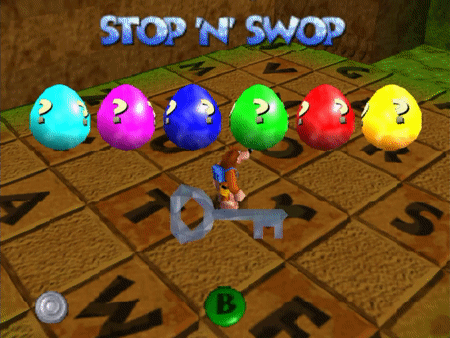
Given Banjo-Tooie‘s size and scope, initial efforts to explore the games code proved to be quite an undertaking, and development on this front began as a slow process. It wasn’t long however, that these fledgling efforts would lead to some of the most promising discoveries and speculation towards Stop ’N’ Swop’s intended application.
One of the first findings was the ‘Base Egg’; an unused model of the full sized Stop ’N’ Swop Mystery Egg taken straight from Banjo-Kazooie. If at one point in its development, Banjo-Tooie was meant to use the same Eggs as seen in the previous adventure, these larger versions would have been found in place of the smaller ‘Game Pak’ versions presented in the final game.
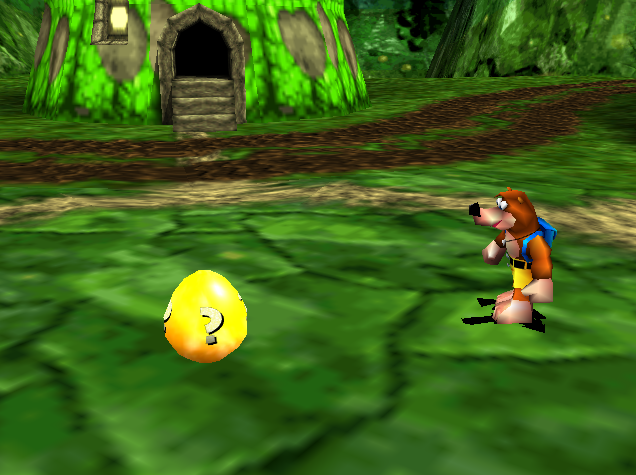
![]()
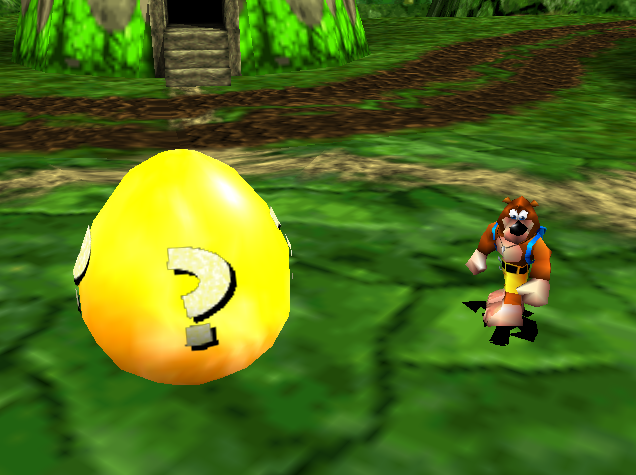
![]()
![]() [View Fullsize Image]
[View Fullsize Image]![]() [View Fullsize Image]
[View Fullsize Image]
Interest has also surrounded environments and locations that had been removed during development, but could still be found buried in the games memory – the logic followed that if Stop ’N’ Swop had its own designated location to share the Mystery Eggs and Ice Key between both titles, it would make sense that this area would have been removed once the ‘Game Pak’ solution was presented, yet remnants of the original plan could have remained in the code just waiting to be found.
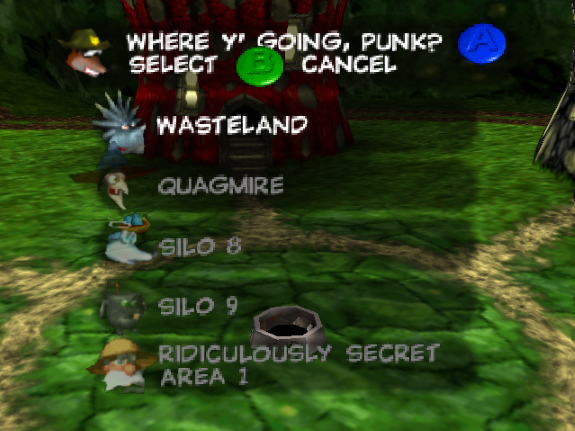
![]()
One of the first breakthroughs was found in examining the shortcut tunnel “Silo’s” that move instructor Jamjars had throughout the Isle O’ Hags. Ordinarily, Banjo and Kazooie can activate seven Silo’s in the Isle ‘O Hags as a network to make traveling through the areas easier – the last Silo, “Quagmire”, will take the duo to the furthest location just outside of Cauldron Keep where they’re meant to fight Gruntilda. However, three additional inaccessible Silo locations called “Silo 8”, “Silo 9” and perhaps the most mystifying, “Ridiculously Secret Area 1” had been found by combing through the games code.
While Silo 8 and Silo 9 may have existed as placeholders, the Ridiculously Secret Area 1, (shortened to RSA for convenience by the community) was far too alluring to allow the same designation, and for many, the thought of it acting as the principal area to exchange the Mystery Eggs and Key became the obvious conclusion.
Another area of significant interest was Gruntilda’s Lair, which served as an overworld in the previous Banjo-Kazooie adventure. In the sequel, the entrance of the Lair may still be accessed in Spiral Mountain but any progress beyond the initial starting area would be impeded, as large boulders had sealed off all further entrances. The only elements left to interact with was Cheato, whom the players could retrieve secret passwords for the Code Room in Mayahem Temple, and the large portrait of Gruntilda that had somehow become torn open after the events of the first game. Behind the portrait, a small area could be found carved into the stone much like a wall safe, and players could explore this new area to find three Feather Nests to replenish their supply. This area too was scrutinized by the community, as it stood to reason that if Gruntilda’s portrait had hidden a secret area in Banjo-Tooie that it must have always been there, including its appearance in Banjo-Kazooie. While this logic is sound, all investigation to the portrait room in the first title have not led to any new discoveries.
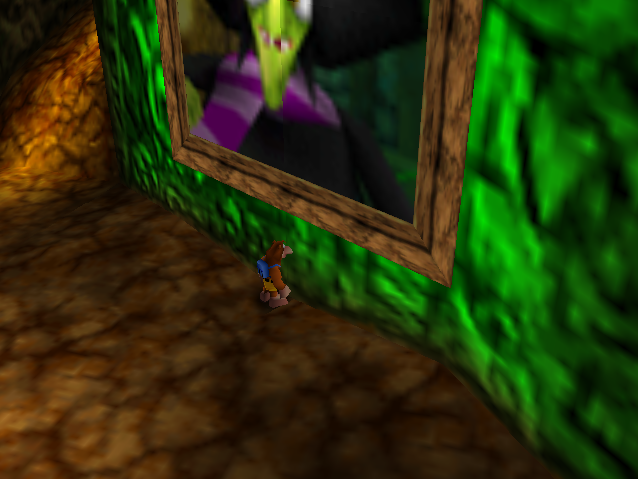
![]()
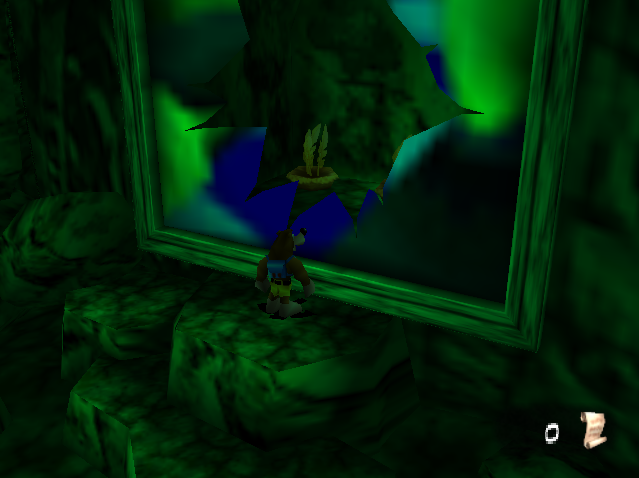
![]()
![]() [View Fullsize Image]
[View Fullsize Image]![]() [View Fullsize Image]
[View Fullsize Image]
The areas beyond the Lair could still hide some secrets in Banjo-Tooie however, as observant players also noticed that their arrival in the Old Lair was prefaced with a bit of text at the bottom of the screen declaring them to be in Gruntilda’s Lair (Entrance), which implied that there were further areas to explore, as the distinction would be meaningless otherwise. As enthusiasts continued to analyze the games code, another unused area of the Lair was eventually discovered called, “Gruntilda’s Lair (Tower Room)”, which had previously served as the final room in the Lair meant to be accessed before fighting Gruntilda atop the tower. Predictably, any efforts to break the boulders and get up to the Tower Room have been entirely fruitless, however, the original plan might not have involved progressing through the interior at all…
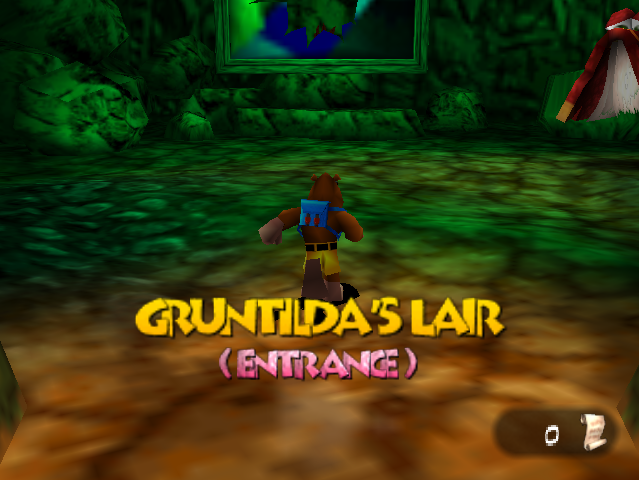
Outside of Gruntilda’s Lair in Spiral Mountain, players could locate a Flight Pad and attempt to fly up towards the Tower in opposite fashion as Gruntilda had done in the end of the first title. While returning to the battlements at the top proved to be quite difficult as the maximum flight height stopped miserably short, players could ascend to the large window found underneath. At one point it could have been possible to enter the Tower Room through this window, as an unused asset in the game called, ‘chgruntylairexttowerwindow’ could have served as the identifier to a glass window that players would have needed to break to gain access inside. This theory gains further traction when considering that the ‘Tower Room Window’ itself has its an opening when viewed as a wireframe model, an unnecessary detail if it were just part of the scenery, and one that isn’t shared with any of the other Tower windows.
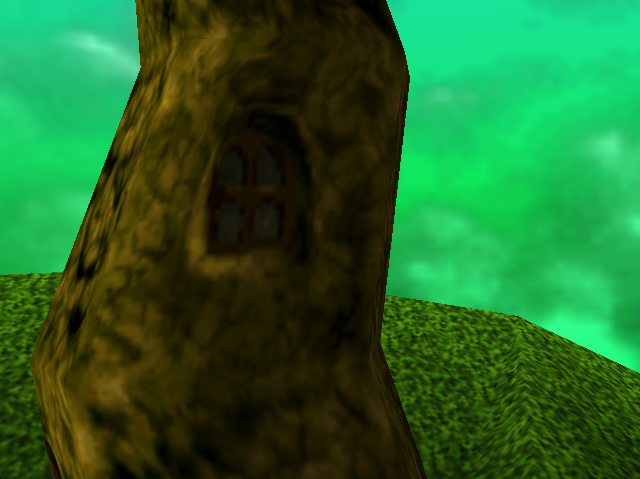
![]()
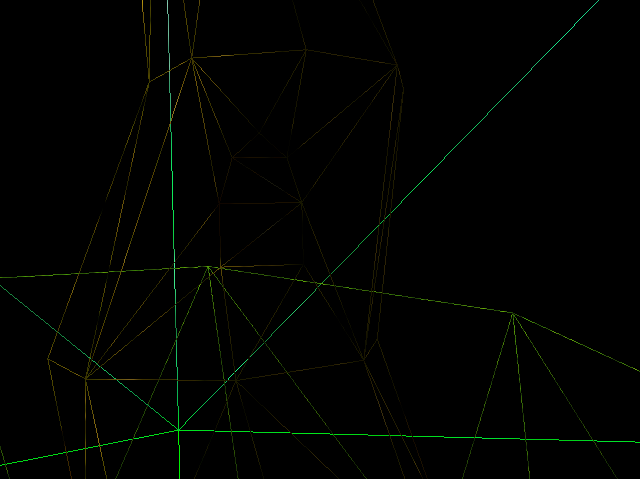
![]()
![]() [View Fullsize Image]
[View Fullsize Image]![]() [View Fullsize Image]
[View Fullsize Image]
The final curiosity that Banjo-Tooie presented was found in another unused area referred to as “Glowbo Cave” in the games data. Since its namesake is shared with the magical creatures that provide transformations, and the Mega-Glowbo had been previously tied to Stop ’N’ Swop with the Ice Key, it’s been speculated that Glowbo Cave might have harbored a number of the creatures that could be collected and taken to Humba Wumba for bonus transformations – as seen previously with Dragon Kazooie.
Since the location of the “Glowbo Cave” text is found under the addresses of areas found in the final level, Cloud CuckooLand, the most likely candidate for the entrance of the cave is thought to be on the purple cliff edge near the top of the mountain. Where one might expect to find a cave opening is a large crack traveling down the center of the surface – despite its visible fissure hinting at an explosive solution, no Grenade Egg is capable of blasting through the split. With its only other purpose serving as a ledge for one of the Eyeballus Jiggium Plant, it seems that there’s more to meet the eye…
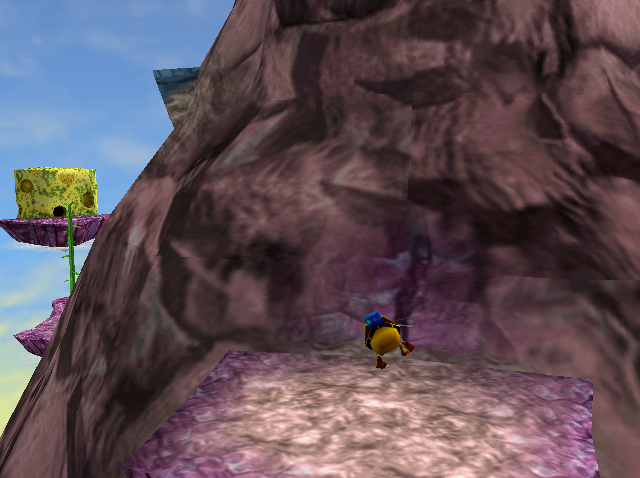
![]()
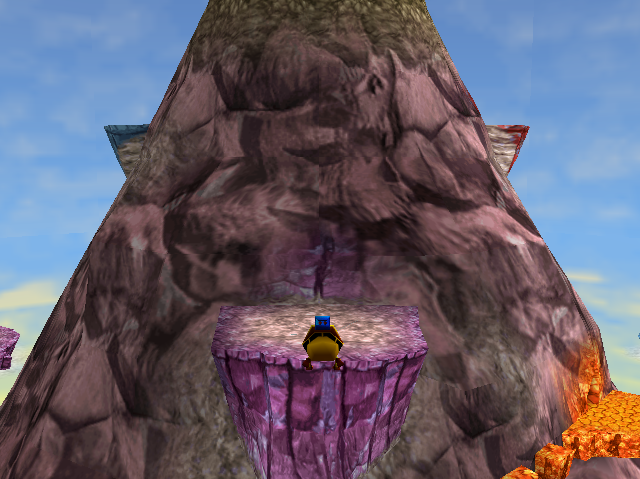
![]()
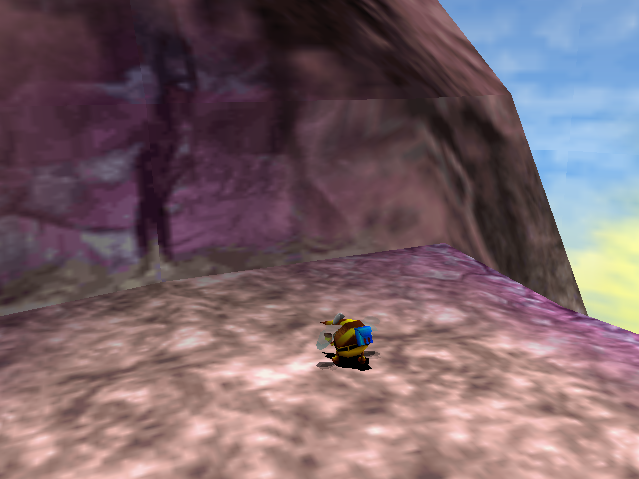
![]()
![]() [View Fullsize Image]
[View Fullsize Image]![]() [View Fullsize Image]
[View Fullsize Image]![]() [View Fullsize Image]
[View Fullsize Image]
While it was originally thought that the Stop ’N’ Swop feature was only intended for the Banjo-Kazooie series, Rare had actually planned to include other titles that were being developed at their studio. One title that still includes remnants of Stop ’N’ Swop is Donkey Kong 64, which was developed congruently with the Banjo titles, and released in 1999, just a year after the feature had been announced.
Evidence of an initial connection could be found in pre-release screenshots of Banjo-Kazooie and Donkey Kong 64 where they appeared as cameos in the starting areas in either game. In Banjo-Kazooie, the portrait of Donkey Kong could be seen hanging in Banjo’s house where its original location would have been seen just behind the first file selection screen. In Donkey Kong 64, the Treehouse would have featured a large object in the corner of the room speculated to be a refrigerator/locker/shower stall with the prominent profiles of Banjo and Kazooie on its side.
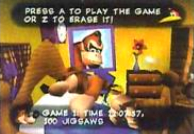
![]()
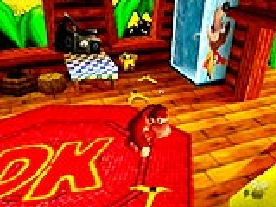
![]()
Although these features had been removed when both games had been released, evidence towards their true purpose and inclusion still exists in their respective games. In Banjo-Kazooie, the portraits seen in Banjo’s house are just meant to serve as some background scenery, except for one hanging over the fireplace which can be interacted with in order to prompt a secret ‘moving picture’ mini-game known as ‘Bottles Bonus‘. While the short-sighted mole finds himself the host of this particular game (as the title implies), this wasn’t always the case – an early screenshot of the third file selection screen shows that Tooty’s portrait was originally in this spot, and a bit of overseen dialogue implies that the shuffle would have seen Donkey Kong hosting the game instead. Attempting to speak to Bottles’ portrait prior to collecting the Sandcastle Jiggy in Treasure Trove Cove will have the mole turn the duo away until they’ve done so, spurring an insult from a demanding Kazooie who squawks, “Tell us now, Barrel Boy!”. This taunt is a little lost on Bottles, but it would absolutely hit the mark if it were the notorious barrel-throwing Donkey Kong at the helm instead.
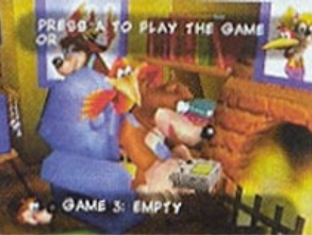
![]()
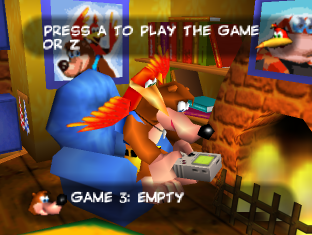
![]()
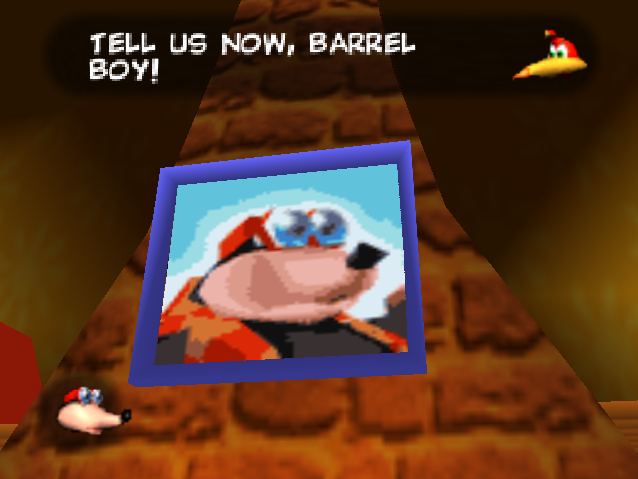
![]()
![]()
In Donkey Kong 64, the removed Banjo-Kazooie refrigerator/locker/shower stall’s function can still be accessed in the game, and its implications in doing so provide an undeniable link to Stop ’N’ Swop. Through manipulating the games cinematic feature with the Mystery Menu’s ‘DK Theatre’ mode and exploiting a glitch on a new file, it’s possible to uncover an unused cutscene meant to take place in DK’s Treehouse.

![]() The cutscene begins with a sweeping pan across the interior of the Treehouse, stopping to fixate on the exact location where the refrigerator/locker/shower stall would have been – after a few seconds (likely to show the object opening and Donkey Kong walking inside of it in a lost animation) the game transitions from the Treehouse and into the ice region of Crystal Caves where Donkey Kong now re-appears. Players familiar with Crystal Caves would have remembered this area being walled off with a thick sheet of glazed ice near the beginning of the level, much in a similar manner that the Ice Key could be seen in Banjo-Kazooie.
The cutscene begins with a sweeping pan across the interior of the Treehouse, stopping to fixate on the exact location where the refrigerator/locker/shower stall would have been – after a few seconds (likely to show the object opening and Donkey Kong walking inside of it in a lost animation) the game transitions from the Treehouse and into the ice region of Crystal Caves where Donkey Kong now re-appears. Players familiar with Crystal Caves would have remembered this area being walled off with a thick sheet of glazed ice near the beginning of the level, much in a similar manner that the Ice Key could be seen in Banjo-Kazooie.
Fortunately, this would only pose a minor obstacle, as Chunky Kong’s ‘Primate Punch’ ability was enough to shatter the ice and allow progress beyond. Inside the area, players could find three Yellow Banana Coins and a Yellow Banana Balloon for Donkey Kong, as well as a few Green Bananas and a ‘Gorilla Gone’ pad for Chunky Kong. Stepping on the Gorilla Gone pad and activating the ability to become invisible will immediately surrender a Golden Banana just a few feet away; a bit of an oddity considering the more loftier challenges in Crystal Caves.
It wouldn’t be out of the question to theorize that this location originally held greater significance despite its current lackluster offering – approaching the wall at the left side of the cavern where Donkey Kong was set to re-appear will cause the games camera to reposition as though the player would have been able to travel forward from this point.
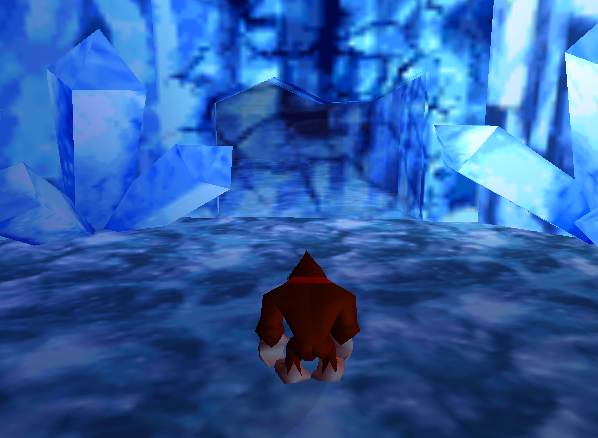
![]()
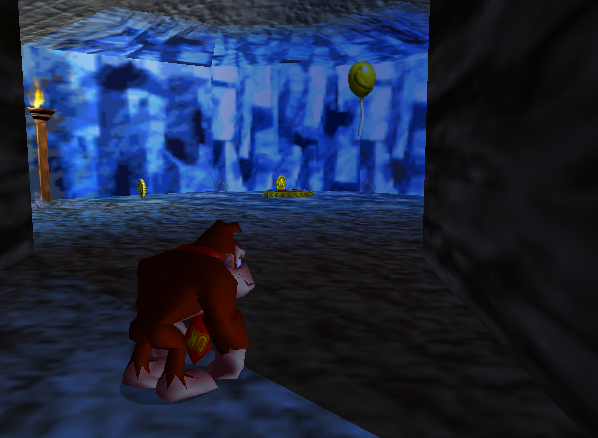
![]()
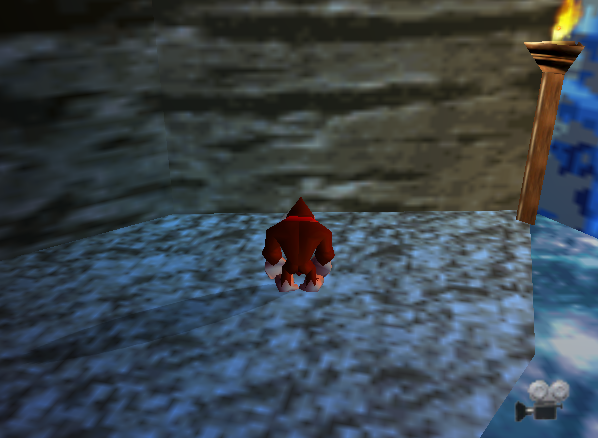
![]()
![]() [View Fullsize Image]
[View Fullsize Image]![]() [View Fullsize Image]
[View Fullsize Image]![]() [View Fullsize Image]
[View Fullsize Image]
Due to the removal of Stop ‘N’ Swop occurring so late in Donkey Kong 64’s development, the publication of the strategy guide from Nintendo of Europe references the original map for Crystal Caves (left) where an extra chamber can be seen to the north of the room, which the map from Nintendo of America has removed entirely (right).
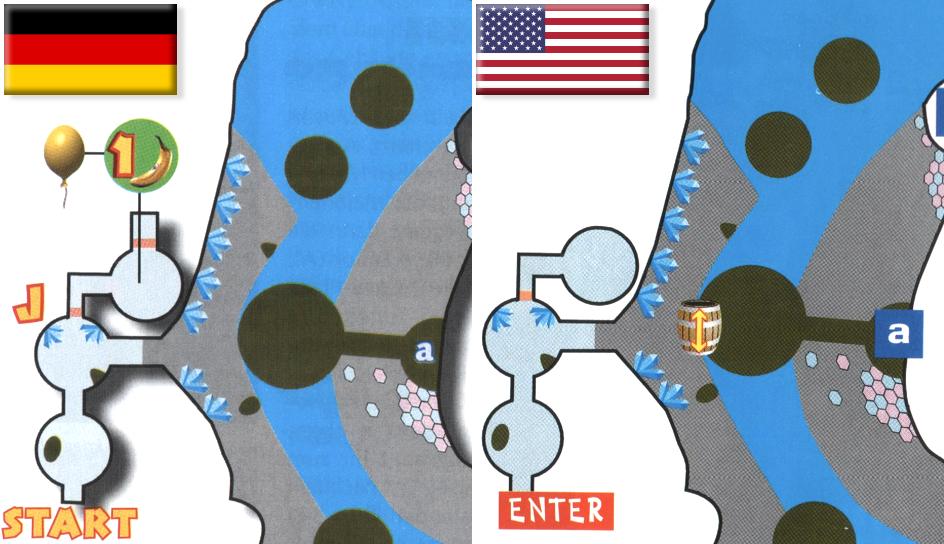
It’s assumed therefore, that players would have originally ventured into Chunky’s area after destroying the first glazed wall, only to arrive at a second impassable wall where a secret item could be glimpsed in a chamber just beyond. Unable to collect this item, players would have drawn inevitable comparisons to the Ice Key from Freezeezy Peak in Banjo-Kazooie.
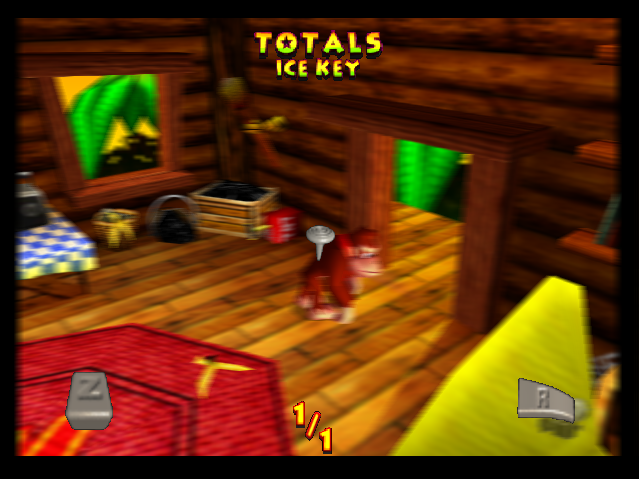
![]() This connection between the two titles would receive further evidence when enthusiasts began to search through the code for Donkey Kong 64 for any trace or mention of Stop ’N’ Swop. Their efforts would pay off dramatically when it was discovered that the Totals Menu at one point was meant to display the “Ice Key” as a collectible object, with ‘1/1’ as its realized aggregate. It would be fair then to summarize that at some point during the development of both games, the Stop ’N’ Swop process originally featured a step wherein the Ice Key was to be transfered from Banjo-Kazooie to Donkey Kong 64 for use in Crystal Caves.
This connection between the two titles would receive further evidence when enthusiasts began to search through the code for Donkey Kong 64 for any trace or mention of Stop ’N’ Swop. Their efforts would pay off dramatically when it was discovered that the Totals Menu at one point was meant to display the “Ice Key” as a collectible object, with ‘1/1’ as its realized aggregate. It would be fair then to summarize that at some point during the development of both games, the Stop ’N’ Swop process originally featured a step wherein the Ice Key was to be transfered from Banjo-Kazooie to Donkey Kong 64 for use in Crystal Caves.
Another mysterious area that seems to have been revised was found in the penultimate world, Creepy Castle. If players found their way into the Museum as Chunky Kong, they would be able to locate a pillar seen through a thick pane of glass.
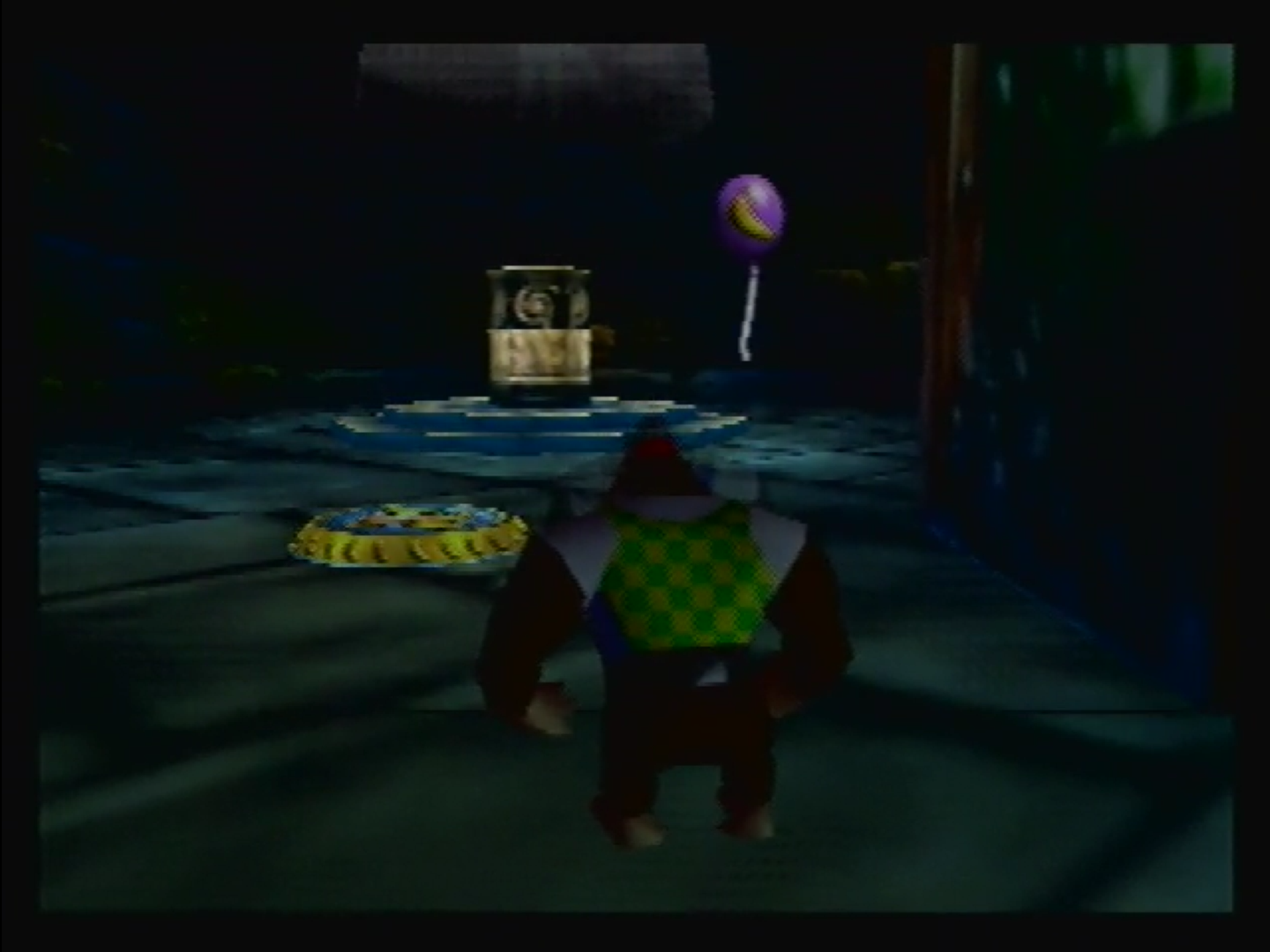
Without any means to smash the window and access the display room, a hint would be given with the appearance of Tiny’s ‘Monkeyport’ Pad on the other side. Venturing into the Ballroom as Tiny Kong would allow players to discover the first Monkeyport Pad in the sequence, which would grant them the ability to instantly warp to its counterpart, found in an adjacent room in the Museum. From here, they could find a third Pad which would complete the connection, transporting them to the fourth just beyond the glass.
Curiously, the only feature in this area to be interacted with was a single purple Banana Balloon that drifted around the room, which Tiny could pop to add 10 Purple Bananas to her collection. Given that these balloons can already be found throughout Creepy Castle in the open, it does seem rather odd that an entire room would be created and dedicated for the sole reason of housing it.
It also seemed odd that the pillar didn’t feature an object on ‘display’, as one might expect in a Museum.
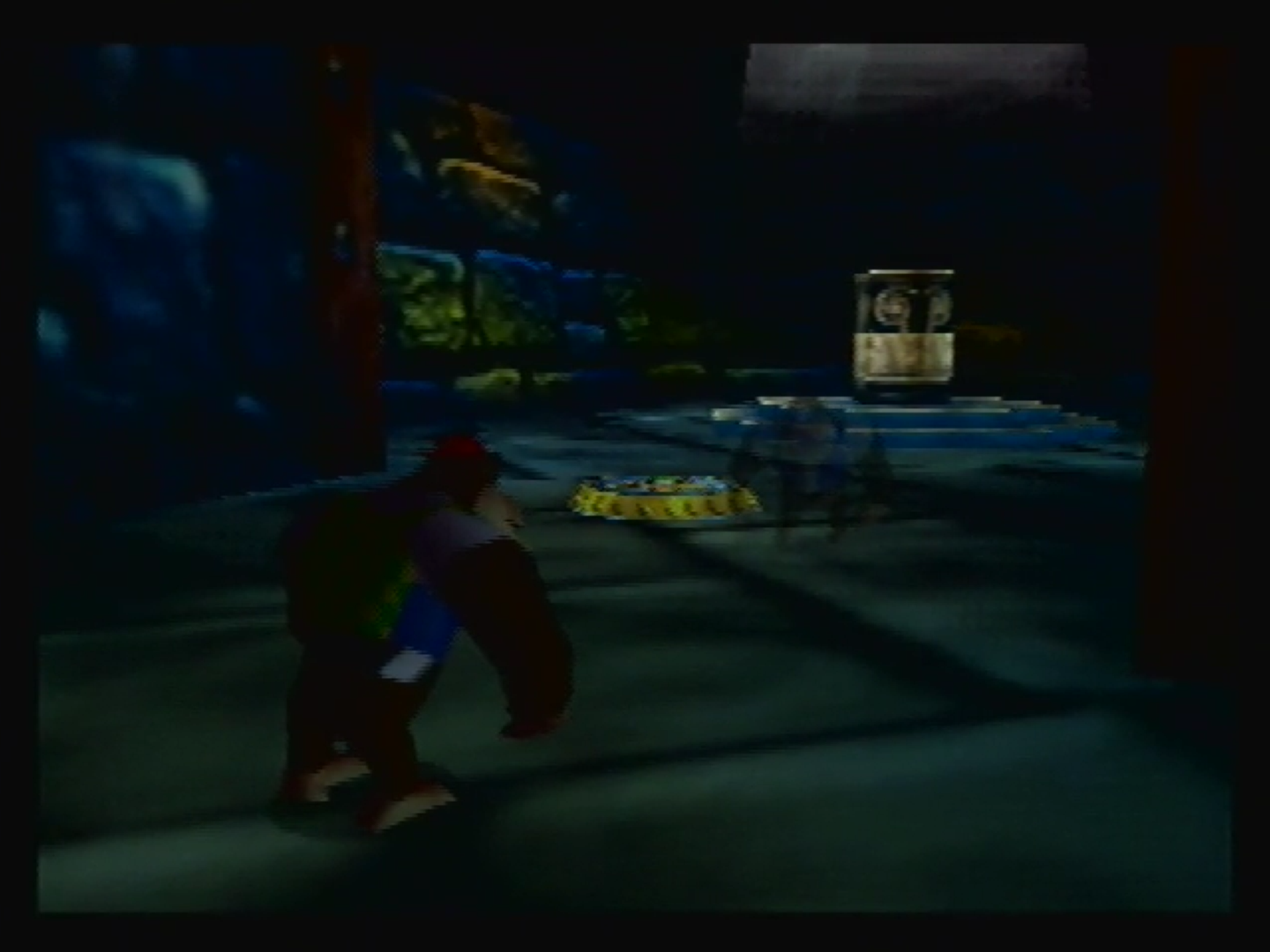
![]()
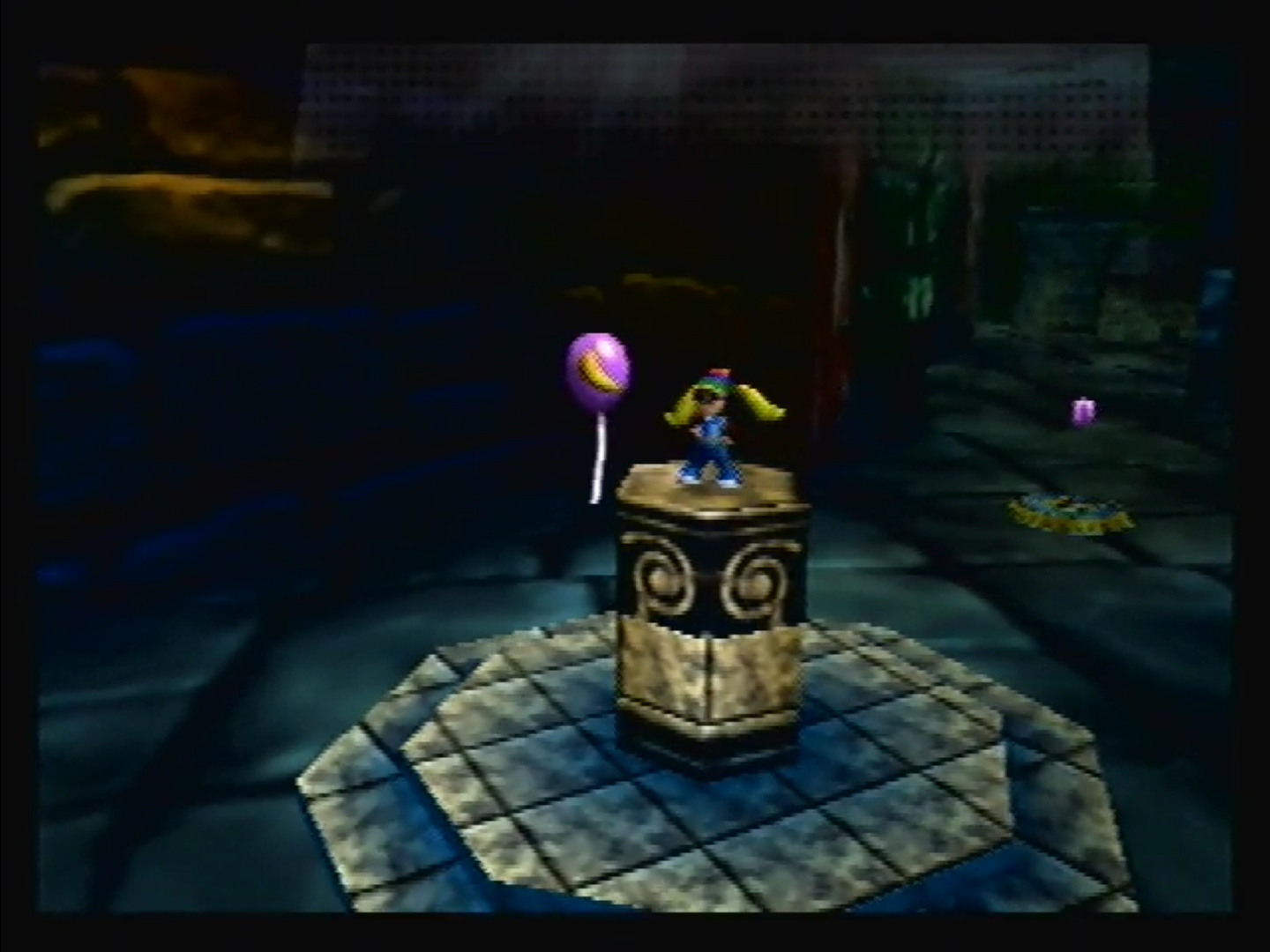
![]()
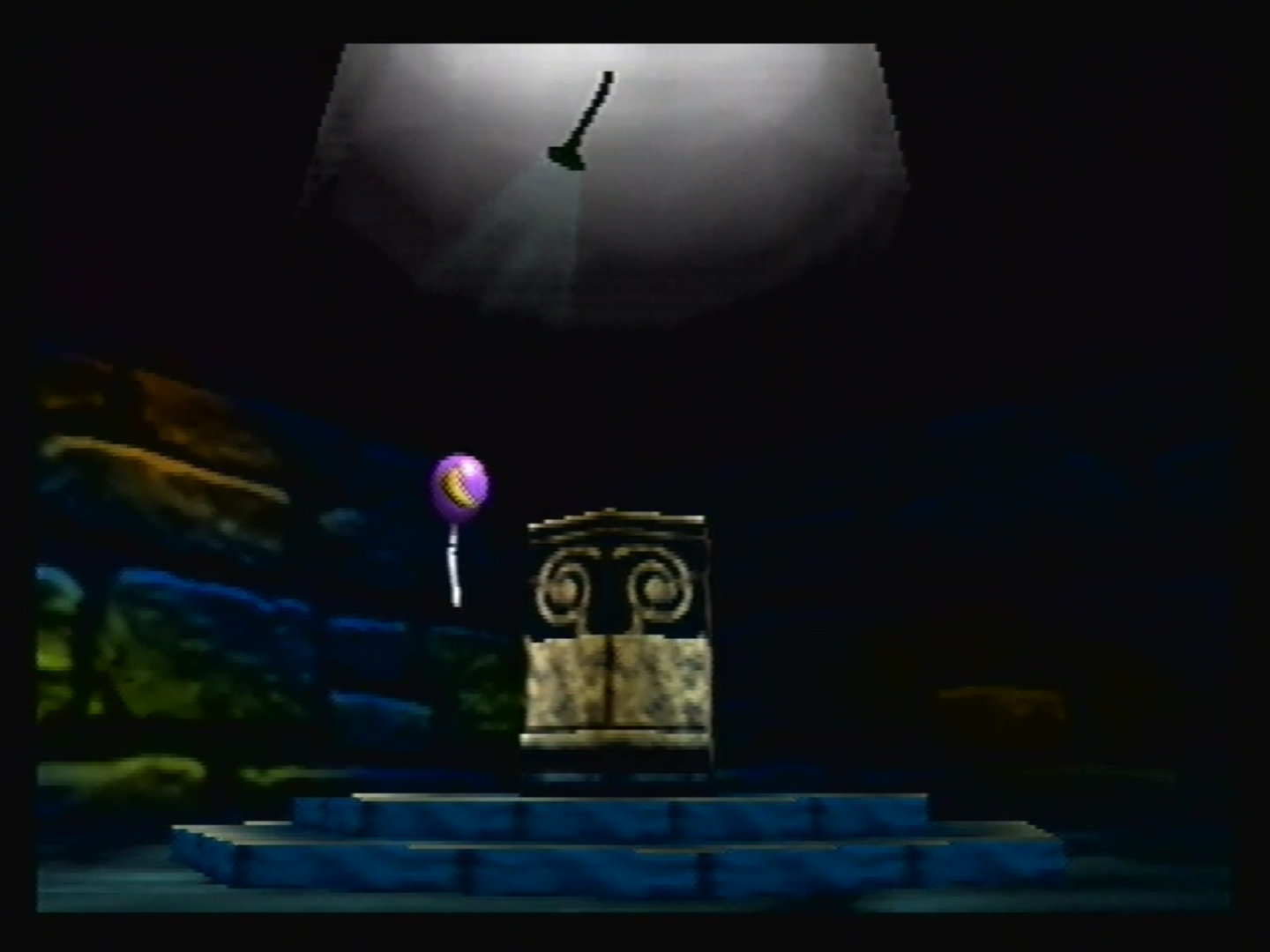
![]()
![]() [View Fullsize Image]
[View Fullsize Image]![]() [View Fullsize Image]
[View Fullsize Image]![]() [View Fullsize Image]
[View Fullsize Image]
Players that had encountered the mysterious feature couldn’t shake the assumption that there was just something more to do in this area, and so they took to asking Rare through their ‘Uncle Tusk’ submission, which typically dispatched advice and insight through their official website via the Killer Instinct character.
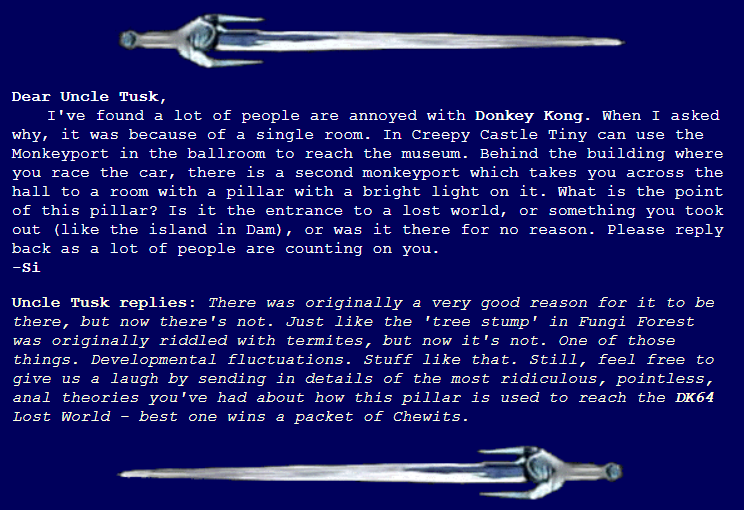
To surmise the response above, the pillar did at one point serve a function within Donkey Kong 64, but due to ‘developmental fluctuations’, this function was forced to be removed.
Luckily, in a similar manner to the Crystal Caves Chamber, this late change was subsequently missed and thereby preserved in the strategy guide from Nintendo of Europe as well. While the North American readers would arrive to a page where the pillar’s room was conspicuous empty (right), readers from Germany would see an illustration of the pillar, topped with a large golden bust of Donkey Kong (left).
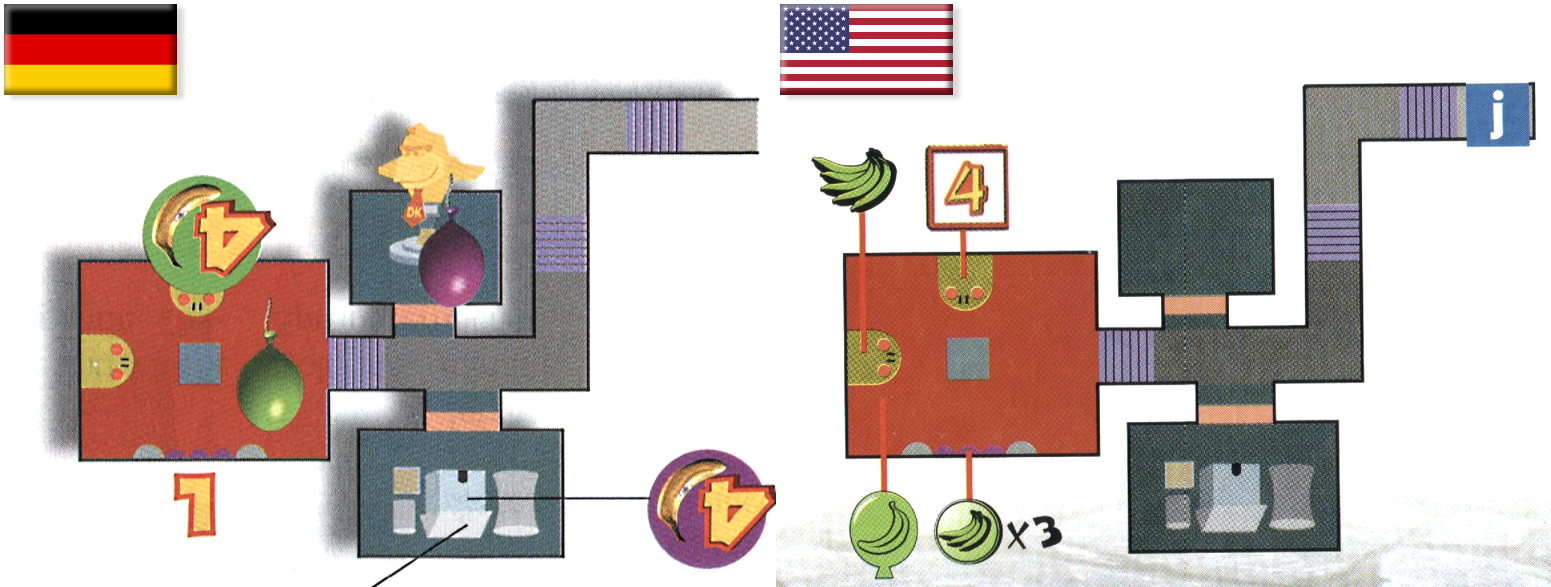
It’s unknown if this golden statue/trophy was meant to be collected, or spoken to as an NPC, but it would suggest that the Monkeyport solution given in the realized version of Donkey Kong 64 wasn’t the intended method of arriving in this room. It’s far more likely that the object would have remained tauntingly out of reach – just like the Ice Key – requiring players seeking to collect it to use Stop ‘N’ Swop to find their way inside. Given that the Crystal Caves chamber and the Creepy Castle pillar were the only two redacted maps in the entire German Donkey Kong 64 strategy guide, it stands to reason that the removal of Stop ‘N’ Swop lead to both areas losing their intended purpose, with the Ice Key and the Donkey Kong Statue remaining forever uncollected.
One final sticking point to the proposed connection exists in the games musical score, where both games were overseen by composer Grant Kirkhope. In Banjo-Kazooie, entering an area housing a Stop ’N’ Swop item will cause a celebratory fanfare to trumpet. Depending on the level accessed, the score will then deviate to a specialized track reflecting its theme; Mad Monster Mansion has a haunting celebratory tune, whereas Gobi’s Valley flaunts a suiting Egyptian sounding variation.
Until the Sandcastle Codes were discovered, these tunes were effectively silenced, as even using the levitation exploit to grab the Ice Key prior would not trigger the fanfare – in the interim Donkey Kong 64 was released and featured it’s own variation of the celebratory fanfare when Scoff N’ Troff unlocked a boss door in any level. While Banjo-Kazooie had been the originator of the fanfare, it would be heard first by players chronologically a year later in Donkey Kong 64.
A direct comparison of the fanfare in both games can be found using the playlist below.
DEVELOPER INSIGHT INTO STOP ’N’ SWOP
As much investigation as Stop ’N’ Swop had garnered since its discovery, enthusiasts were left without knowledge of how the feature was meant to function. What was known for sure was that a collection of secret items could be found in one game, and then were somehow ‘whisked away’ to another. Keeping to its trademark secrecy, Rare had remained rather tight-lipped in the few years proceeding Banjo-Tooie, perhaps allowing fans to engage in speculation and mystery on their own terms. This would continue until November 16th, 2004 when a patent filed by Rare founder Tim Stamper along with Banjo-Kazooie‘s programmer, Paul Machacek in 1999 had been published online.
US Patent 6820265B1, or, “System method and data storage medium for sharing data between video games” was the Rosetta Stone to Stop ’N’ Swop’s functionality – a detailed breakdown that elaborated every technical step of the proposed feature was now readily available for anyone to read.
The first bit of enlightenment that the Patent provided was why the unlockable menu was called “Stop ’N’ Swop” in the first place. As detailed in the documentation, the intended function of transferring the Ice Key and Mystery Eggs would have involved “Hot Swapping” and “Cold Swapping”. Both variations involved players ‘stopping’ to remove a Nintendo 64 cartridge at a predestined point and very quickly ‘swapping’ it out with another – if done correctly, the memory of the first cartridge would be retained in the console for a short window of time, and could be utilized by the second cartridge to effectively transfer the memory over from one game to another.
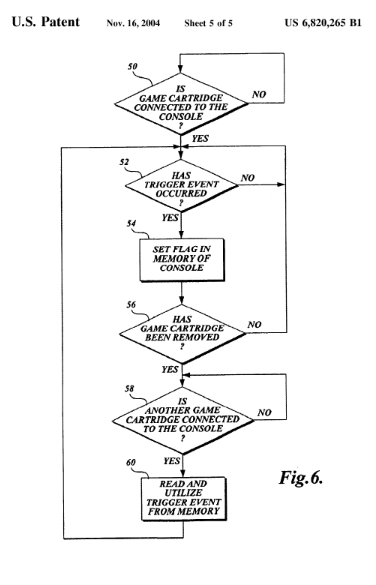 The distinction between swapping “hot” or “cold” was entirely dependent on whether the console was to remain on or off during the transfer; if Stop ’N’ Swop utilized hot swapping, players would remove the cartridge after fulfilling a set of requirements in the middle of play, keeping the Nintendo 64 processor active during the task of switching games. Conversely, if Stop ’N’ Swop utilized cold swapping, players would turn the power off after fulfilling a set of requirements and then swapping out the cartridge so that the memory retained by the Nintendo 64 processor was still viable even without a direct source of power. The patent also takes great care to provide a hypothetical scenario involving a “Huge Blocked Icy Cave with a key-hole” existing in one game and a “Big Icy Key” existing in another, a familiar notion to anyone who had managed to catch a glimpse of the Ice Key in Banjo-Kazooie. Once the player had fulfilled the requirement of the “Huge Blocked Icy Cave” in the second game (in this case, pulling a lever), the game would remember this act, sending new information (or flag) to the Nintendo 64’s memory. After managing to Stop ’N’ Swop their cartridges, players could return to the first game and discover the inaccessible area that had contained the “Big Icy Key” had been affected by the lever, providing players with the ability to collect it without issue. Once the “Big Icy Key” had been collected, another flag would have been written to the memory allowing the players to Stop ’N’ Swop again, this time transferring the Key to the second game where it could finally be used to unlock the “Huge Blocked Icy Cave”.
The distinction between swapping “hot” or “cold” was entirely dependent on whether the console was to remain on or off during the transfer; if Stop ’N’ Swop utilized hot swapping, players would remove the cartridge after fulfilling a set of requirements in the middle of play, keeping the Nintendo 64 processor active during the task of switching games. Conversely, if Stop ’N’ Swop utilized cold swapping, players would turn the power off after fulfilling a set of requirements and then swapping out the cartridge so that the memory retained by the Nintendo 64 processor was still viable even without a direct source of power. The patent also takes great care to provide a hypothetical scenario involving a “Huge Blocked Icy Cave with a key-hole” existing in one game and a “Big Icy Key” existing in another, a familiar notion to anyone who had managed to catch a glimpse of the Ice Key in Banjo-Kazooie. Once the player had fulfilled the requirement of the “Huge Blocked Icy Cave” in the second game (in this case, pulling a lever), the game would remember this act, sending new information (or flag) to the Nintendo 64’s memory. After managing to Stop ’N’ Swop their cartridges, players could return to the first game and discover the inaccessible area that had contained the “Big Icy Key” had been affected by the lever, providing players with the ability to collect it without issue. Once the “Big Icy Key” had been collected, another flag would have been written to the memory allowing the players to Stop ’N’ Swop again, this time transferring the Key to the second game where it could finally be used to unlock the “Huge Blocked Icy Cave”.
Given that the patent was drafted during the same development window for both Banjo-Kazooie and Donkey Kong 64, it’s entirely possible that Rare was already testing the transferring capabilities of the Nintendo 64 during this time, especially when the hypothetical example above could be ostensibly recreated with features in both games. After all, the Big Icy Key may be an obvious nod to a similar hidden secret found in Banjo-Kazooie, but so too is the ability to pull and manipulate levers as seen with Donkey Kong’s Gorilla Grab move in Donkey Kong 64. If the “Huge Blocked Icy Cave” was previously featured in Crystal Caves before it underwent an overhaul then the patents example would truly come full circle.
NINTENDO TECHNICAL SUPPORT & DONKEY KONG 64
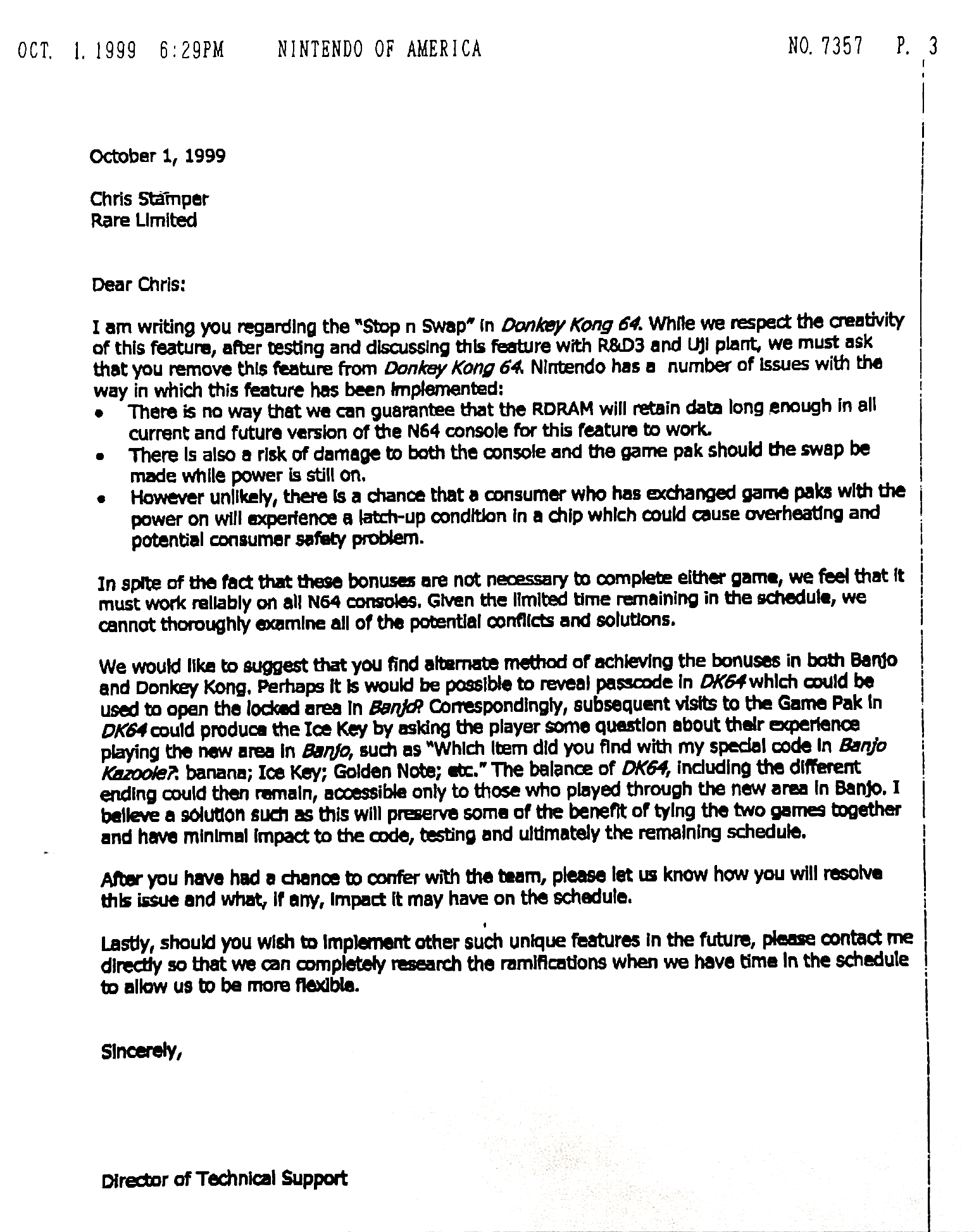 If the cartridge swapping methods that the Stop ’N’ Swop patent outlined were a viable means to transfer information across different Rare titles, why exactly was the feature dropped after the release of Banjo-Kazooie? Thanks to lead engineer, Paul Machacek, we have access to a fax print-out that documents the cancelation of the feature. While Banjo-Kazooie had been released in 1998 with the Stop ‘N’ Swop feature intact, Nintendo’s Director of Technical Support would raise issue during development of Donkey Kong 64 in 1999, citing the potential troubleshooting issues that players might experience. Namely, it was a combination of having players potentially damaging their cartridges during the swap and differences between versions of Nintendo 64 hardware that would have introduced too many variables in reliably transferring data. In fact, Nintendo 64 models produced after 1999 underwent a series of hardware revisions in order to improve functionality of the console – one such revision drastically reduced the available window of time that the memory would have remained viable during hot and cold swapping, rendering the feature obsolete in those versions of console.
If the cartridge swapping methods that the Stop ’N’ Swop patent outlined were a viable means to transfer information across different Rare titles, why exactly was the feature dropped after the release of Banjo-Kazooie? Thanks to lead engineer, Paul Machacek, we have access to a fax print-out that documents the cancelation of the feature. While Banjo-Kazooie had been released in 1998 with the Stop ‘N’ Swop feature intact, Nintendo’s Director of Technical Support would raise issue during development of Donkey Kong 64 in 1999, citing the potential troubleshooting issues that players might experience. Namely, it was a combination of having players potentially damaging their cartridges during the swap and differences between versions of Nintendo 64 hardware that would have introduced too many variables in reliably transferring data. In fact, Nintendo 64 models produced after 1999 underwent a series of hardware revisions in order to improve functionality of the console – one such revision drastically reduced the available window of time that the memory would have remained viable during hot and cold swapping, rendering the feature obsolete in those versions of console.
While an option to include the passcode/Sandcastle Cheat for Banjo-Kazooie‘s Ice Key in Donkey Kong 64 was offered to link the games in a more traditional guise, including an alternate ending that would have been dependent on the Ice Key, Rare had ultimately decided to remove any connection between the two titles, choosing to only reference Stop ‘N’ Swop’s mystery items in the successor, Banjo-Tooie.
THE SIX RARE STOP ‘N’ SWOP TITLES/THE INTERVIEW WITH PAUL MACHACEK
On April 10th, 2020, Rare Gamer had the opportunity to discuss the development of Stop ‘N’ Swop with Paul Machacek. In addition to learning how Stop ‘N’ Swop was devised and accomplished on a technical level, Mr. Machacek also revealed that the scope for Stop ‘N’ Swop would have involved more than the Banjo-Kazooie series and Donkey Kong 64, encompassing a total of six Rare titles with a plan to have the Ice Key as the final reward:
“We had a picture of a group of six games in our minds that could be linked. I suggested, “Wouldn’t it be great if we could go full-circle and if a player got all six, and we sent triggers sequentially between them, then the last game could send a super-code back to the first?” That may have been why the Ice Key replaced an Egg for Banjo-Kazooie.”
So, which of Rare’s Nintendo 64 titles were intended to be involved in the Stop ‘N’ Swop process? Once again, Paul Machacek has graciously provided us with an answer:
“The games I know were intended to be included were Banjo-Kazooie, a Banjo-Kazooie successor [Tooie], Twelve Tales: Conker 64 & Donkey Kong 64. I think the other two that were mooted were Jet Force Gemini and Perfect Dark.
In order to have cohesion between all of the Stop ‘N’ Swop titles regardless of their genre, the Mystery items apart from the Ice Key were conceptualized as “generic Easter Eggs”, with each game serving to chain to the next.
RARE REVEALED: THE MAKING OF BANJO-KAZOOIE
The cancellation of Stop ‘N’ Swop and the wider scope of its original plan were both acknowledged during the “Dreaming of Banjo” behind-the-scenes feature in Rare’s thirty game compilation Rare Replay.
Explaining the function of the secret feature, lead programmer, Chris Sutherland recollects Nintendo’s hesitancy towards the feature and their eventual request for its removal. Game Designer, Gregg Mayles, adds to this, eluding to Stop ‘N’ Swop’s original plan to encompass a number of Rare titles outside the Banjo-Kazooie series, while clips of Jet Force Gemini, Conker’s Bad Fur Day and Perfect Dark are shown simaltaneously.
STOP ’N’ SWOP IN BANJO-KAZOOIE: NUTS & BOLTS
BANJO-KAZOOIE XBLA CONNECTIONS
Eight years after the launch of Banjo-Tooie, Rare released Banjo-Kazooie: Nuts & Bolts as the third entry into the series in 2008. As a bonus anniversary treat, players that pre-ordered the Xbox 360 title would receive a code to unlock the first Banjo-Kazooie game fully realized as an Xbox Live Arcade port with improved graphics, leaderboards and achievements. One final intriguing feature promised was the restored functionality of Stop ’N’ Swop, which would now be used to transfer the Mystery Eggs and Ice Key into Banjo-Kazooie: Nuts & Bolts to unlock mystery rewards.
When players started their XBLA adventure with a save game from Nuts & Bolts, they would discover that all of the locations that had hidden away the Mystery Eggs and Ice Key were now free to explore on the first pass. Akin to the original title, Banjo and Kazooie only exchanged dialogue for the first two Stop ’N’ Swop Eggs collected, though Banjo-Kazooie XBLA expanded on it, taking efforts to steer players in the right direction towards Banjo-Kazooie: Nuts & Bolts where they could be utilized. This was especially evident in the ending during Mumbo’s photograph showing which stayed largely unaltered from the original, only replacing any mention of Banjo-Tooie with Banjo-Kazooie: Nuts & Bolts.
Observant players of the third Banjo adventure might have noticed a few peculiar sights around the games overworld, Showdown Town – namely, that six large Mystery Eggs stylized with a Mumbo-Jumbo-esque question mark had been painted on rooftops, underground secret grottos and other keys areas of interest. Speaking of keys, a large indentation of one could also be seen atop the snowy roof of Boggy’s gym, near the Docks area of Showdown Town.
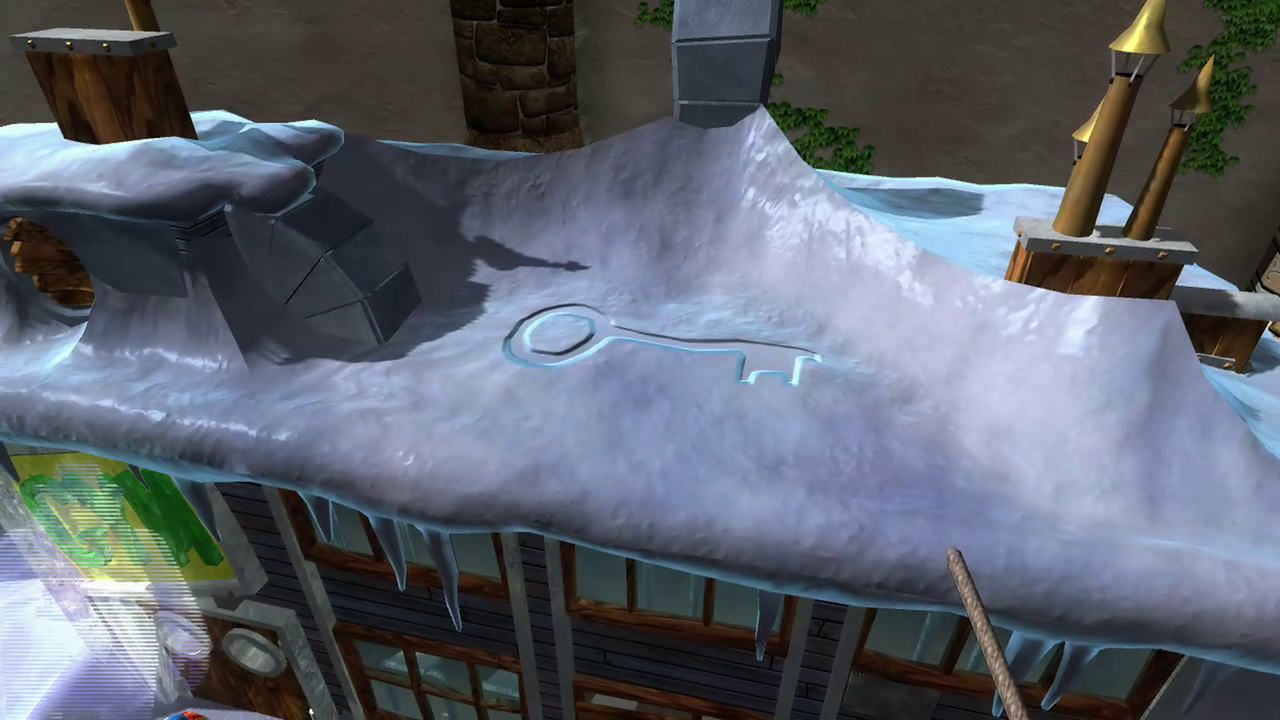
These areas would continue to remain dormant throughout the rest of the game unless players had access to a copy of the newly remastered Banjo-Kazooie XBLA title and managed to collect all of the Stop ’N’ Swop items. Once they had done so, their next trip to Showdown Town would be prefaced with a short cutscene showing that seven bonus Vehicle Crates had suddenly appeared in the aforementioned mystery locations.
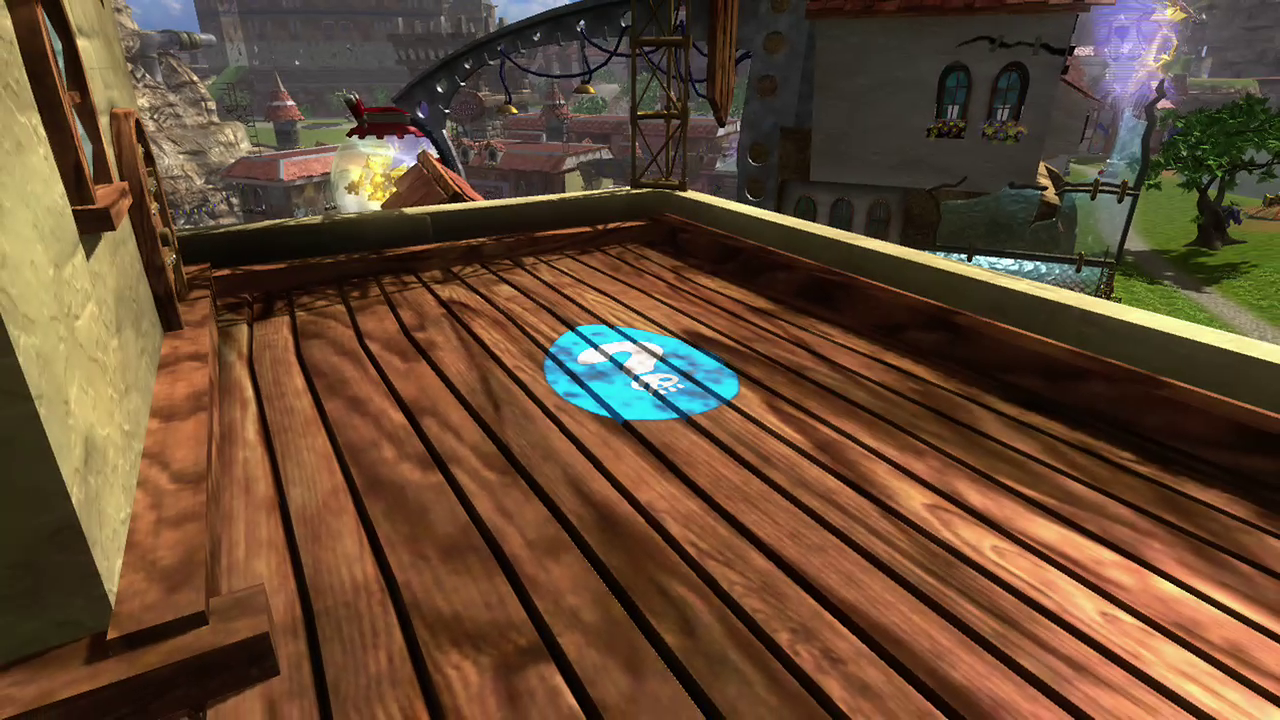
![]()
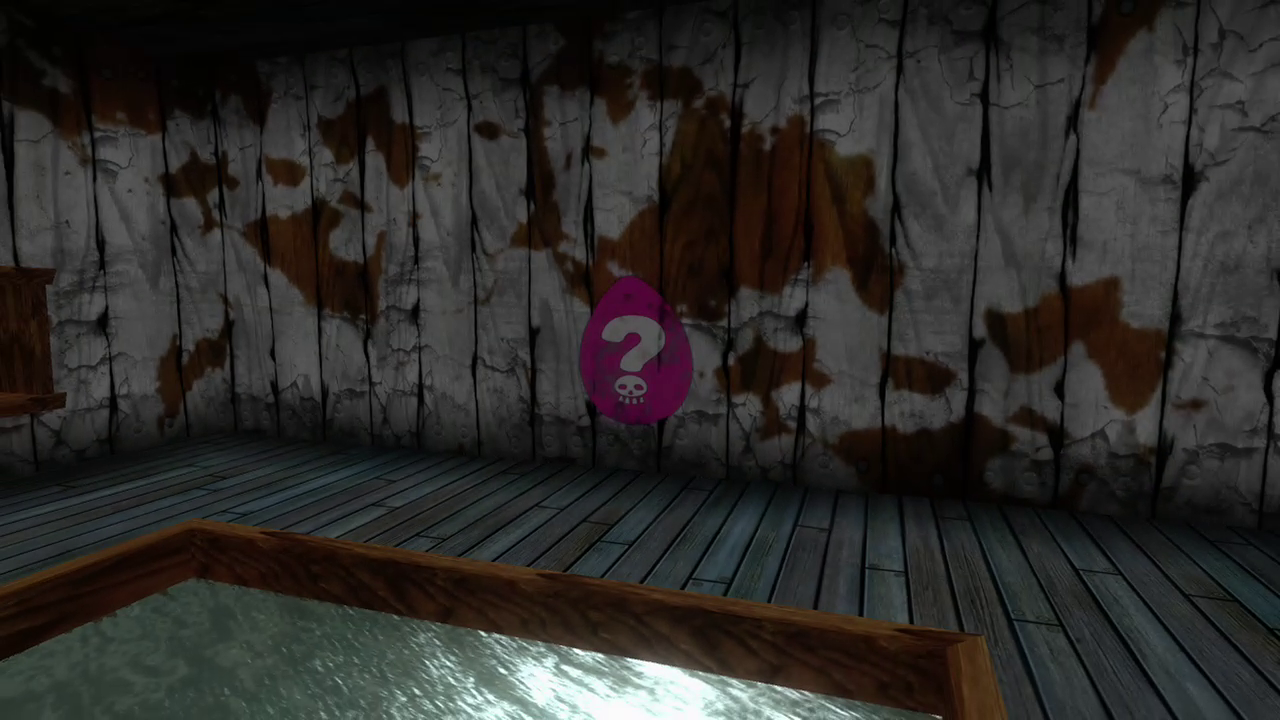
![]()
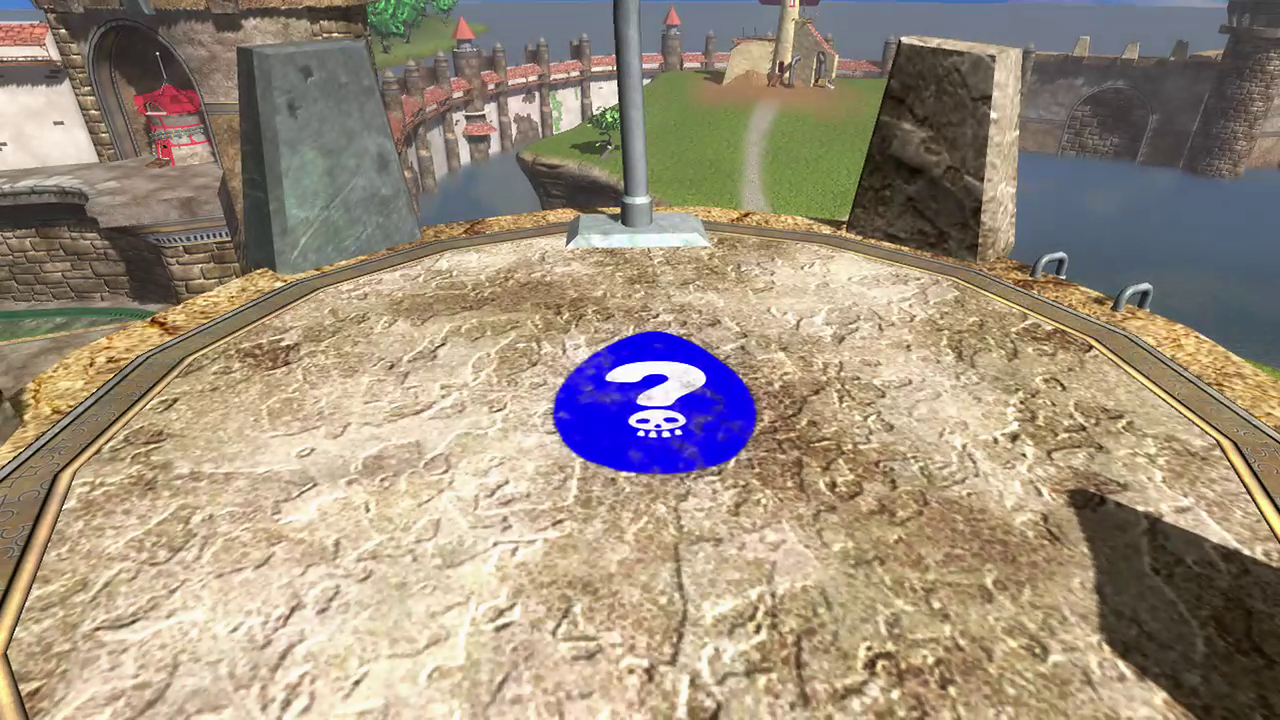
![]()
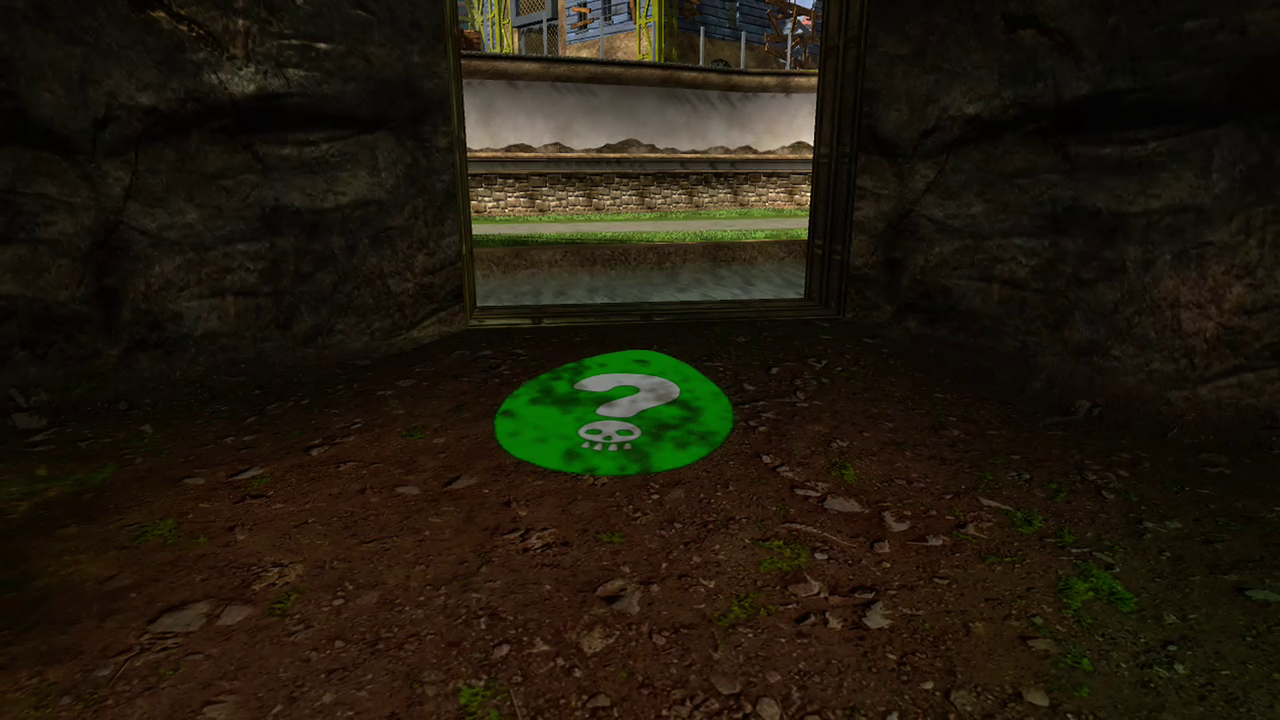
![]()
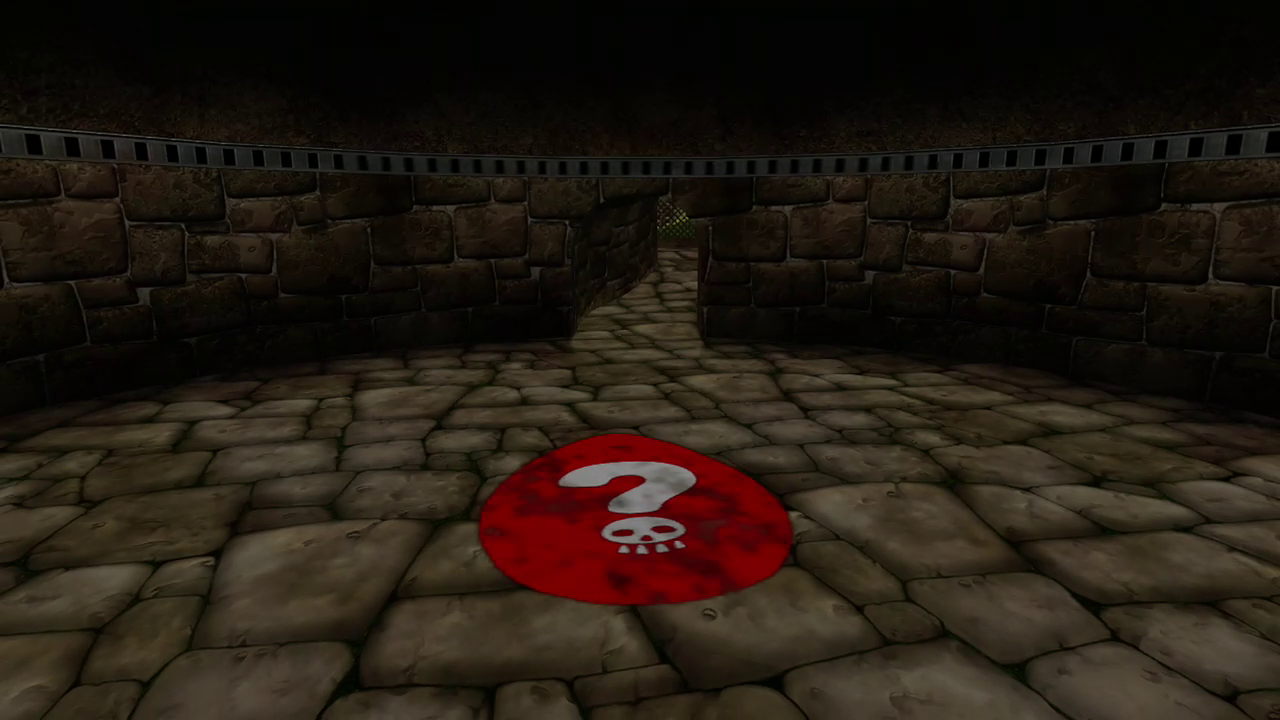
![]()
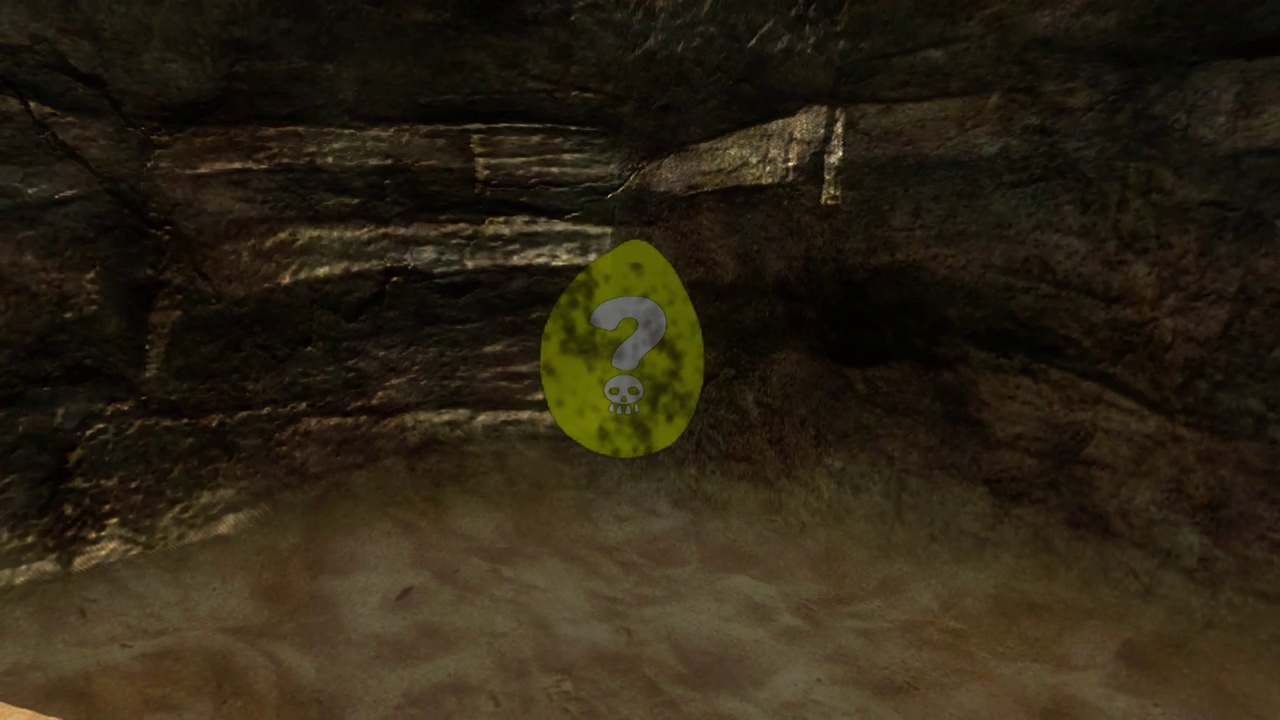
![]()
![]()
Recovering the Crates and returning them to Mumbo’s Motors in Showdown Town Square would unlock seven secret Vehicle parts that couldn’t be obtained anywhere else in the game – in true form to the original premise of rewards from Stop ’N’ Swop, these parts weren’t essential to completing the game, but were rather spiffingly desirable.
Retrieving the Cyan, Pink and Blue Egg Crates from their areas in Showdown Town would unlock the Mole-On-A-Pole, Fuzzy Dice and Goldfish respectively. Further flashy additions could be found by turning in the Green, Red and Yellow Egg Crates, which in turn presented the Beacon, the Disco Ball and Googly Eyes vehicle parts. Visiting the roof of Boggy’s Gym to fetch the Ice Key Crate would relinquish the final Stop ’N’ Swop reward with a pair of Union Jack flags.
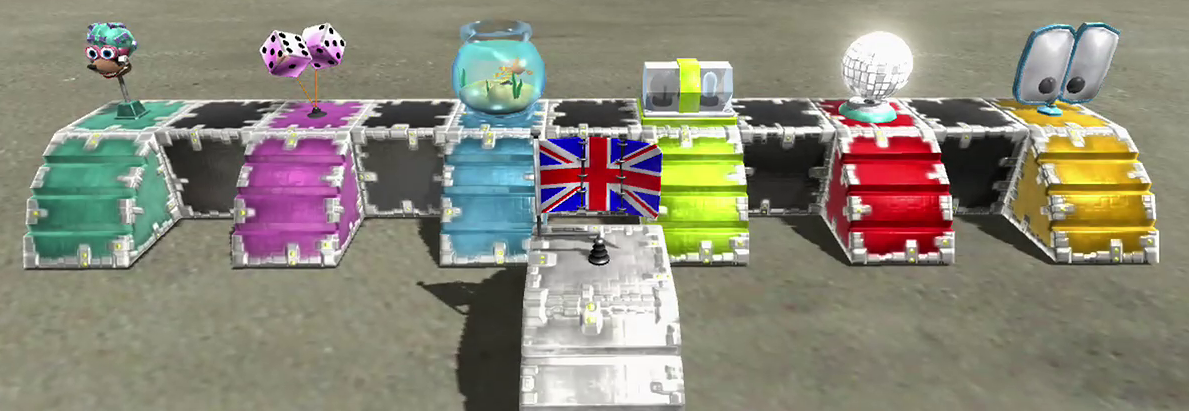
Rare wasn’t finished with their plans for incorporating Stop ’N’ Swop in Banjo-Kazooie: Nuts & Bolts however, as it served one additional purpose at the release of L.O.G’s Lost Challenges, a DLC pack released in 2009. Returning players that had completed the mystery item checklist in Banjo-Kazooie XBLA could find seven additional blueprints designed by previous Nuts & Bolts contest winners, essentially earning them their own copies of the prize winning vehicles. Navigating to the ‘Load Blueprint’ option in Mumbo’s Motors would introduce a new Stop ’N’ Swop section – inside, players could instantly load in the Rotating Turret, Carosel, Robot, Transformation Machine, Tank, Flying Beetle and Gruntling vehicles.
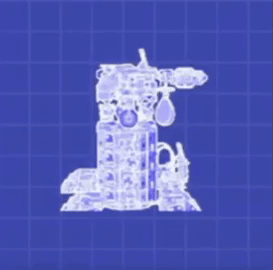
![]()
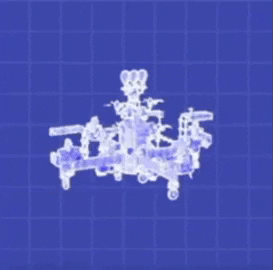
![]()
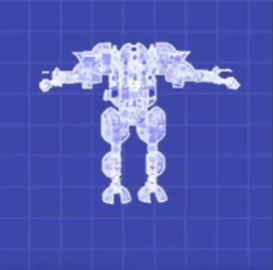
![]()
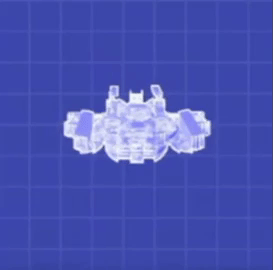
![]()
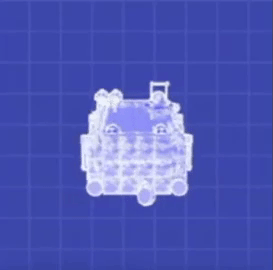
![]()
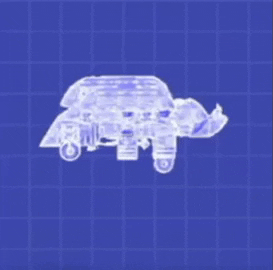
![]()
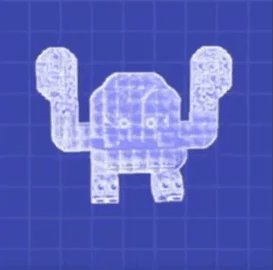
![]()
Released just weeks after the L.O.G’s Lost Challenges DLC on April 29th, 2009, Banjo-Tooie XBLA sought to update the Bear and Birds second adventure just as Banjo-Kazooie XBLA had done previously. Now with both titles on the same console, players would at last get a chance to transfer their mystery items between games – and they wouldn’t even need to use hot or cold swapping to do it. After starting Banjo-Tooie XBLA with the Stop ‘N Swop items collected, the framed portraits serving as the file selectors would be adorned with an ‘SNS’ logo, indicating that the feature could finally be used.
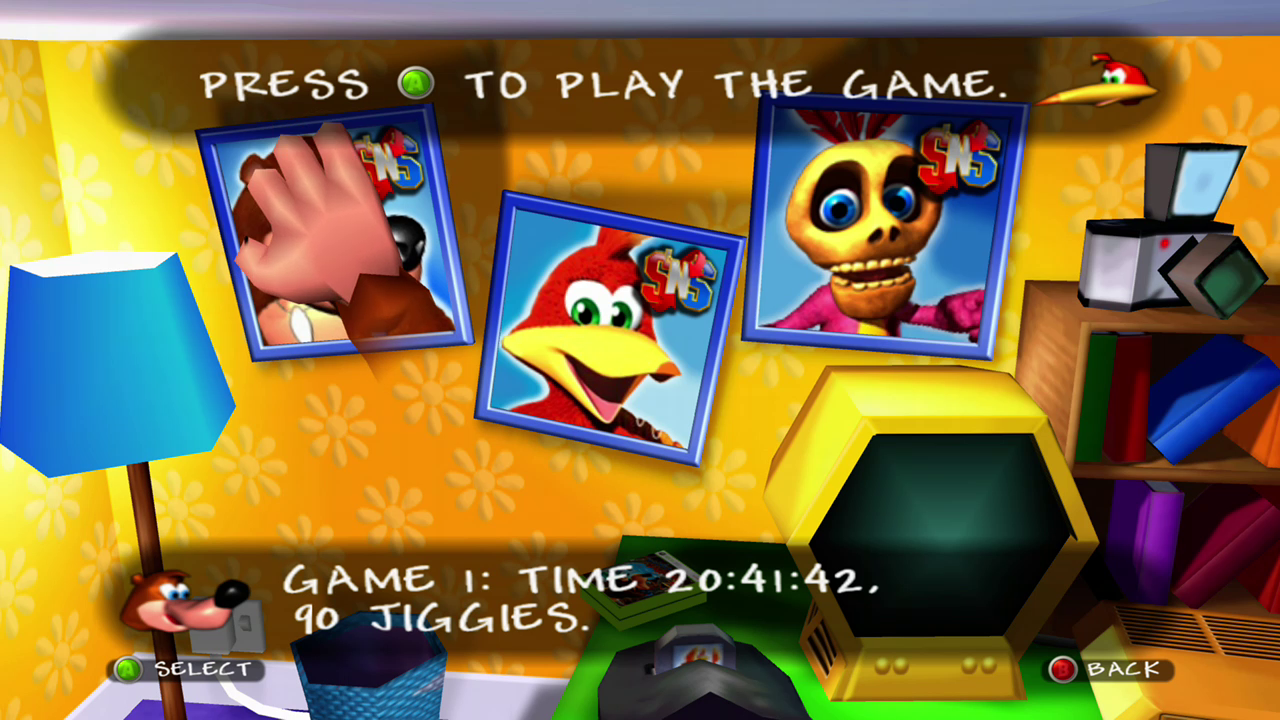
Selecting one of these files would allow players to skip the Game Pak bounty hunt established in the original Banjo-Tooie and instead head off to unlock their rewards firsthand. With an Ice Key carried all the way from Freezeezy Peak in their backpacks, players could once again unlock the frozen safe in Hailfire Peaks and then return the Mega-Glowbo found inside to Humba Wumba and earn the familiar Dragon Kazooie transformation. As for the six Mystery Eggs, they could be taken to Heggy the Hen in Wooded Hollow who would offer her nesting services a second time. After sitting on and subsequently hatching the Pink, Blue and Green Eggs, Heggy would reward players with the tried and trusted Breegull Bash, Homing Eggs and Multiplayer Jinjo addition that they had previously received in the Nintendo 64 version.
Hatching the Yellow and Red Eggs brought Stop ’N’ Swop into the next generation however, as a new unlockable Gamerpic and a Banjo-Tooie themed dashboard cosmetic would suit more contemporary tastes and deliver some new rewards at the same time. While at first it appeared that Banjo-Tooie XBLA was setting to conclude an era of players puzzling over Stop ’N’ Swop, the truth was that there was still one more mystery left to discover…
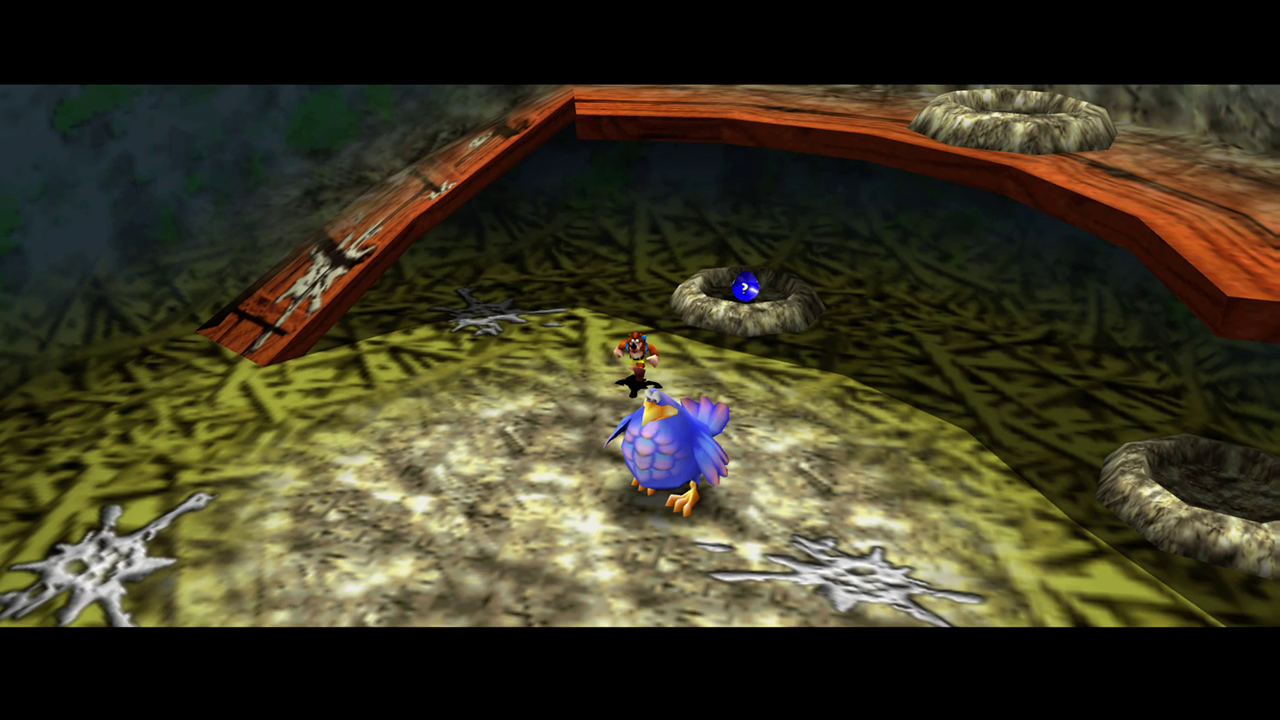
![]()
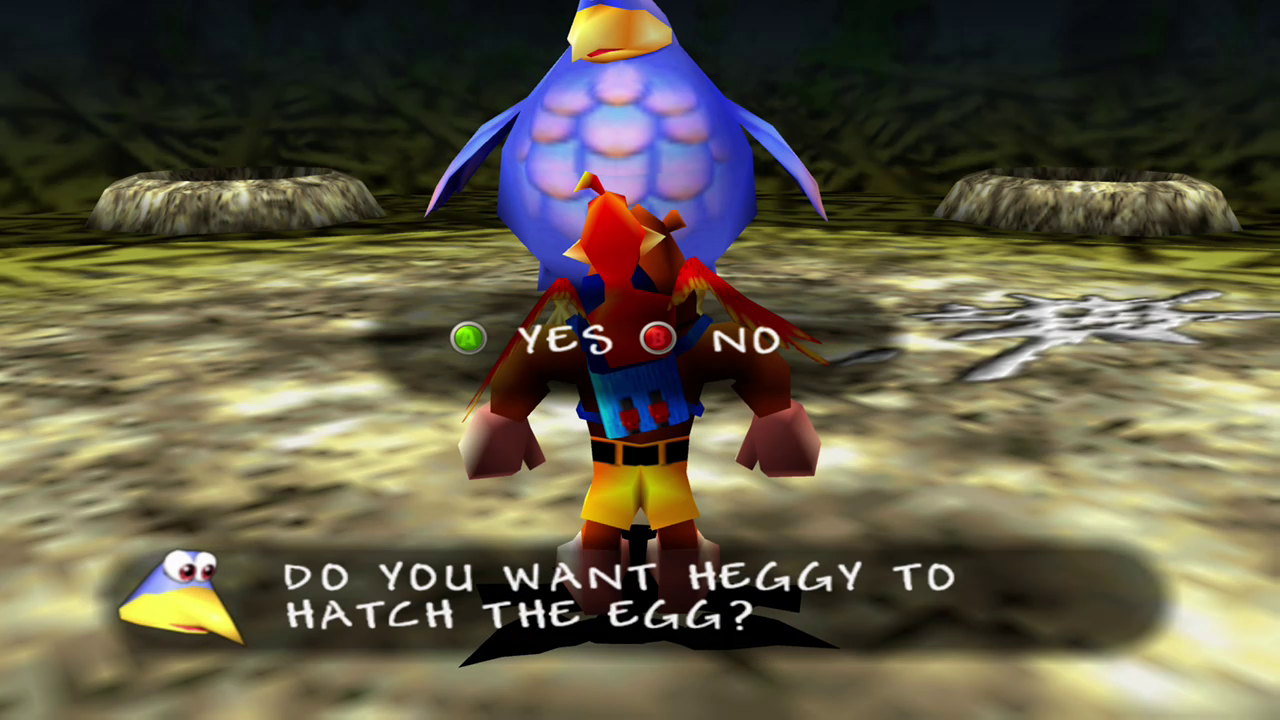
![]()
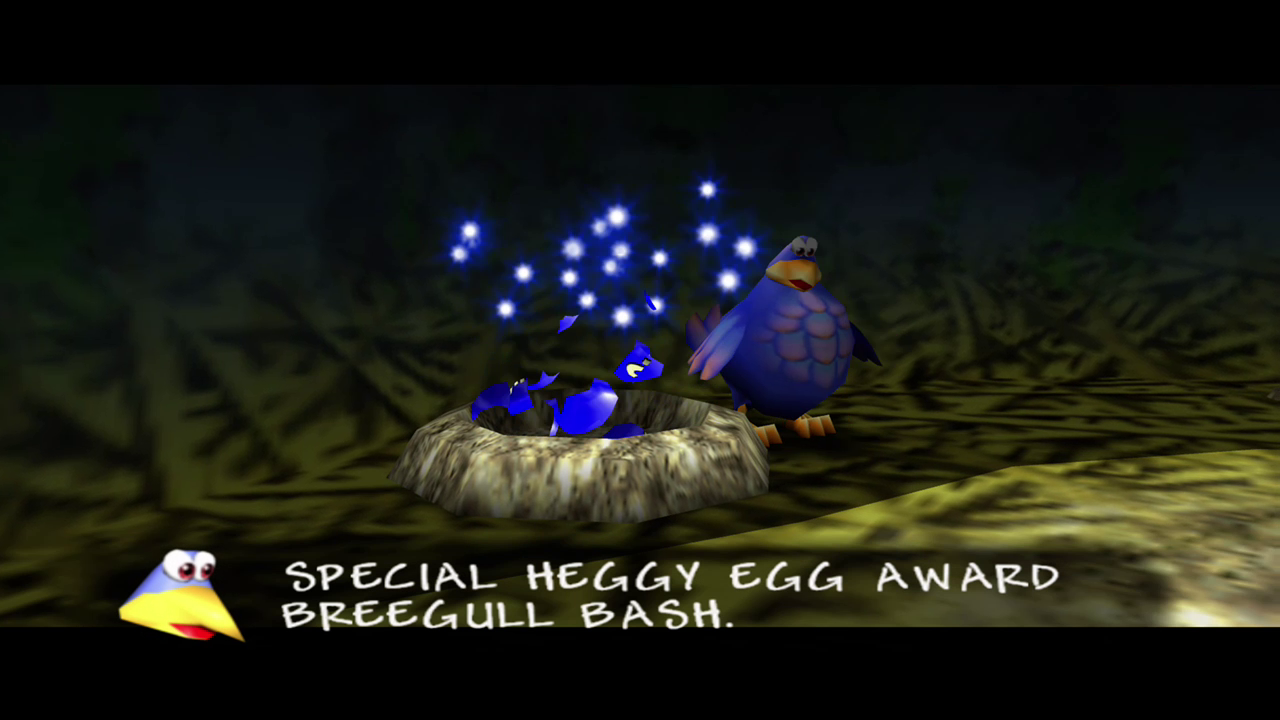
![]() [View Fullsize Image]
[View Fullsize Image]![]() [View Fullsize Image]
[View Fullsize Image]![]() [View Fullsize Image]
[View Fullsize Image]
After the final Cyan Mystery Egg had been hatched in Heggy’s Egg Shed, players would receive a pseudo-notification modeled after the Xbox 360’s ‘Achievement Unlocked’ bubble that announced the finding of “Stop ’N’ Swop II”.
While the first automatic reward, “Oh No, Not Again…” would serve as the starting point for the next conundrum, players could find that doing certain tasks in the game would start to fill up a new menu which detailed each addition found just after the original Stop ’N’ Swop screen in the View Totals option.
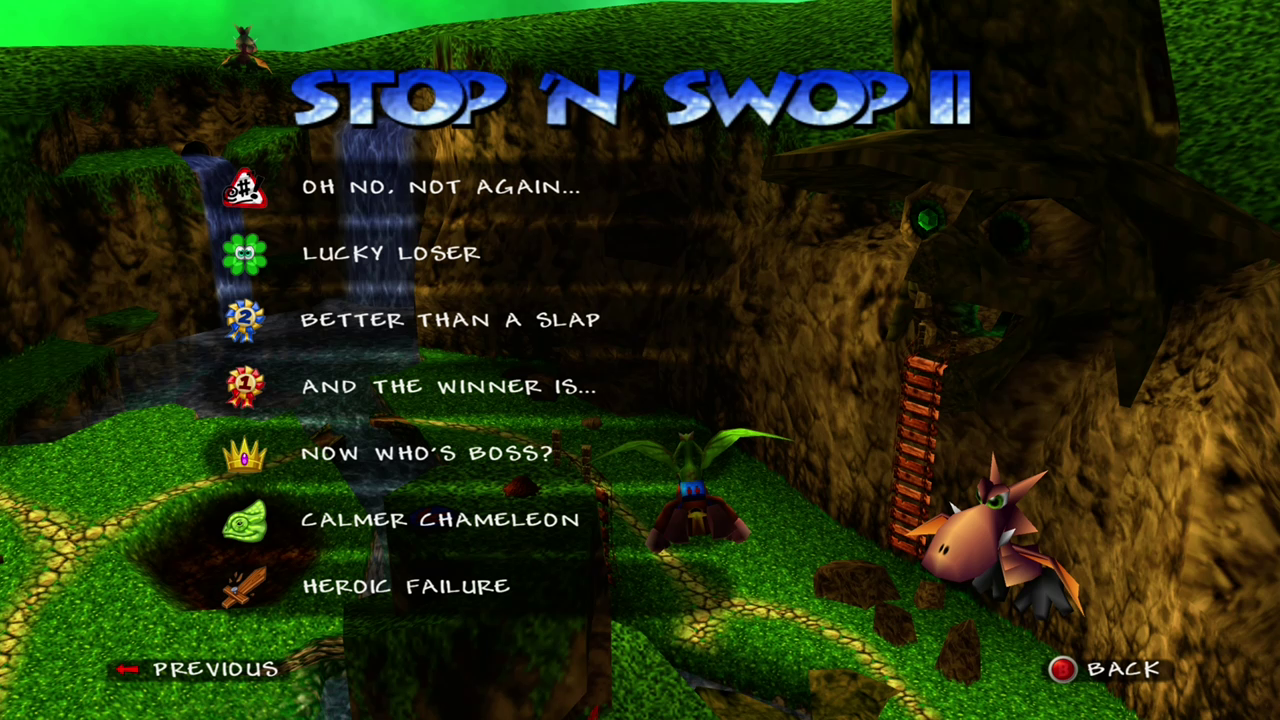
![]()
Fortunately, locating the next three Stop ’N’ Swop II prizes would be familiar for anyone who had played through the original Banjo-Tooie title, as the Game Paks were still present in the Xbox Live port with a trio of new Mystery Eggs to collect. Venturing behind the waterfall and past the wrought-iron gates in Spiral Mountain to destroy the Cartridges would reveal a Silver and Bronze Mystery Egg, and collecting both would unlock two further Stop ’N’ Swop II unlockables with “Better than a Slap” and “Lucky Loser” respectively. Seeking first place position would require players to travel into Jinjo Village and hunt down the remaining Game Pak that previously housed the Ice Key. This time, the Cartridge would relinquish the Golden Mystery Egg along with its associated Stop ’N’ Swop II reward, “And the Winner Is…”
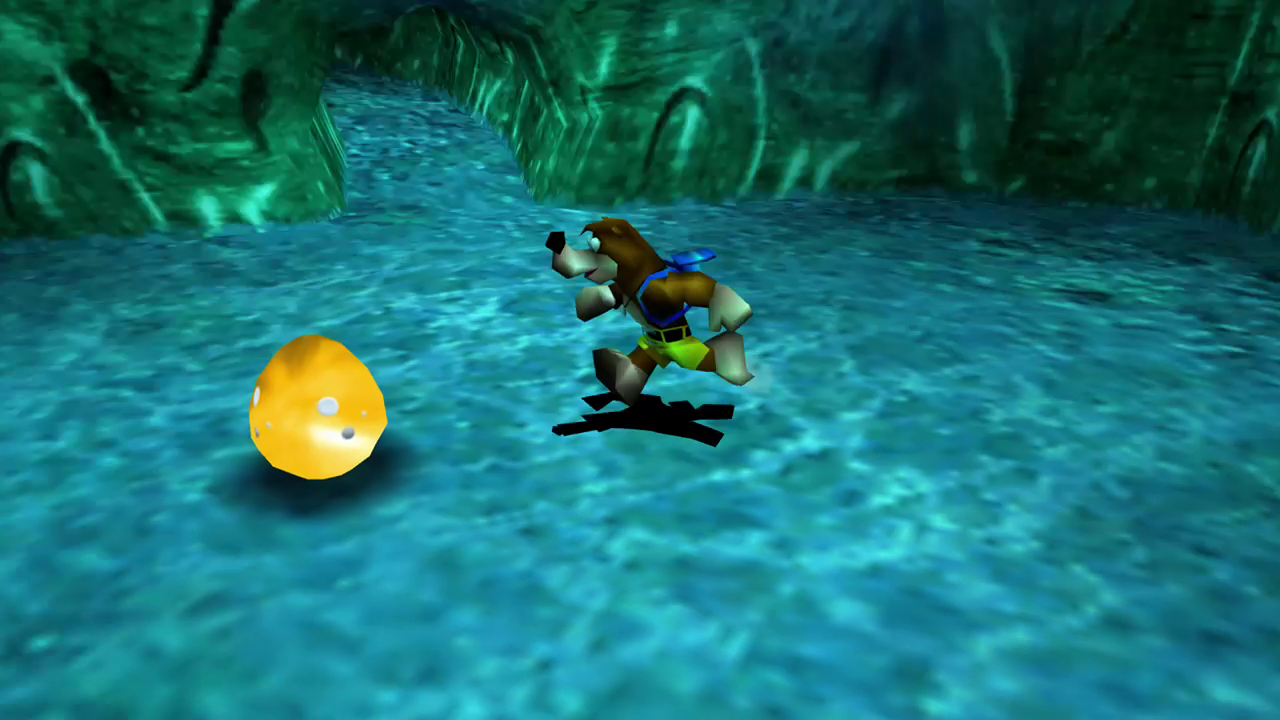
![]()
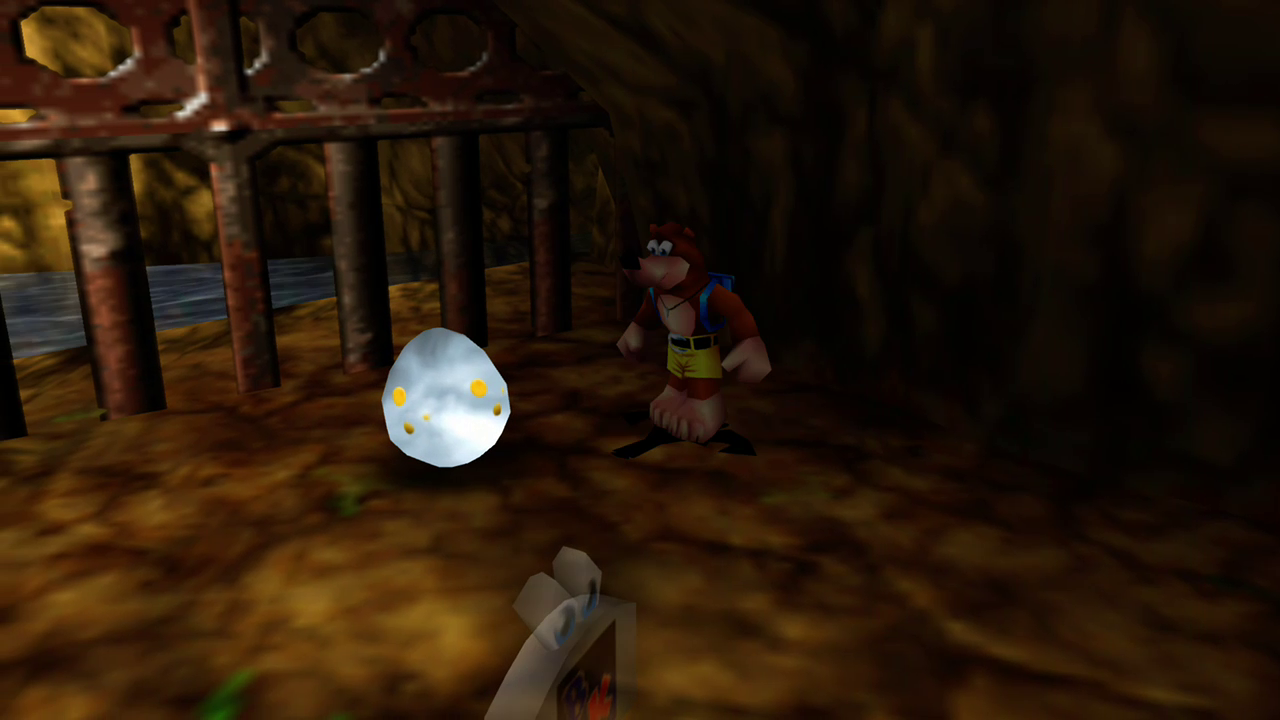
![]()
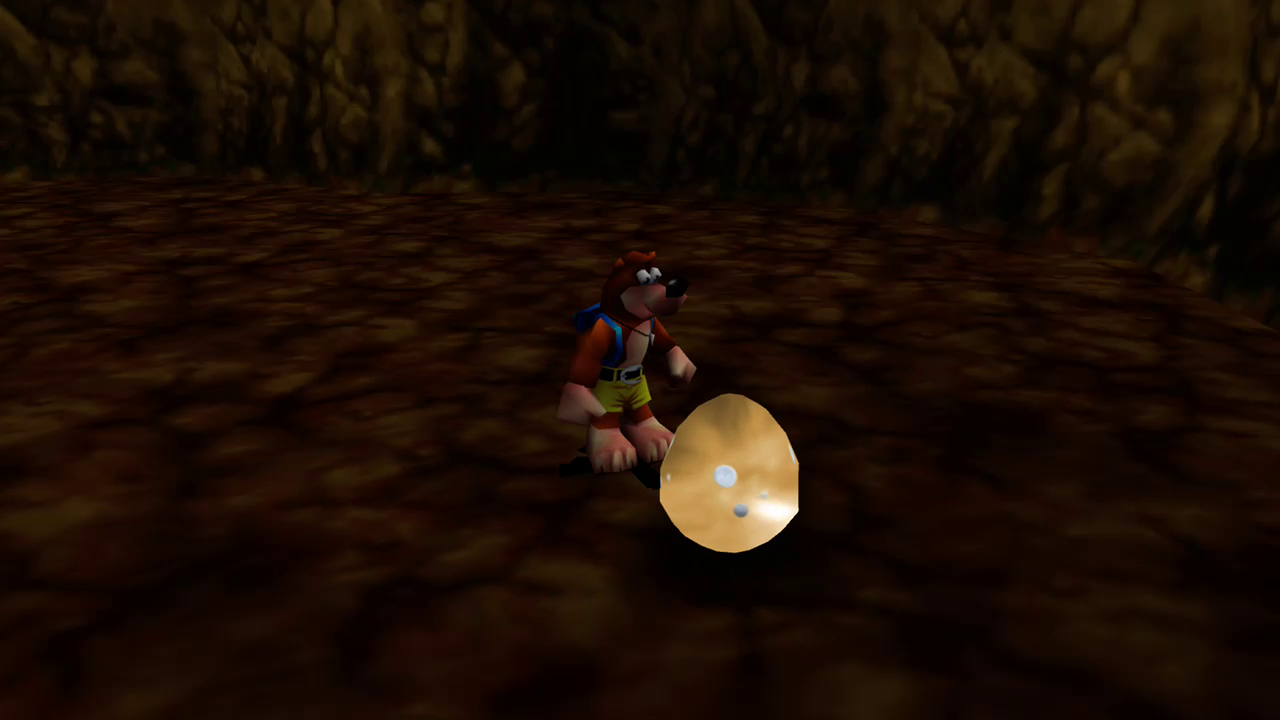
![]()
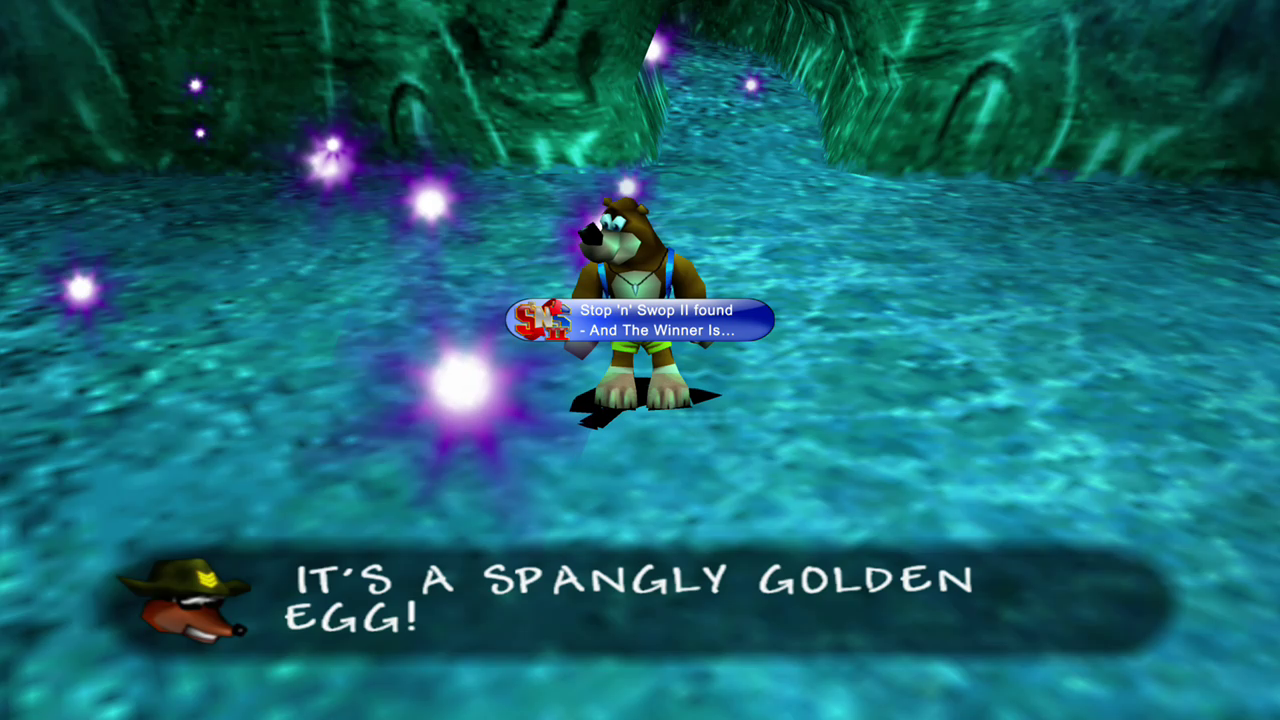
![]()
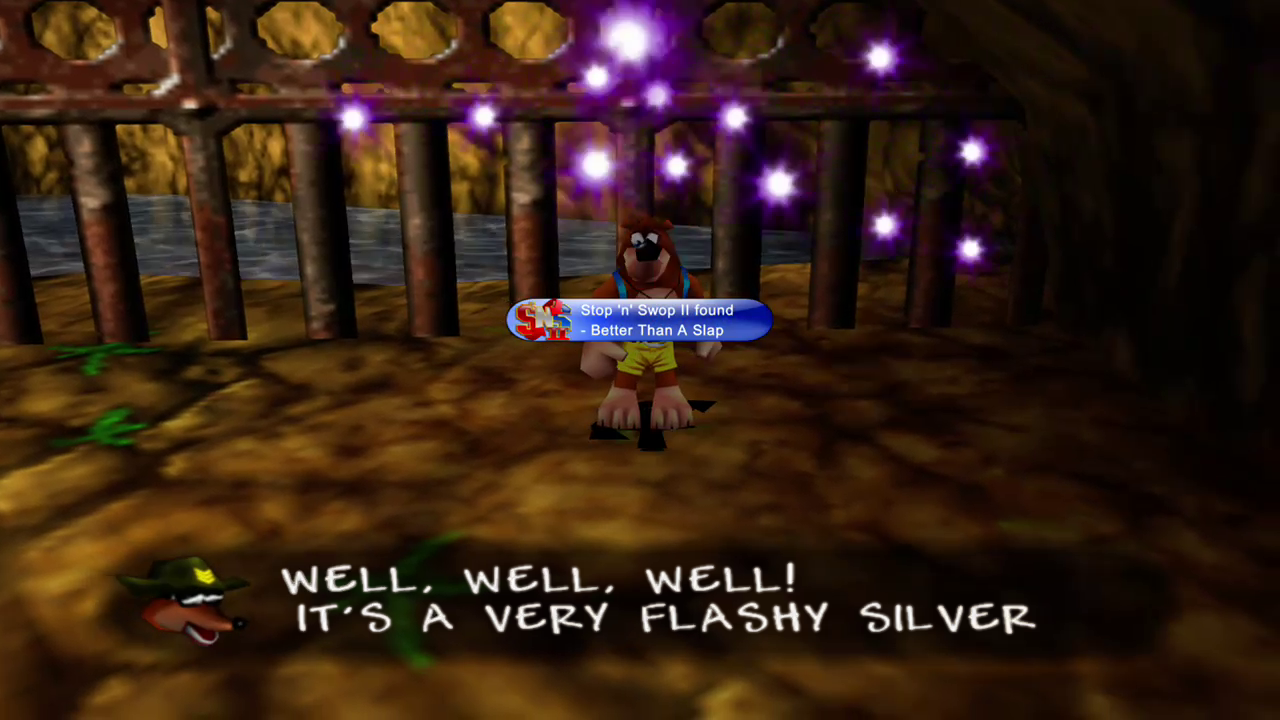
![]()
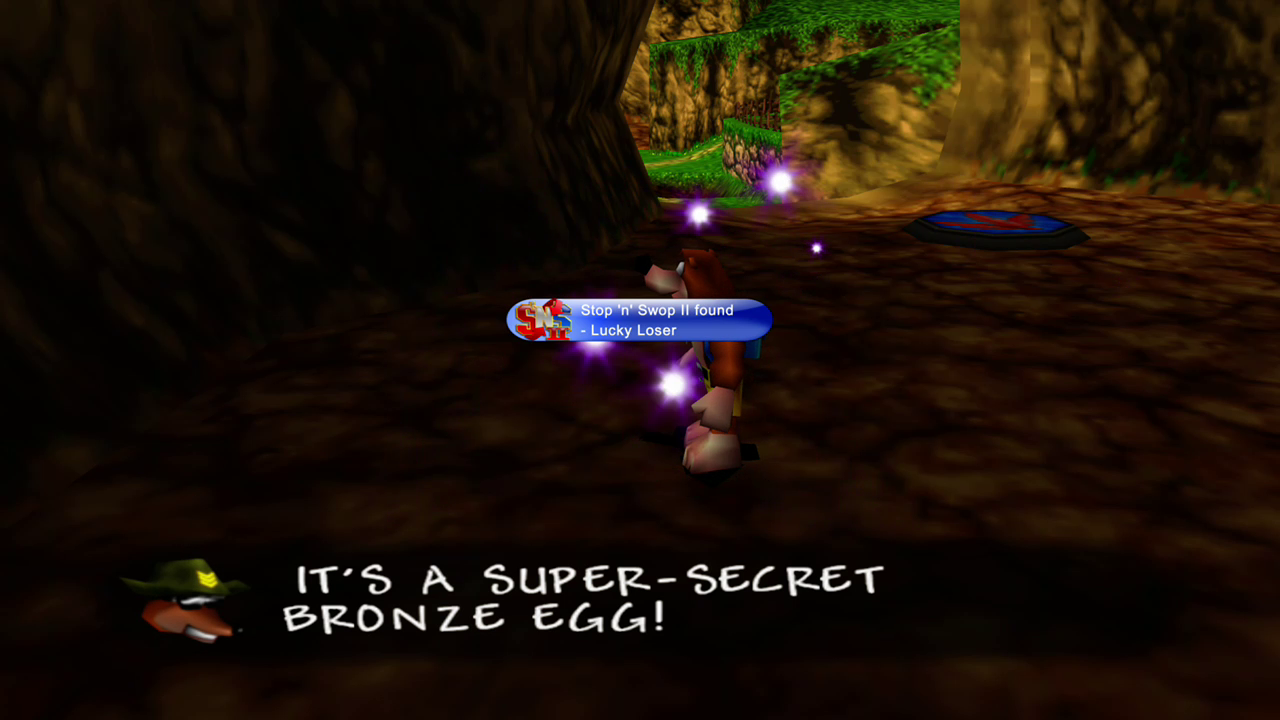
![]()
![]()
Utilizing all of Humba Wumba’s transformations during their game would allow players to unlock the “Calmer Chameleon” secret, which served as the final Stop ’N’ Swop II bonus that could be unlocked during the main campaign. The final two achievements required the most legwork, and could be accessed in the Boss Replay Menu at the games File Selection Screen. If players were especially good at beating the games bosses quickly with a collective best time of under 15 minutes, they would earn the “Now Who’s Boss” secret. Conversely, if players were especially miserable at facing off against past foes and managed to tally up 40 deaths overall they would snag the “Heroic Failure” reward along with a deserved sense of hot shame.
After managing to satisfy all of the requirements of Stop ’N’ Swop II, players would have completed the menu, yet found themselves with an extra feature that (so far) can’t be utilized by any other Rare title in any current capacity. As with the original premise of Stop ’N’ Swop, we can expect that its successor will need to depend on an as-of-yet unknown Rare game to transfer the Medal Mystery Eggs and 4 other Stop ’N’ Swop II unlockables. Until then, we’ll have to remain patient and hope that an answer will be provided after Banjo-Tooie XBLA‘s decade-long wait.
EASTER EGGS AND ALLUSIONS TO STOP ’N’ SWOP
PROPOSED SOLUTION IN GRABBED BY THE GHOULIES
If anything, the curiosity and speculation surrounding Stop ’N’ Swop has certainly been entertaining for the fans, and each new discovery and revelation has been punctuated with cause for celebration. Naturally, Rare has quite a sense of humor surrounding their mystery feature and have showcased it in several of their games as inside jokes for their players to find. While a chronological listing of every Stop ’N’ Swop easter egg discovered can be found below, the first game deserves special recognition for including a supposed solution that sent the online community in a frenzy.
Released in 2003 as their first title under Microsoft, haunted house romp Grabbed by the Ghoulies was largely comprised of the same team that had previously worked on Banjo-Kazooie and Banjo-Tooie. This would become fairly obvious when exploring Ghoulhaven Hall, as there were nearly 100 unique references that paid tribute to the Bear and Bird with cameo appearances from the principal and secondary cast in portraits, products and clothing found throughout.
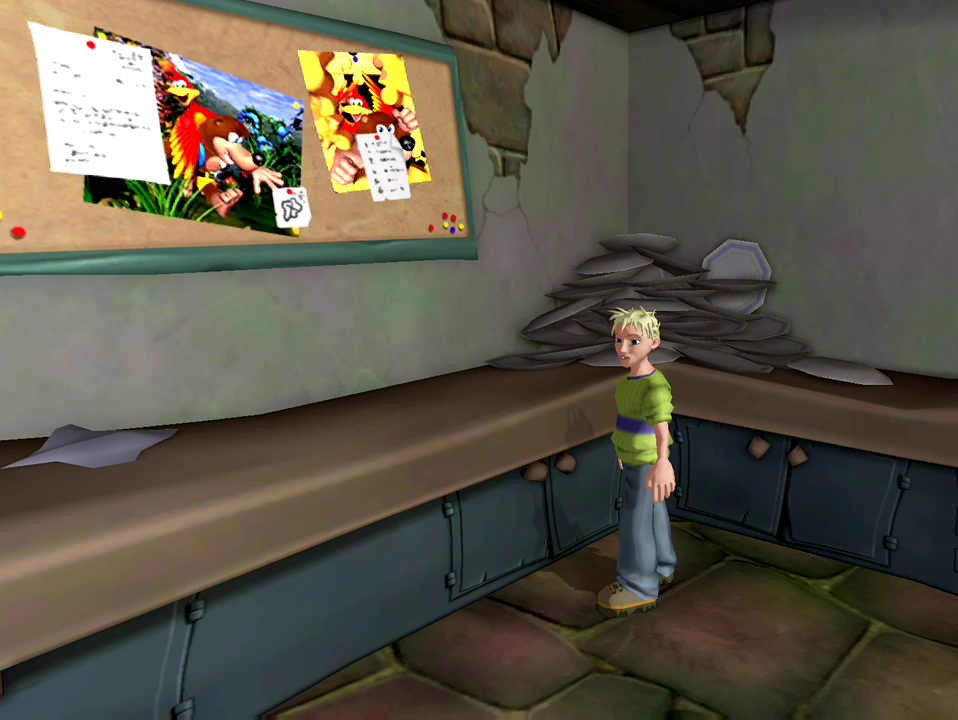
![]()
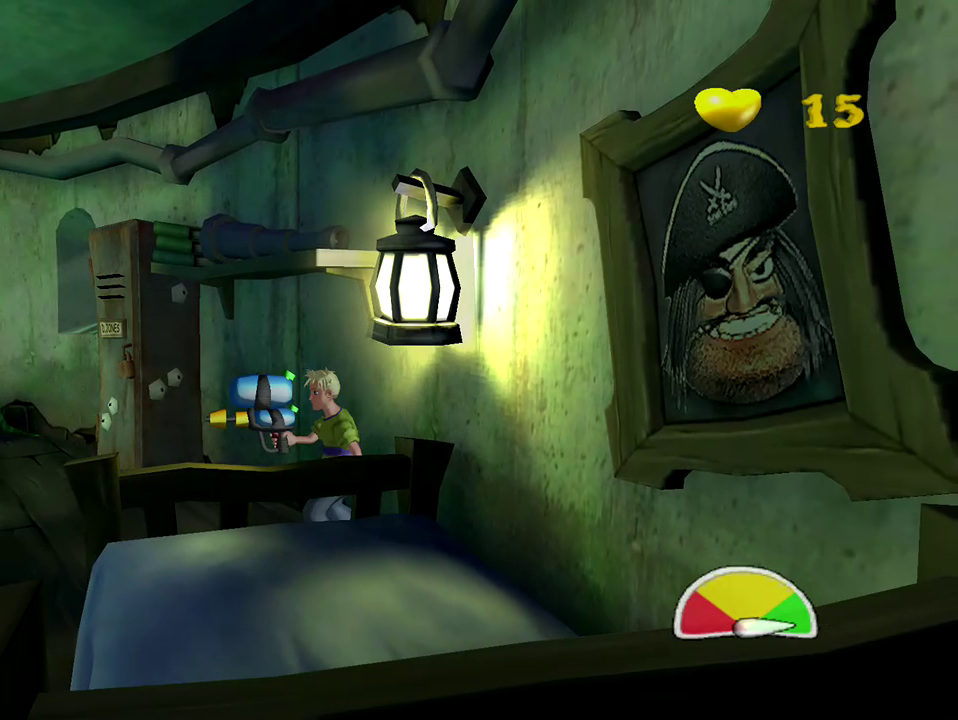
![]()
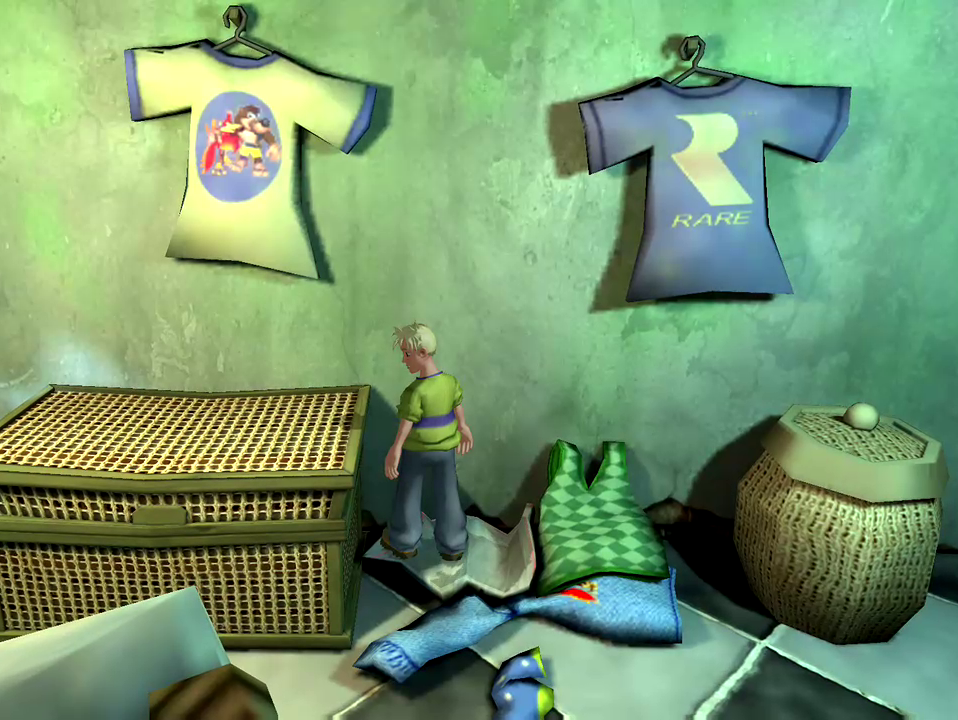
![]() [View Fullsize Image]
[View Fullsize Image]![]() [View Fullsize Image]
[View Fullsize Image]![]() [View Fullsize Image]
[View Fullsize Image]
The most memorable easter egg, and the only one relating to Stop ’N’ Swop could be found in Chapter 3, Scene 8 when exploring the Classroom. Players could find a Stop ’N’ Swop “homework” assignment written on one of the whiteboards that broke down a proposed solution in three steps:
-
1. Collect Ice Key
2. Collect Eggs
3. Activate Secret Level
A number of diagrams had been drawn next to the assignment that added further intrigue, including four Mystery Eggs coupled with a three-pronged Ice Key and three potential maps seen from overhead that had X’s marked on each of them.
At this point in time, Stop ’N’ Swop was still seen as a very tangible feature by the fans – most thought that like the Sandcastle Codes, players were only missing a few vital steps that would allow new secret areas to be accessible in either Banjo-Kazooie or Banjo-Tooie. Now, there seemed to be an answer hidden in Grabbed by the Ghoulies, an olive branch from Rare with the promise of being able to unlock an entire level if they could just follow the instructions provided.
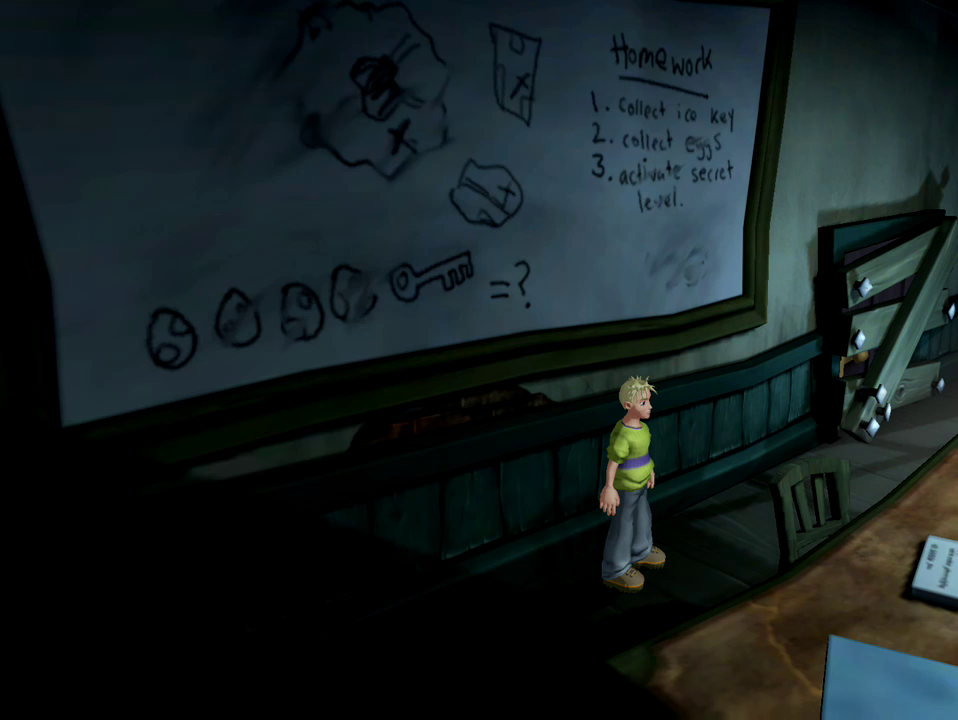
![]()
The most influential portion of this supposed solution as the observant had caught, was the inclusion of only four of the six Mystery Eggs, leaving many to suspect that two of the Eggs were traps meant as a fail-safe to throw off players that had collected them illegitimately. Suddenly the online community had recessed into a witch hunt to figure out which of the four eggs were genuine, and which two were keeping them from activating the secret level.
Complicating matters was the fact that only three of the six Eggs had their own secret locations, leaving many to speculate that the Blue, Pink and Cyan Eggs were ‘real’, and the others that had managed to appear in familiar locations were ‘fake’.
On the other hand, many thought that the Cyan Egg was itself a clever bait and switch as the wine barrel containing it had been marked with an X to indicate that it was ‘crossed off’, and not meant to be collected. It was very easy to get caught up in the conspiracy, and every potential selection seemed to have its own list of valid reasons for being, only to have it dismissed by the next theorist to come along.
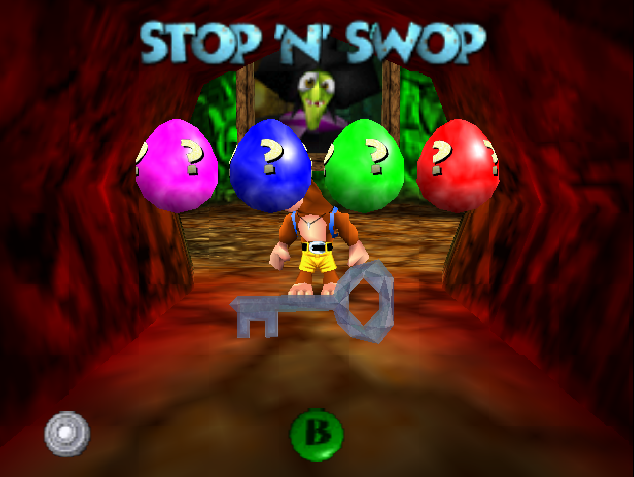
![]()
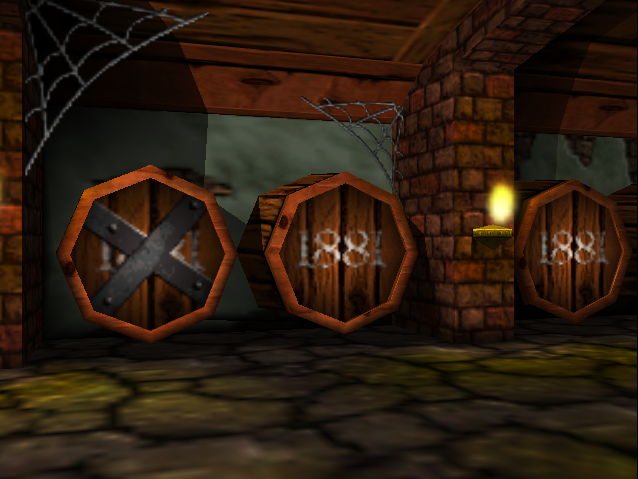
![]()
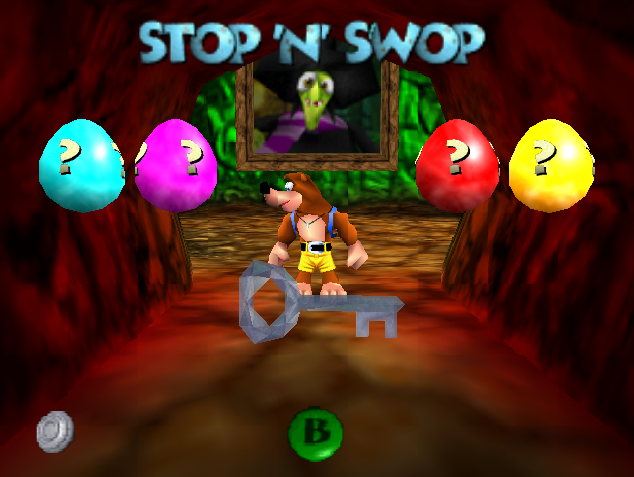
![]() [View Fullsize Image]
[View Fullsize Image]![]() [View Fullsize Image]
[View Fullsize Image]![]() [View Fullsize Image]
[View Fullsize Image]
Consensus on the maps was met with similar divisiveness, as each overhead view was just vague enough to be applied to several of the games areas. For some, the largest circular map could be the inside of Sharkfood Island or Spiral Mountain from Banjo-Kazooie, for others, it read as Cauldron Keep or Cloud CuckooLand in Banjo-Tooie. In hindsight it’s easier to swallow the truth and realize that the entire premise was just too good to be true, and we now know that neither Banjo-Kazooie or Banjo-Tooie could hide an entire level in its code, managing to avoid detection every time it was taken under the microscope. Far more likely is that the whiteboard was just a joke that the community took far too seriously, and that using Stop ’N’ Swop to wind the fans of the feature up would become something of a recurring staple in Rare’s future titles…
STOP ’N’ SWOP EASTER EGGS IN OTHER GAMES
Rare’s portable team would take off with the Banjo-Kazooie series next with racing game Banjo-Pilot in 2005. Throughout the title, players would receive a number of Cheato Pages depending on their finishing position which they could then return to Gruntilda’s Spellbook in exchange for bonus rewards. If players could amass 999 Cheato Pages and beat the Rare Time Trials in every race, they would have the option to purchase the final reward offered in Banjo-Pilot called “Stop N Swap”. Fulfilling these requirements was no easy feat, as it would require players to first accomplish other lofty tasks, such as unlocking Bottles as the fastest pilot to stand a chance against the Rare times. Those who preserved could return to Cheato and exchange their hard-earned pages for his wisdom on “Stop N Swap”, which resulted in this anti-climatic rebuke:
-
“So you want to know about Stop N Swap, eh? I hope you’re ready. Here goes…”
- “Why don’t you stop annoying me and swap this game for a nice book or something?”
After it was sold, the “Swap N Swap” option could be triggered by players to have Cheato repeat the short speech if they wanted to relive the everlasting disappointment of the stinging barb at any time.
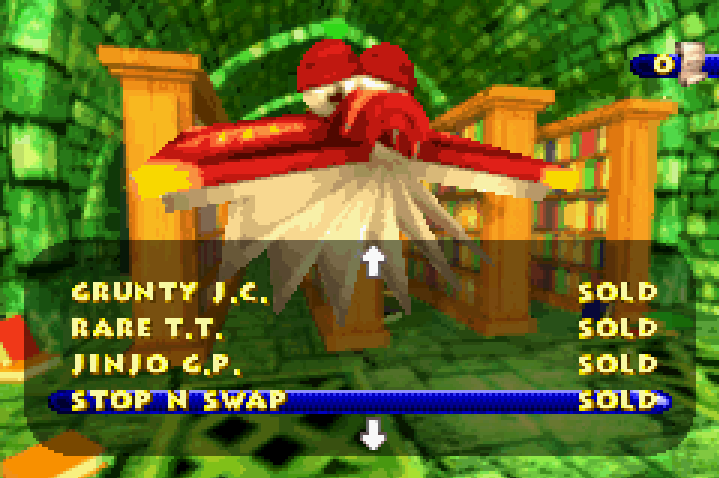
![]()
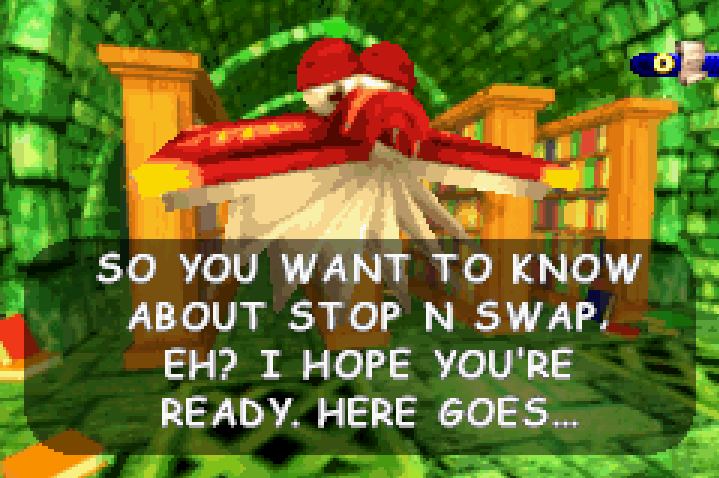
![]()
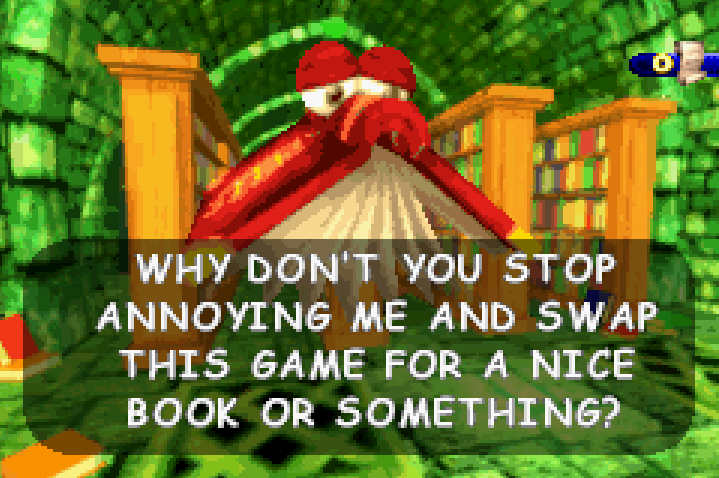
![]() [View Fullsize Image]
[View Fullsize Image]![]() [View Fullsize Image]
[View Fullsize Image]![]() [View Fullsize Image]
[View Fullsize Image]
On February 22nd, 2007, a hacking enthusiast named Adam Vierra claimed to have found a never-before-seen Mystery Egg when examining the code of Banjo-Tooie. Posting under the alias ‘Coolboyman’, Adam provided video documentation of a hidden Purple Egg intended to be found in the train station of Glitter Gulch Mine. Further investigation would lead to three additional Mystery Eggs being located, with an Orange Egg discovered in Grunty Industries on February 28th; a Brown Egg in Cloud CuckooLand on March 3rd; and a Silver variant uncovered in Mayahem Temple on March 30th.
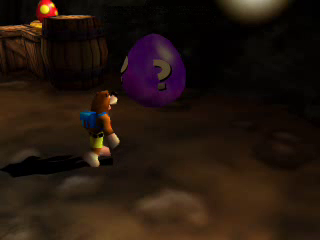
![]()
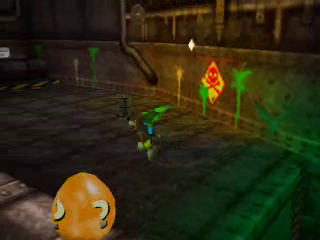
![]()
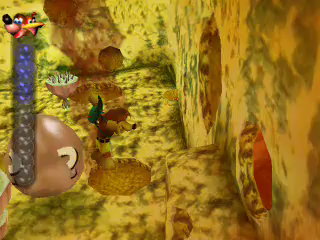
![]()
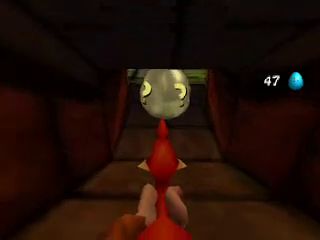
![]()
Amidst speculation and scruity of these findings, Rare seemed to provide credibility in a trailer promoting then-upcoming Jetpac Refuelled for the Xbox Live Arcade. Throughout the trailer, the players name appearing at the top of the screen was altered to “Coolmanboy”, “MeepoNoMore”, “Orange Egg”, “Purple Egg”, “DungeonDoor” and “FindTheSecret”.
Not only did this affirm that Rare was aware of Coolboyman’s discoveries, but it seemed to allude to another mystery found in Kameo: Elements of Power, where a locked door found in the Dungeon of Eternal Life would rattle interminably throughout the adventure. While it was unknown whether the Dungeon Door, or Kameo’s scrapped dragon sidekick, Meepo, were connected to Stop ‘N’ Swop in some way, what was clear was that Rare had acknowledged the new Mystery Eggs in Banjo-Tooie and were now spurring fans to ‘FindTheSecret’.
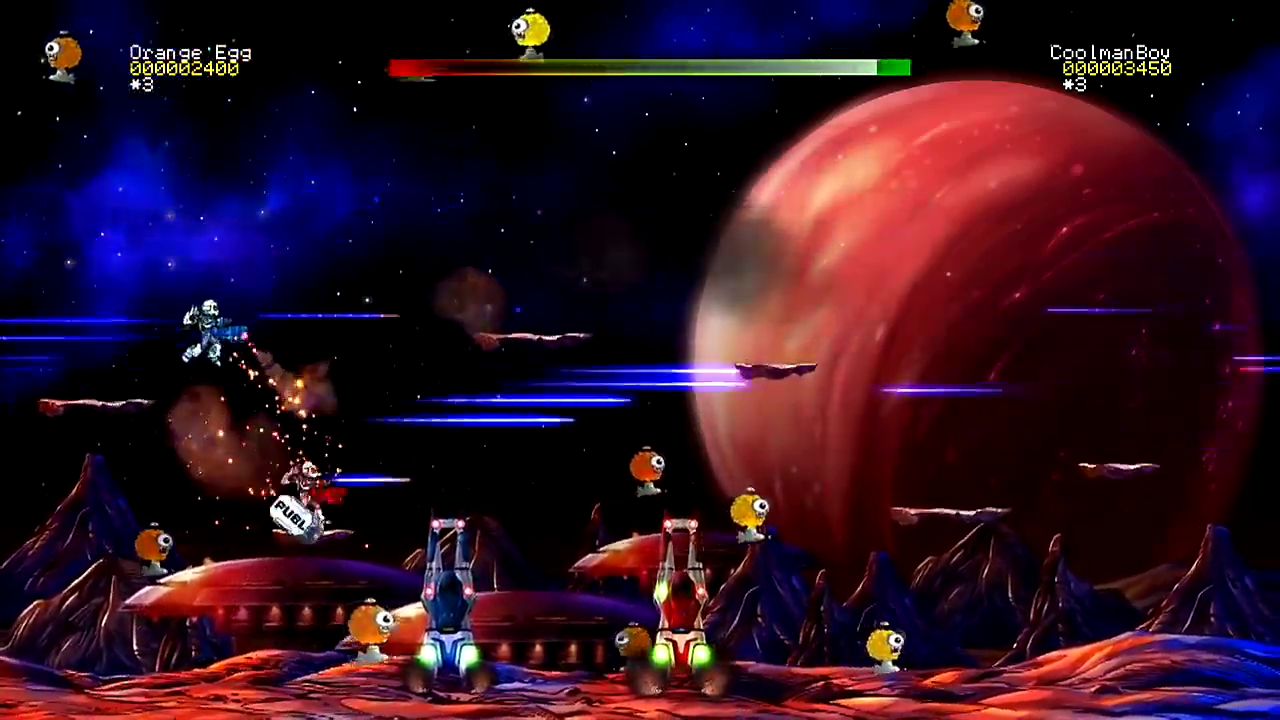
![]()
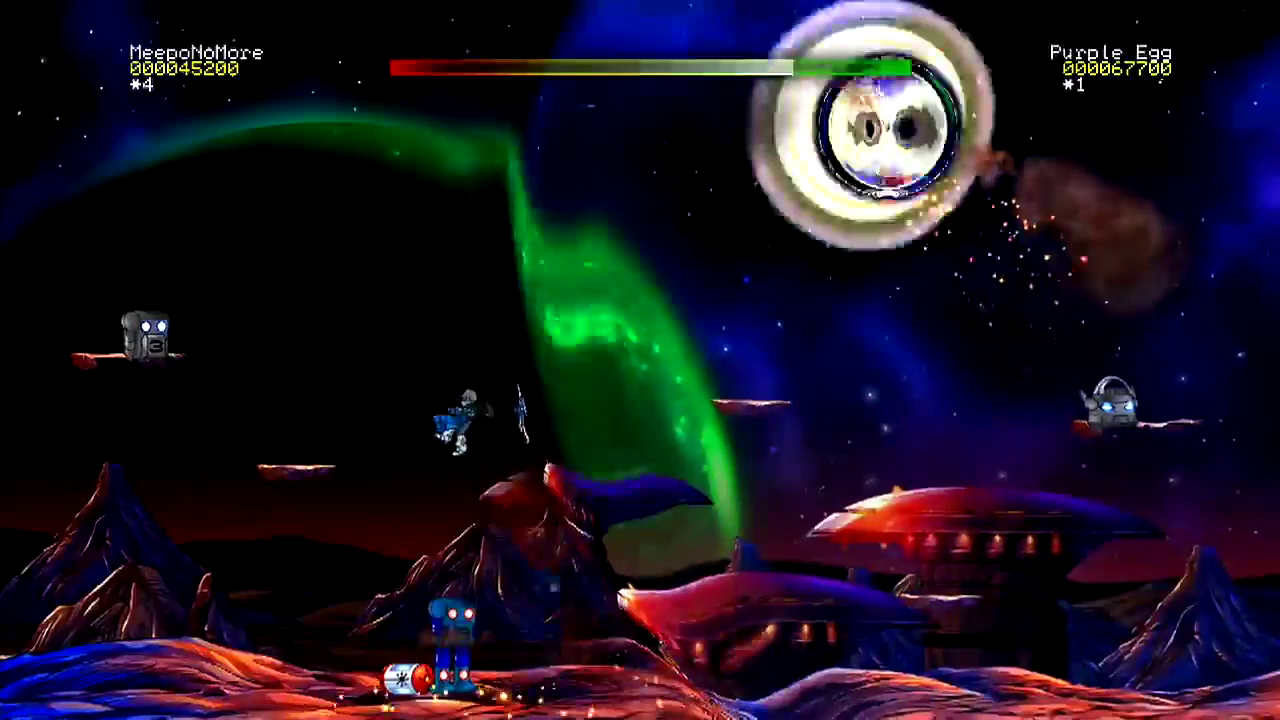
![]()
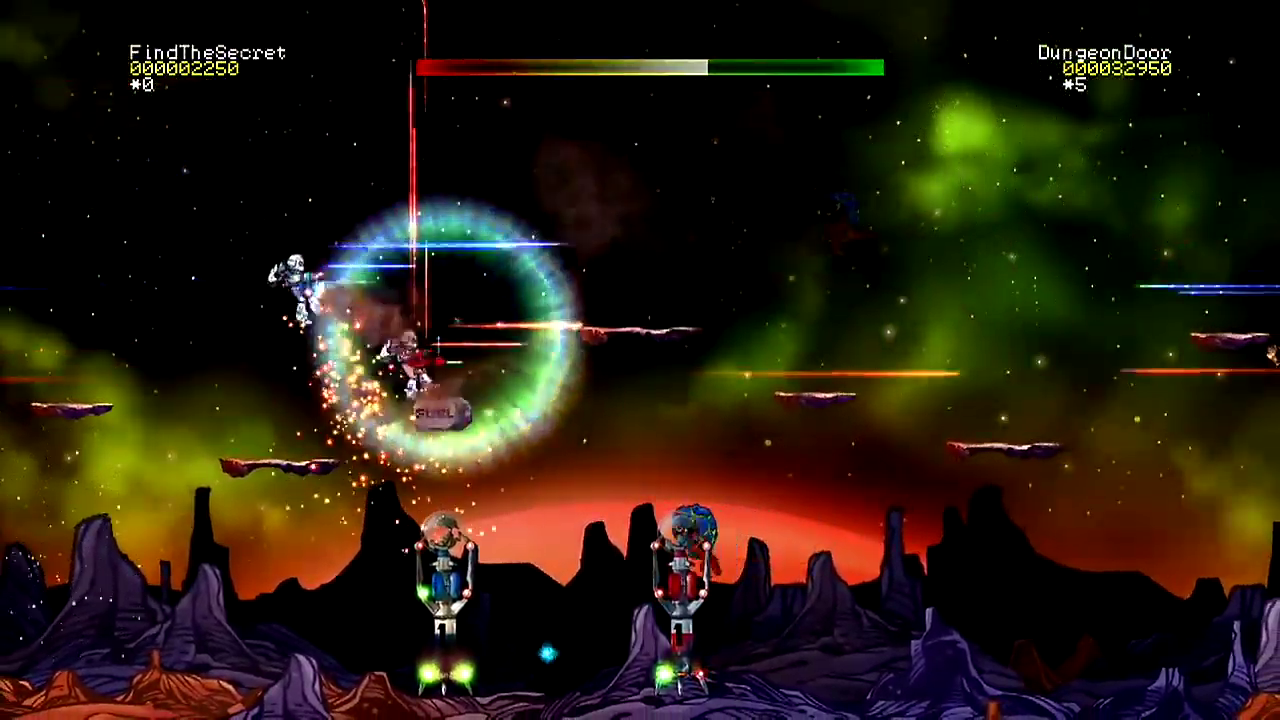
![]()
![]() [View Fullsize Image]
[View Fullsize Image]![]() [View Fullsize Image]
[View Fullsize Image]![]() [View Fullsize Image]
[View Fullsize Image]
Unfortunately, the final Silver Mystery Egg found on March 30th would signal the end of the hunt, as Coolboyman would reveal the very next day that his findings culminated in one large-scale April Fools joke that had started nearly two months prior, with five months of planning. All four of the newly discovered Mystery Eggs had been created by Vierra, who had managed to place them into the familiar locations through the use of crafty coding. Perpetuating the hoax, Rare had cheekily referenced the ongoing search in their Jetpac Refuelled trailer in order to wind up the community, leading even the more skeptical Stop ‘N’ Swop fanatics into letting their guards down and buying into the practical joke.
The pastoral plots of Viva Piñata: Trouble in Paradise would host the next reference to Stop ’N’ Swop in 2008, though it was objectively less cruel than the option featured in Banjo-Pilot. With two new biomes to be found in the Piñarctic and the Dessert Desert regions, Trouble in Paradise would reflect their opposing climates with a soundtrack for each. Those that had ventured into one of the areas that housed a Stop ’N’ Swop item in Banjo-Kazooie would be instantly familiar when hearing the Piñata song “Icicle Chorus“, as the opening notes were shared directly with the fanfare. While the score featured in Banjo-Kazooie has four variations dependent on which Stop ’N’ Swop Mystery Egg was to be collected (A beachy Bandoneón for the Pink and Red Eggs, an egyptian-sounding Flute and Theremin combo for the Blue Egg, low Pizzicato strings and a Theremin punctuated with haunting laughter for the Green and Cyan Eggs and high Pizzicato strings and marimba for the Yellow Egg) the Ice Key had its own instrument set with high Pizzicato strings and a Glockenspiel, and is the comparison most faithfully made when listening to the orchestrated rendition in Viva Piñata: Trouble in Paradise:
Naturally, the largest number of Stop ’N’ Swop references can be found in Banjo-Kazooie: Nuts & Bolts where Rare would have had an opportunity to take advantage of a decades worth of speculation and in-jokes to culminate in the third title.
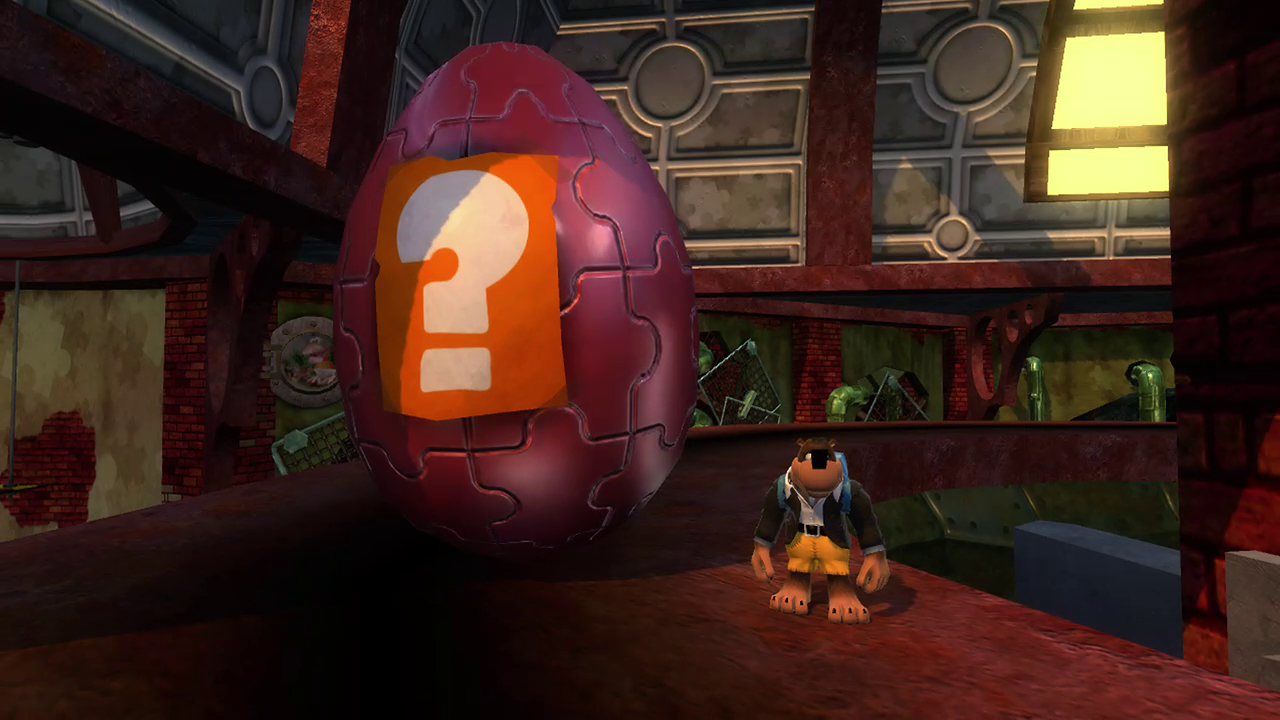
![]() Venturing into the time capsule turned museum, BanjoLand, players could discover a collection of red Mystery Eggs throughout the interior – each had been comprised of Jiggies fashioned into an oval shape, with a single question mark page taped on its front. Attempting to destroy the makeshift Mystery Egg would reveal another surprise, as the item housed a single GruntBot that could easily dispatched with a few swings of Mumbo’s wrench. In the exhibit dedicated to Freezeezy Peak, players could locate three mystery items hidden behind a thin transparent sheet of ice, much in the same vein as the initial sighting in Wozza’s Cave. Peering through the glass would reveal an enormous Ice Key, GruntBot Red Mystery Egg and Compact Disc with “Stop N Swop” written in marker on its front. The objects would remain frozen and unobtainable just beyond Freezeezy Peak’s vantage point for the remainder of the adventure.
Venturing into the time capsule turned museum, BanjoLand, players could discover a collection of red Mystery Eggs throughout the interior – each had been comprised of Jiggies fashioned into an oval shape, with a single question mark page taped on its front. Attempting to destroy the makeshift Mystery Egg would reveal another surprise, as the item housed a single GruntBot that could easily dispatched with a few swings of Mumbo’s wrench. In the exhibit dedicated to Freezeezy Peak, players could locate three mystery items hidden behind a thin transparent sheet of ice, much in the same vein as the initial sighting in Wozza’s Cave. Peering through the glass would reveal an enormous Ice Key, GruntBot Red Mystery Egg and Compact Disc with “Stop N Swop” written in marker on its front. The objects would remain frozen and unobtainable just beyond Freezeezy Peak’s vantage point for the remainder of the adventure.
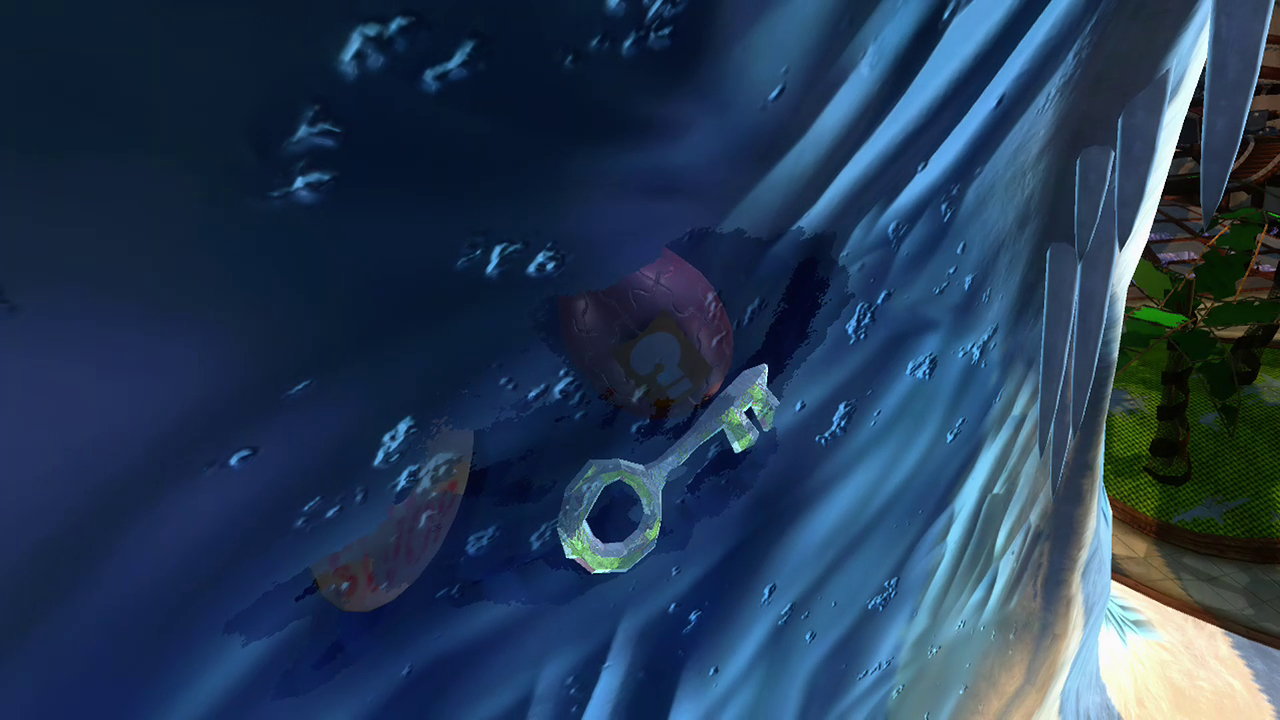
![]()
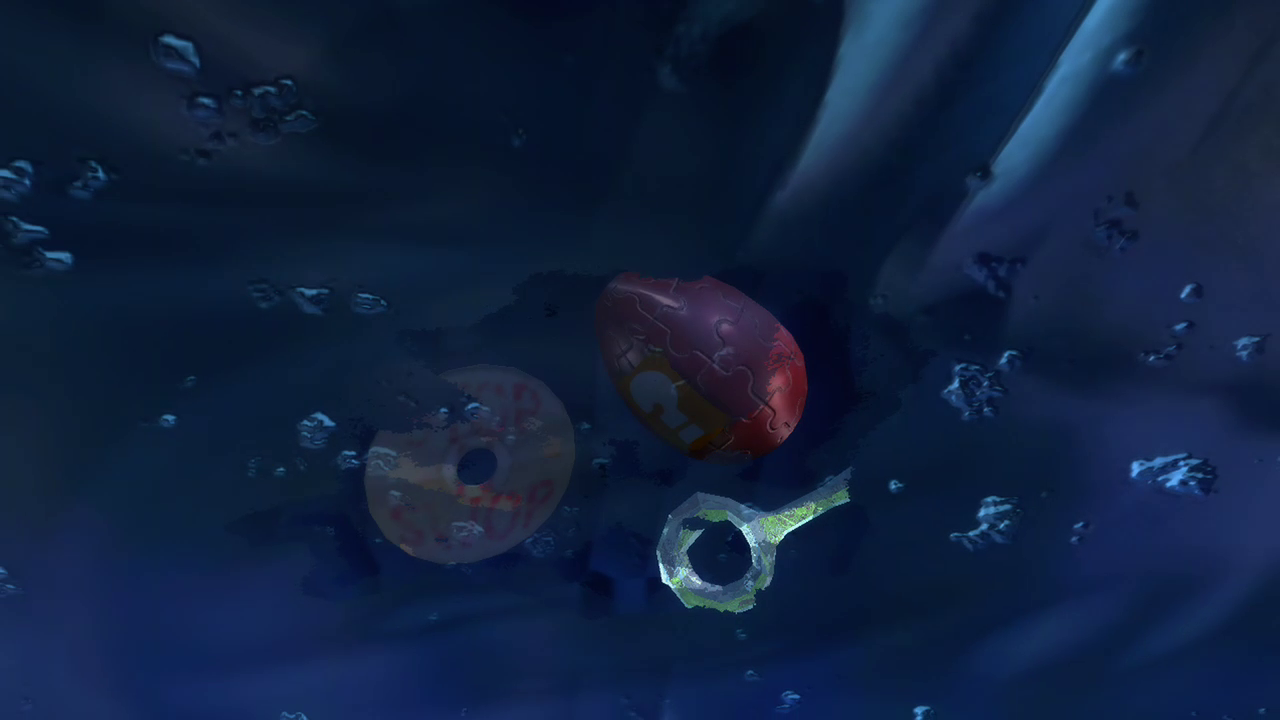
![]()
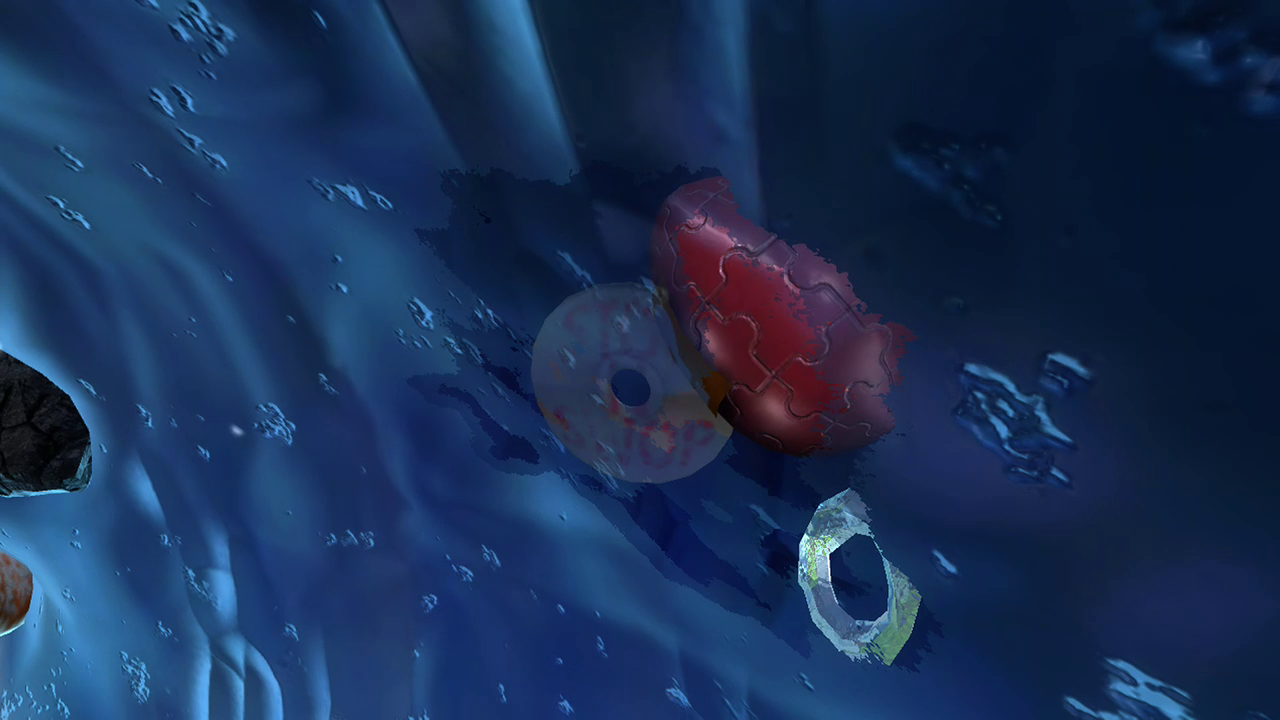
![]() [View Fullsize Image]
[View Fullsize Image]![]() [View Fullsize Image]
[View Fullsize Image]![]() [View Fullsize Image]
[View Fullsize Image]
The feature would also receive mention by name from principle characters throughout the third adventure.
Bottles would prove to be the source of significant ire if approached in Showdown Town. Now operating a Tourist Information booth, the short-sighted Mole would provide insight to the games mechanics in exchange for Musical Notes. While most of Bottles’ knowledge comes at a fair price, one final option in the Pay menu called “Stop ’N’ Swop Truth” receives the highest cost at 6,000 Notes. Unfortunately, even the most frugal player will come up short, as there’s only 5,230 Notes total to be found in the game, with a further none-too-helpful 100 Notes in L.O.G.’s Lost Challenges. This of course didn’t deter some enterprising players with altering the games code to artificially boost their Notes scores, to which it was revealed that Bottles was taking a page out of Cheato’s book:
- “I could tell you, but then I’d have to kill you, and we couldn’t show that in a game with this rating. Put it out of your mind and think happy thoughts! Thanks for the Notes!”
If players ventured into Act 4 of Nutty Acres, they could approach the egocentric Trophy Thomas to race on his behalf in a challenge against Gruntilda’s cat, Piddles. Besting the “Cheatin’ Witch” challenge with the highest possible Trophy ranking would result in Thomas reacting in shock, suggesting that Banjo used a code to win:
- “I’m almost speechless at how well you did. You must be using a cheat code! That’s it! Did you stop the game and swop something?”
The Lord of Games would have a chance at some good-natured ribbing during the Quiz portions of the penultimate “Six of the Best” challenge in Spiral Mountain. If players are very lucky, one of the random question asked by L.O.G. will be:
- “What was the name of the supposed secret link between Banjo-Kazooie and Banjo-Tooie that some fansites still won’t shut up about?”
While “Jolt ‘N’ Bolt”, “Pull ‘N’ Push” and “Stick ‘N’ Stuck” are tempting answers, the only one that the Lord of Games will accept as correct is of course, “Stop ’N’ Swop”. The observation still checks out as well, as it’s been more than a decade since the release of Banjo-Kazooie: Nuts & Bolts and we still refuse to shut up about it.
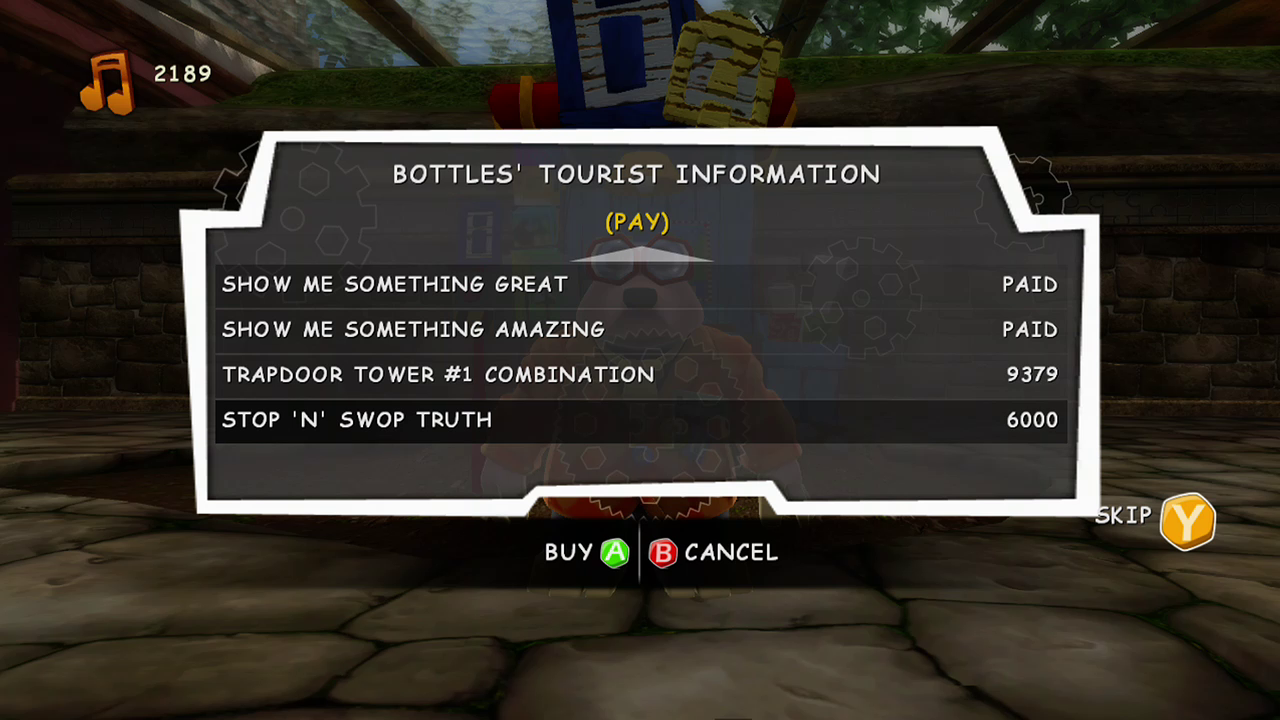
![]()
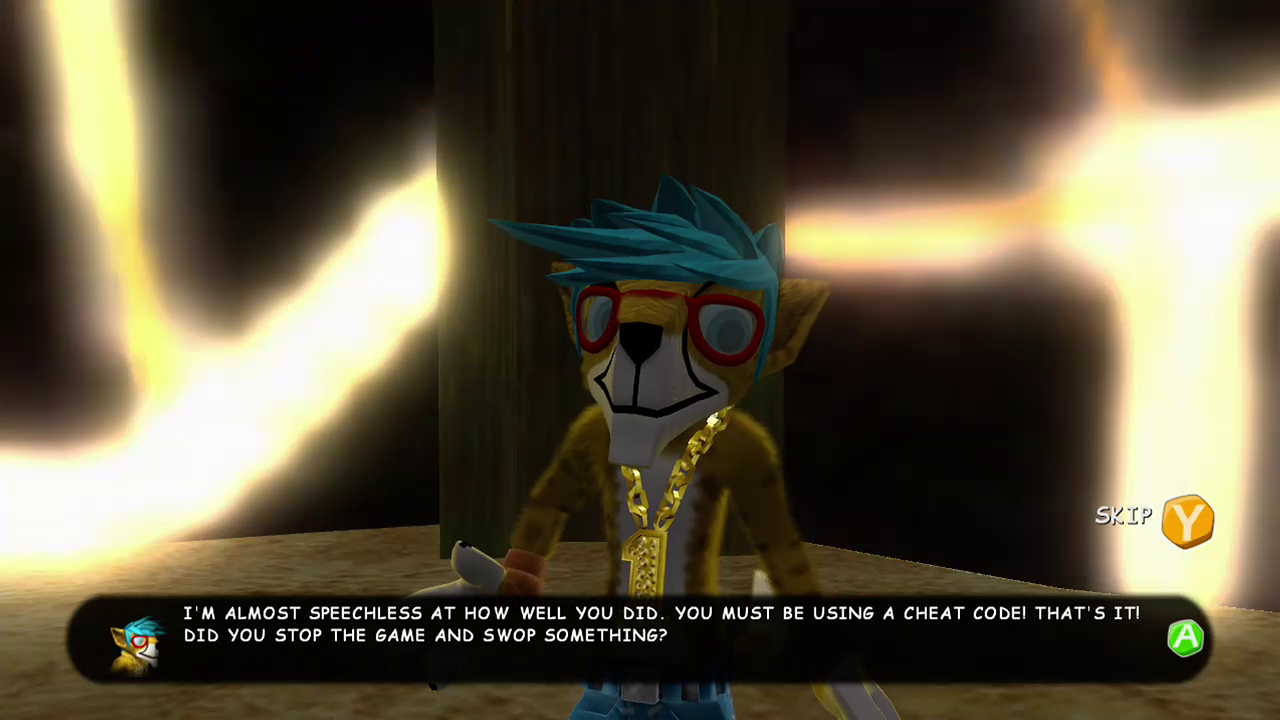
![]()
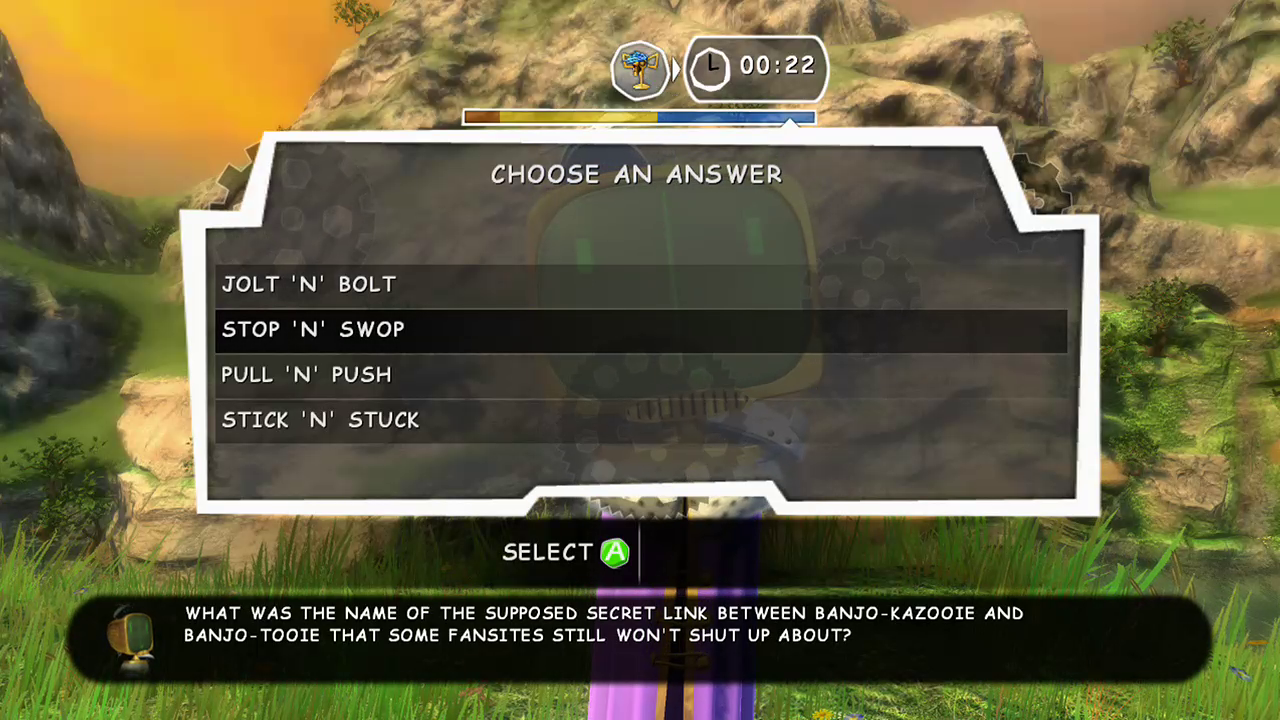
![]() [View Fullsize Image]
[View Fullsize Image]![]() [View Fullsize Image]
[View Fullsize Image]![]() [View Fullsize Image]
[View Fullsize Image]
One final reference from the Lord of Games could be found in his world-inside-a-console level, LogBox 720, where a portion of the music features L.O.G. singing a short solo directed at Banjo and Kazooie, teasing Stop ’N’ Swop in its final verse:
- Welcome to my world.
Stupid Bear and Bird.
Lots to do and see.
Stop ’N’ Swop on 360.
Interestingly, players would get a chance to “Stop ’N’ Swop on 360” with the transferring of data from Banjo-Kazooie XBLA which was made possible due to the titles availability on Xbox 360.
The Terrarium of Terror would also play host to its own quest to retrieve the Ice Key, though Banjo would be tasked with doing so for a Yellow Jinjo in a ‘fetch’ scenario. It was clear from the first interaction that the Jinjo was meant to act as a surrogate for fans that had followed Stop ’N’ Swop like it was a conspiracy, with the tiny creature proclaiming, “I’ve lost my Key! Now the ongoing mystery will never been solved!” Once the challenge was accepted, the Jinjo would offer its bargain with another thinly veiled reference, “If you stop what you’re doing and find my Ice Key, I’ll swop it for a Jinjo Token!”
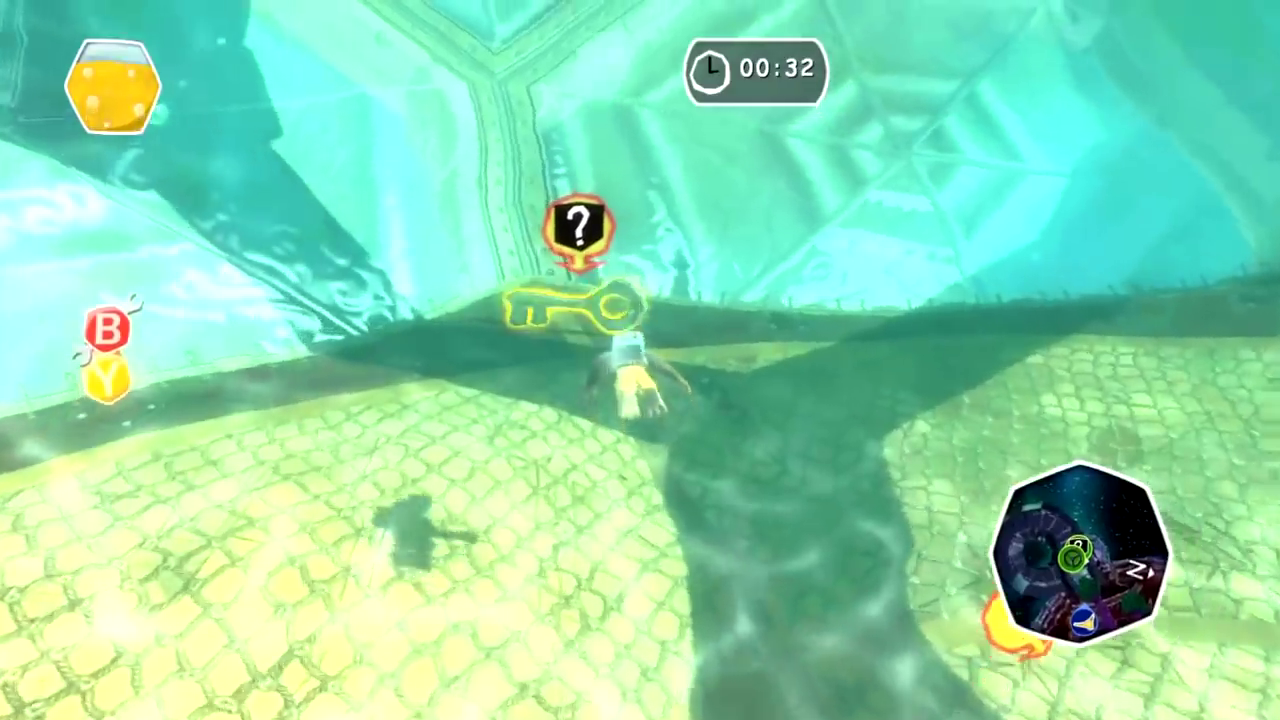
![]() Fortunately, collecting the Ice Key this time around would be remarkably easier than presented in earlier Banjo titles, as it could be found on the bottom of an adjacent pool near the Jinjos location. Diving into the waters with an amphibious vehicle and swimming through to an underwater annex would reveal the Ice Key, which could then be grabbed up with Mumbo’s wrench. Once the iconic Key had been retrieved from the underwater chamber floor and returned to the Yellow Jinjo found above, it would make its final allusion to Stop ’N’ Swop conspiracy theorists with a self-aware wisecrack, “Aha! Now I can resume my obsession with the pointless and frustrating mystery of the Key!”
Fortunately, collecting the Ice Key this time around would be remarkably easier than presented in earlier Banjo titles, as it could be found on the bottom of an adjacent pool near the Jinjos location. Diving into the waters with an amphibious vehicle and swimming through to an underwater annex would reveal the Ice Key, which could then be grabbed up with Mumbo’s wrench. Once the iconic Key had been retrieved from the underwater chamber floor and returned to the Yellow Jinjo found above, it would make its final allusion to Stop ’N’ Swop conspiracy theorists with a self-aware wisecrack, “Aha! Now I can resume my obsession with the pointless and frustrating mystery of the Key!”
We’ve never been simultaneously insulted yet so accurately summarized before now, thanks for that, Yellow Jinjo.
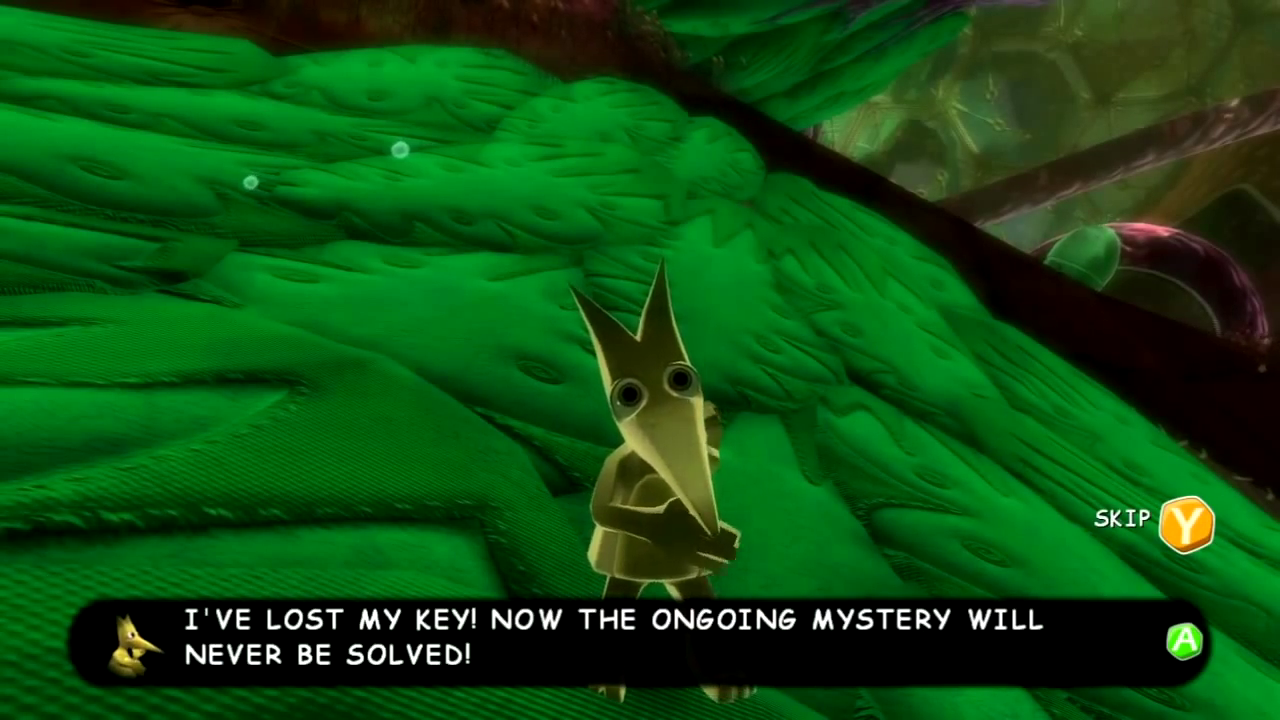
![]()
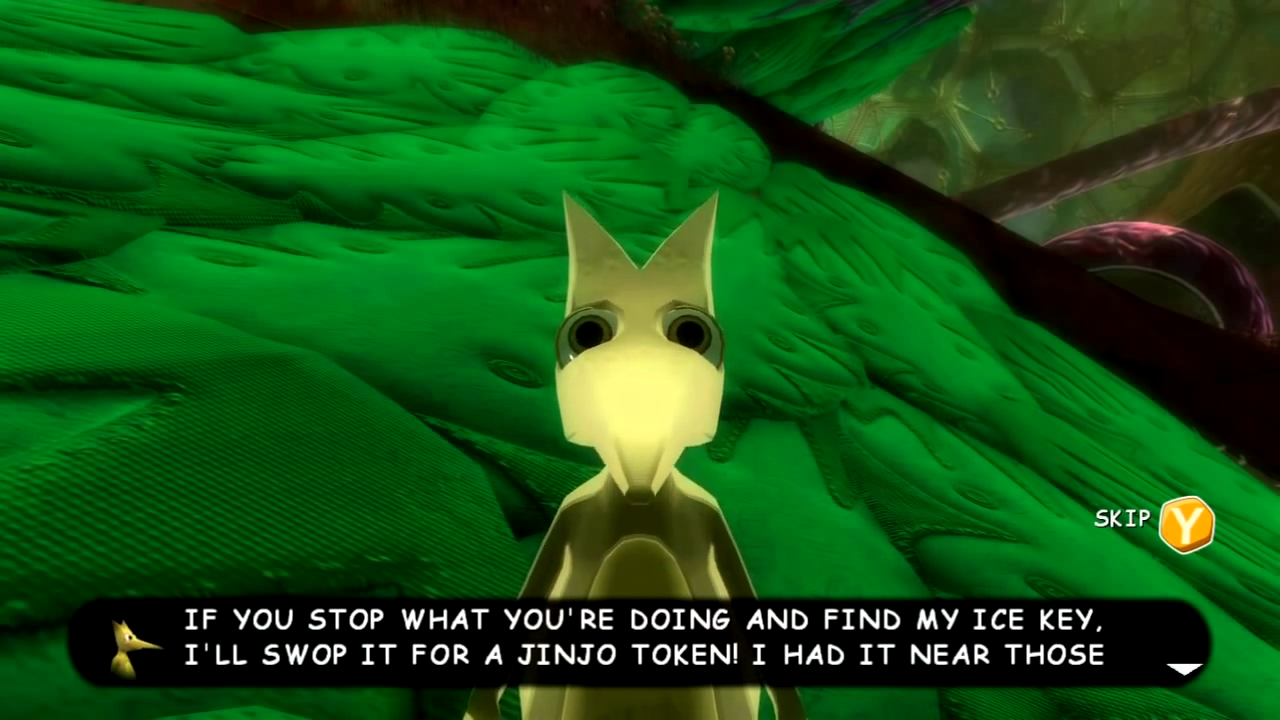
![]()
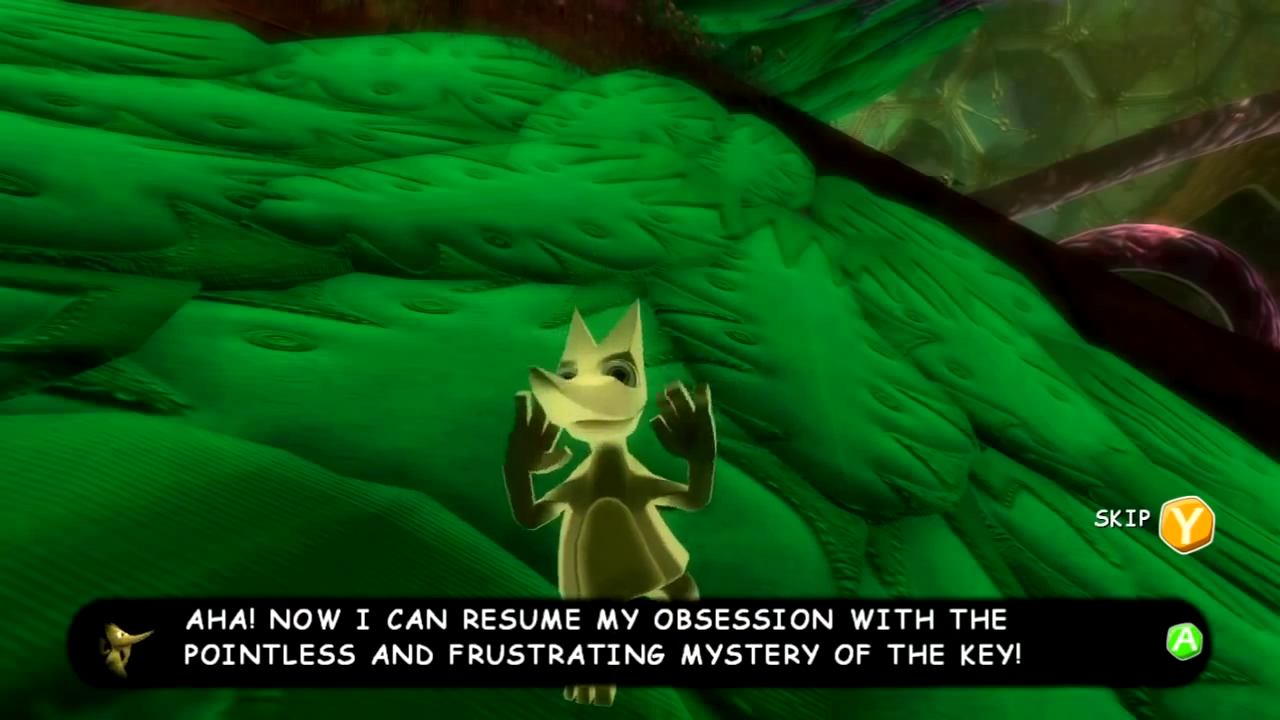
![]() [View Fullsize Image]
[View Fullsize Image]![]() [View Fullsize Image]
[View Fullsize Image]![]() [View Fullsize Image]
[View Fullsize Image]
As the notoriety of Stop ’N’ Swop is far-spanning, it would receive its first reference from a studio outside of Rare with independent developer, Gory Detail in 2014. Braving the machinations and machinery in their delightfully sinister platforming puzzler, The Unlikely Legend of Rusty Pup would result in a glimpse of the fabled Ice Key, which could be found at the entrance of “IV-IV” in the Fire World. Panning to the left of the cautious pups’ starting position will reveal a path that gives way to a large smelting cauldron bubbling with molten magma – gripped overhead in a claw-like vice is the Ice Key, slowly dripping as it melts.
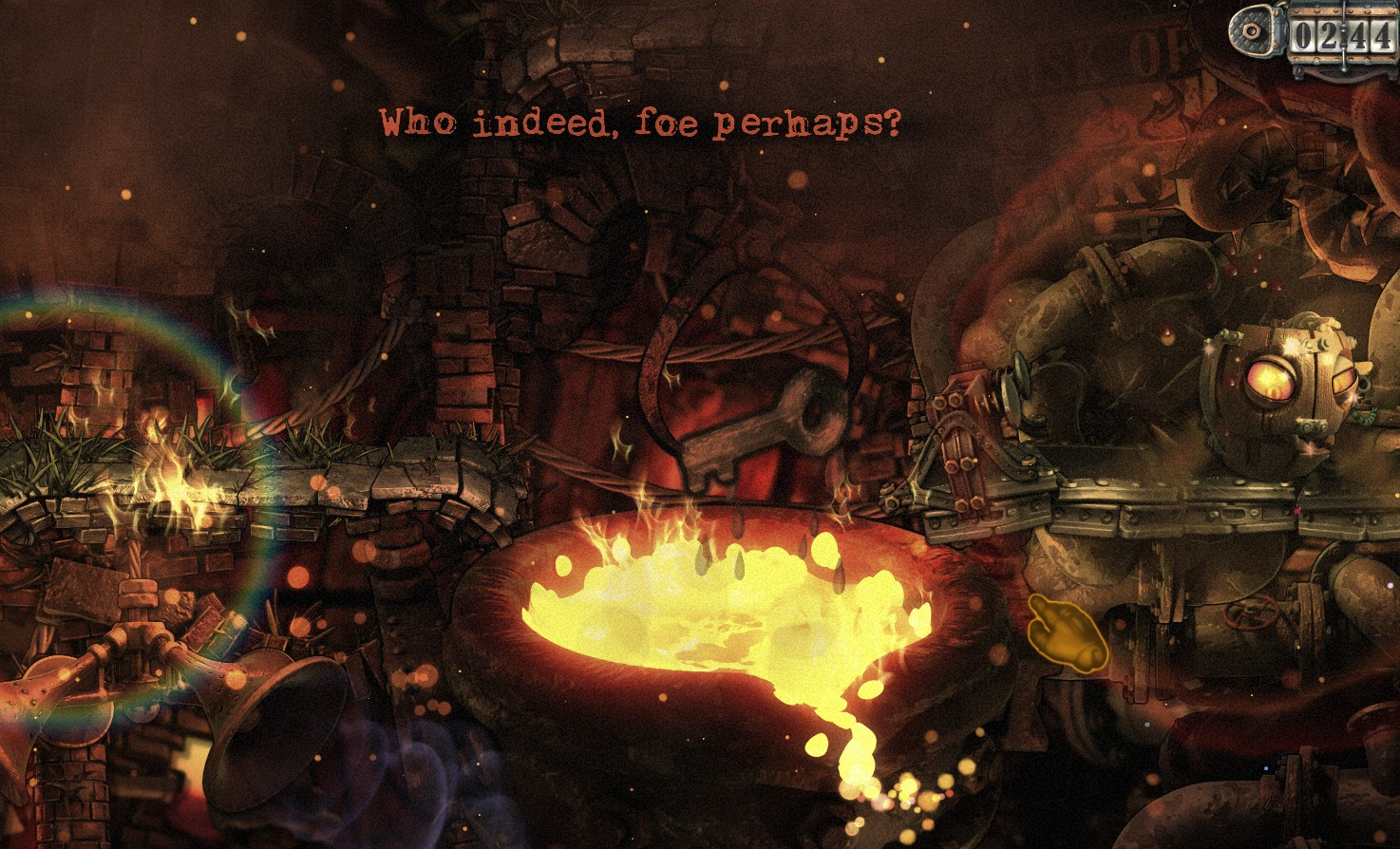
A Stop ’N’ Swop Easter Egg was also featured in Yooka-Laylee, initially released by Playtonic Games in 2016. As a number of Playtonic employees had previously worked on the Banjo-Kazooie series, it would be fitting that the spiritual successor would feature a nod to the secret feature. Players could find two hidden Ice Keys in the snow-swept world of Glitterglaze Glacier when using their collected Pagies to increase its size. Returning to the level after it had been expanded would prompt a short cutscene showing a pair of Ice Keys spinning into existence and unlocking two previously locked areas. In response, the snide Laylee would remark, “Is that it? We spent our Pagies on… a key?!”
After witnessing a second Ice Key being used to unlock an underwater door, her calmer partner Yooka would take an optimistic approach, “Ooh, a second Ice-Key! Well two is better than one…” In recognition of the speculated sizable rewards players hoped that Stop ’N’ Swop could unlock, Laylee would finish the exchange with, “What a rip-off! I was expecting an extra continent.” In this context it could be viewed as a literal wish for more land, but it’s more likely a play on words where continent is meant to be read as content. In this case, Stop ’N’ Swop would have provided extra content if it were implemented successfully.
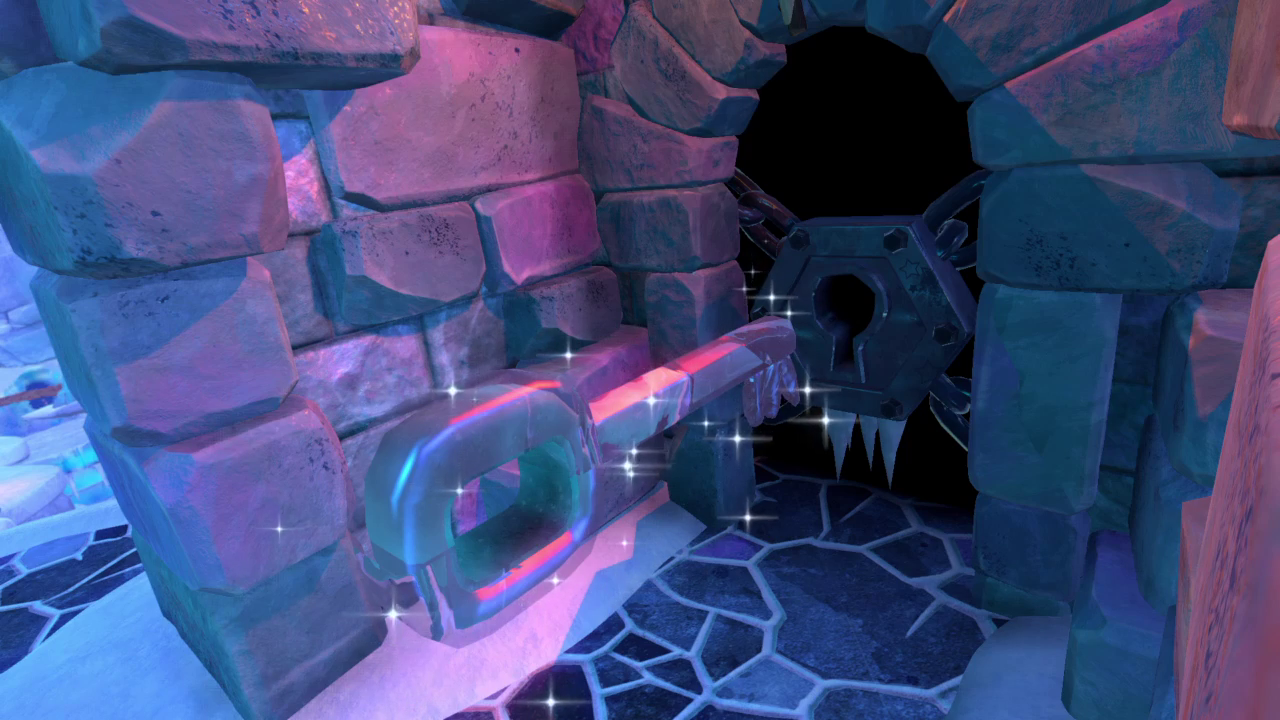
![]()
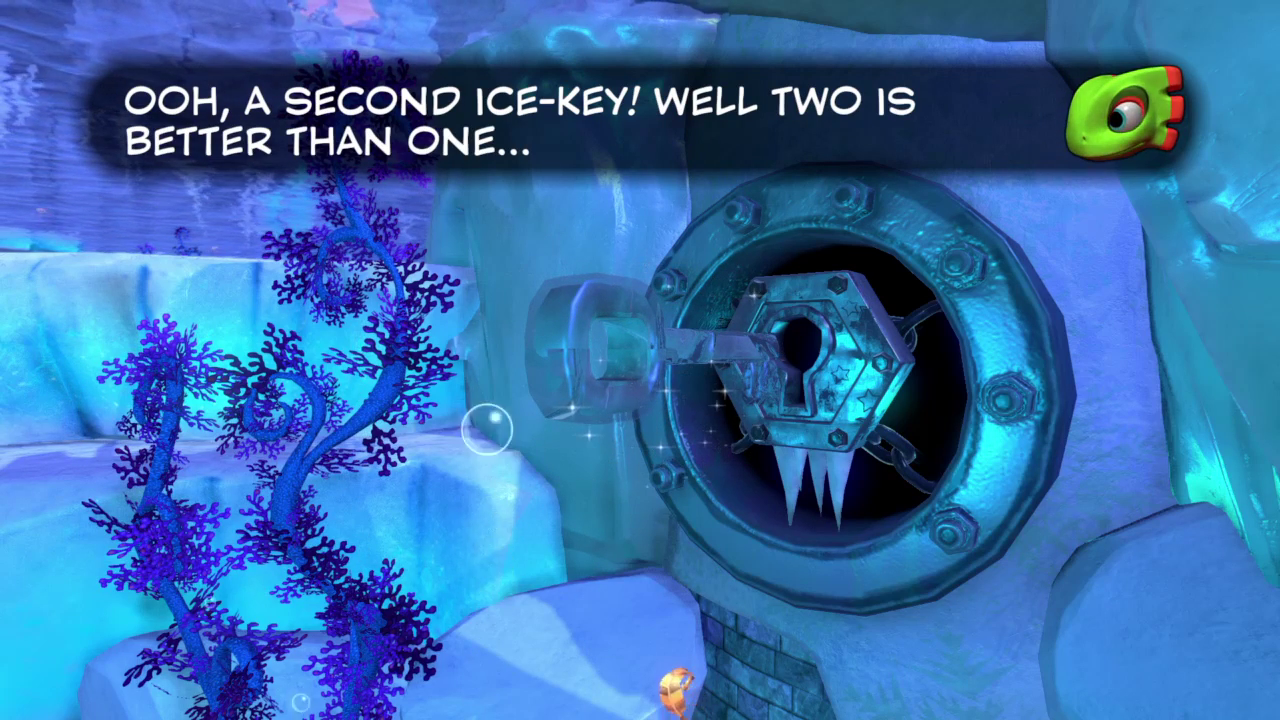
![]()
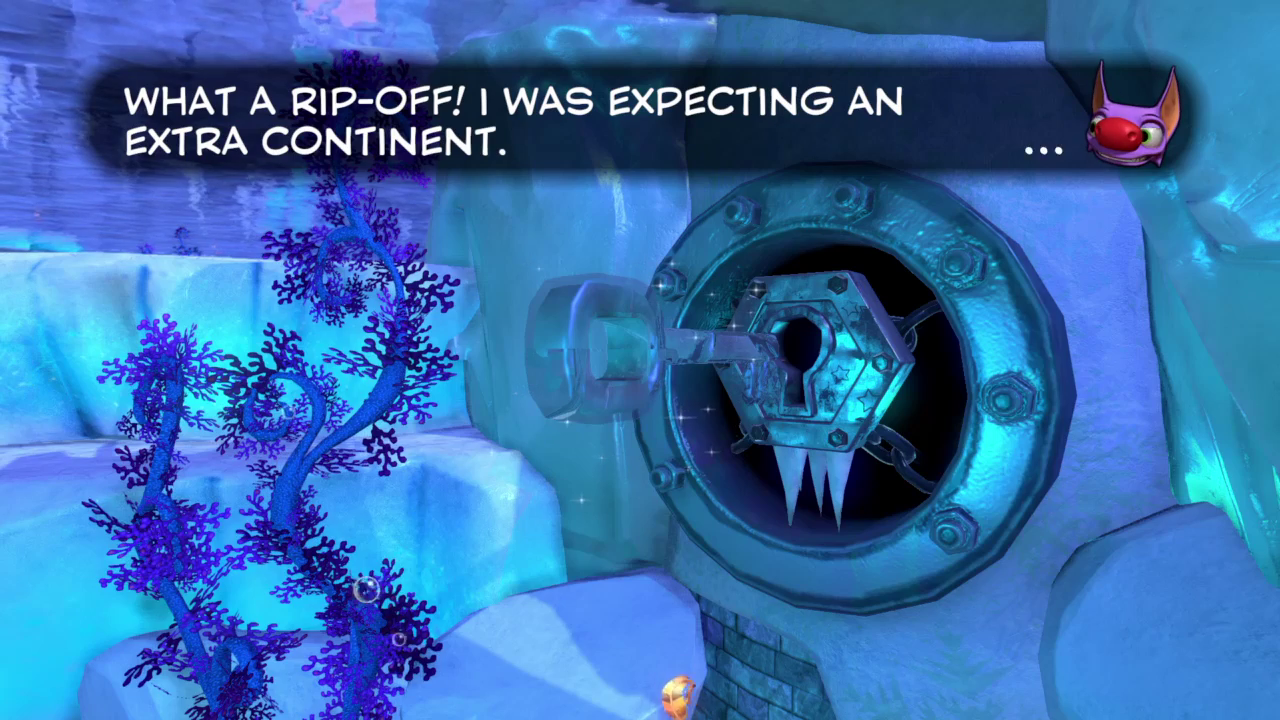
![]() [View Fullsize Image]
[View Fullsize Image]![]() [View Fullsize Image]
[View Fullsize Image]![]() [View Fullsize Image]
[View Fullsize Image]
Released in 2018, Rare’s piratical adventure game, Sea of Thieves would also feature a reference to Stop ‘N’ Swop for purchase in their Pirate Emporium.
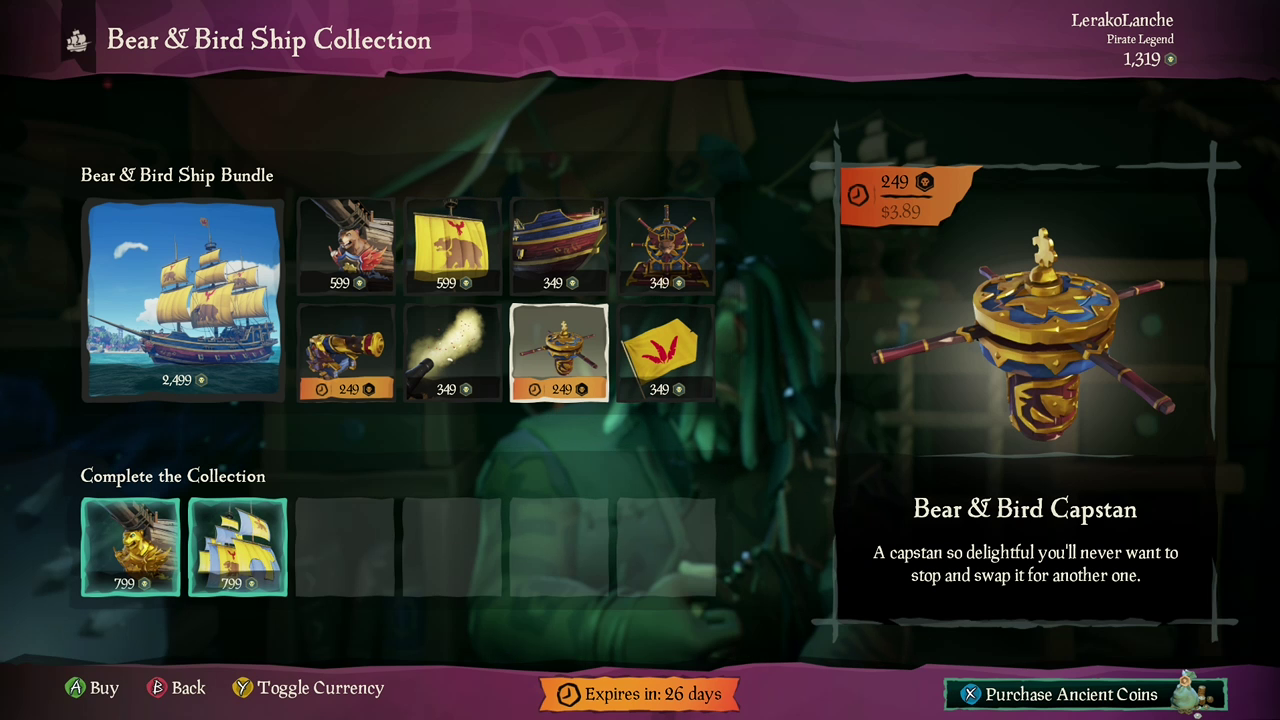
![]()
Ambitious swashbucklers that had managed to amass enough Ancient Coins would have the opportunity to acquire the “Bear & Bird Ship Collection”; a cosmetic overhaul that would emblazen their ships with a Banjo-Kazooie theme. While it’s offered as a bundle, each item in the collection can be purchased à la carte, with flavor text underneath each addition. Selecting the Bear & Bird Capstan in this manner will reveal a cheeky allusion to the feature, as it reads,
“A capstan so delightful you’ll never want to stop and swap it for another one.”
CONCLUSION TO STOP ’N’ SWOP
REMAINING UNSOLVED MYSTERIES AND AFTERWORD
In nearly two decades after Banjo-Kazooie had been released, we’ve made considerable headway into understanding the breadth and scope of Stop ’N’ Swop. In the time that we first laid eyes on the Ice Key distant and unobtainable we’ve discovered the process that cartridge swapping was to entail, and we’ve learned that the feature was meant to encompass the Rare titles outside of the Banjo series.
There is still much we can learn however, as our knowledge does seat unavoidable gaps that lead to speculation and uncertainty. For instance, the contents of the Mystery Eggs remain just that – were Breegul Bash, Homing Eggs, Multiplayer Jinjo and Dragon Kazooie intended as the principle rewards from Banjo-Tooie since its inception, or were these rewards effectively replacements when it was clear that Stop ’N’ Swop would not be viable? For that matter, what were the other Mystery Eggs meant to house? Activating a secret level with the feature does seem a little too ambitious as Grabbed by the Ghoulies had teased, but the tangible bonuses that would have been obtainable otherwise are still very much unknown.
What is certain however is that Stop ’N’ Swop (and later Stop ’N’ Swop II) did achieve its original intention – and although the proposed method of memory transfer didn’t meet that end, the enduring mysteries and discoveries provided by the remnants found in Rare’s titles have kept interest in the Banjo-Kazooie games alive. Behind the elements of cartridge swapping and Mystery Eggs and Ice Keys, the entire purpose of Stop ’N’ Swop was made clear in the patent description as a “need for a system that prolongs the useful life of video games, and thus video game cartridges or other storage media, by maintaining a player’s interest in the game.”
Whether your first experience of the Banjo-Kazooie series was during its heyday in 1998, it’s Xbox Live Arcade rendition in 2008, or its inclusion in Rare’s masterpiece compilation Rare Replay in 2015, Stop ’N’ Swop has endured alongside the Bear and Birds adventures, drawing players in with its curious addition of a spinning Ice Key and several colored Mystery Eggs.